The cannabis plant is plagued by more than 200 diseases and pests. Diseases are caused by bacteria, fungi, nematodes, viruses, other plants, environmental stress, genetics, and pollutants. Pest insects, mites, mollusks, animals, and many diseases are ushered in by poor sanitation procedures in the garden or garden area.
The most common diseases include powdery mildew, bud rot, and damping-off. Spider mites are by far the most common pest found indoors, and fungus gnats are second. Outdoors and in greenhouses, corn earworms are most destructive. However, other large pests such as mice, squirrels, and wild pigs can cause serious damage.
Most diseases and pests can be avoided by using simple sanitary precautions in the garden. Constant monitoring of foliage and garden area is essential to catch any infestations in their infancy.

To prevent transmission of diseases, wash hands before and after entering or exiting the garden room.
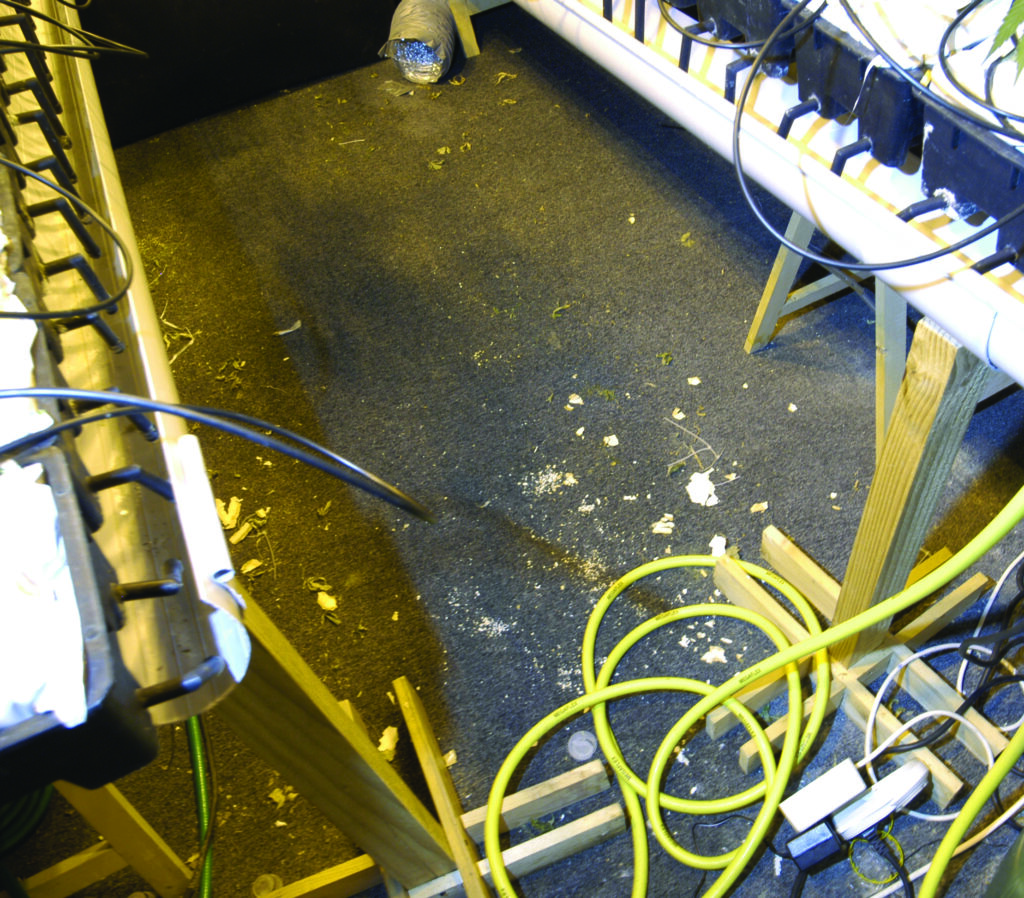
Keeping the garden room clean helps prevent cultural and maintenance problems.
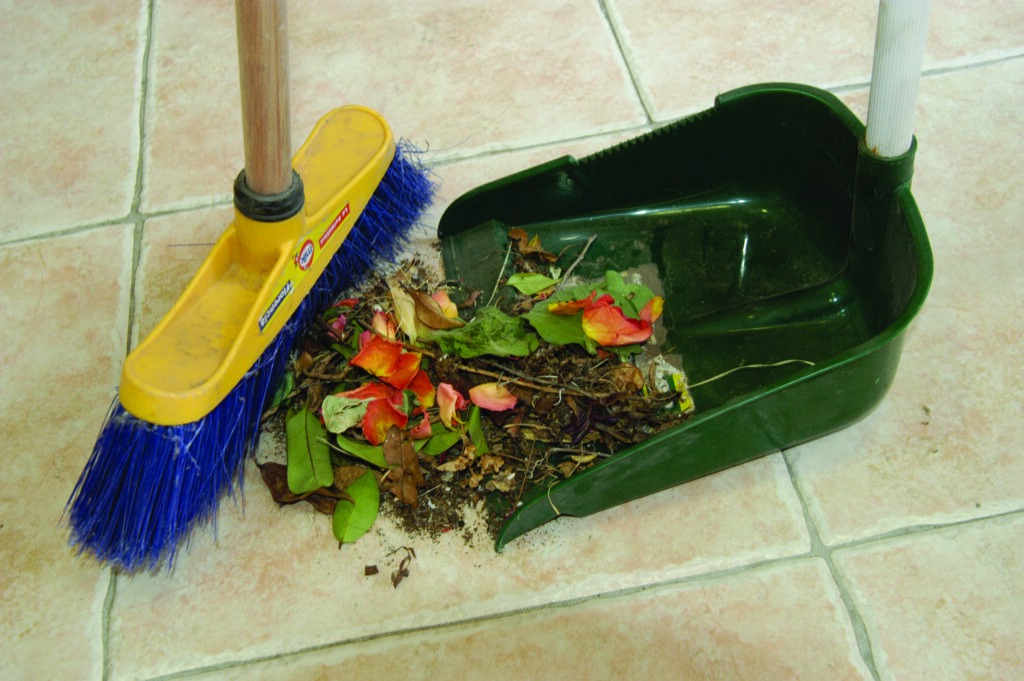
Immediately sweep up any debris on the garden room floor.
Cleanliness and Prevention
Diseases and pests of all kinds can sneak into garden rooms, greenhouses, and outdoor gardens. Some are airborne, others hitch a ride on plants, tools, or gardeners. They will come in and make themselves at home if you let them.
Insects, mites, and maggots slither into garden rooms to eat and reproduce— wasting cannabis. Outdoors, they live everywhere they can. Indoors, they live anywhere you let them. Fungi are present in the air at all times. They may be introduced by an infected plant or from air containing fungus spores. Fungi will settle down and grow if climatic conditions are right. Pests, fungi, and diseases can be prevented, but if allowed to grow unchecked, extreme control measures are often necessary to eradicate them.
Wear latex gloves, and regularly dip into a sanitizing agent. Use disinfectant-filled footbaths to prevent carrying pathogens on boots and shoes into the garden room. Disinfect pruning tools and knives. Do not smoke in the garden. Do not work in the garden if foliage is wet. Keep garden room and greenhouse floors clean.
Keep outdoor gardens tidy, and always remove debris from soil surface. Insects and fungi like nice hideaway homes found in dirty, dank corners and under decaying leaves or rotting mulch. Indoors and in greenhouses, use clean mulch such as expanded clay pellets or plastic. Outdoors, straw is the best all-around mulch.
Gardeners and their tools often transport microscopic pests, diseases, and fungi into the cannabis garden. To prevent problems, take regular sanitary precautions. Wearing clean clothes and using clean tools reduces problems considerably. A separate set of indoor and greenhouse tools are easy to keep clean. Pests, diseases, and fungi habitually ride from plant to plant on dirty tools. Disinfect tools by dipping in rubbing alcohol or washing with soap and hot water after using them on a diseased plant. Another quick way to sterilize pruners is with a handheld torch. A quick heating with the torch will sterilize metal tools immediately.
Personal cleanliness is fundamental to preventing diseases and pests. Wash your hands before touching foliage and after handling diseased plants. Smart growers do not walk around the buggy outdoor garden and then visit the indoor garden without taking precautions. Think before entering the indoor garden or greenhouse and possibly contaminating it. Stay away from outdoor diseases and pests such as a rust-covered lawn, and indoors stay away from spider mite– infested houseplants. Avoid problems by washing your hands and changing shirt, pants, and shoes before entering a clean indoor cannabis garden. Smokers should be especially careful to clean up and change clothes before entering gardens.
Once a crop has been grown in potting soil or soilless mix, throw out the used growing medium. Some growers brag about using the same old potting soil over and over, unaware that this savings is repaid with a diminished harvest. Used soil may harbor harmful diseases and pests that have developed immunity to sprays. Starting a new crop in new potting soil will cost more up front but will eliminate many potential problems. Used soil makes excellent outdoor garden soil.
Once potting soil is used, it loses much of the fluff in its texture, and compaction becomes a problem. Roots penetrate compacted soil slowly, and there is little room for oxygen, which restricts nutrient uptake. Used potting soil is depleted of nutrients. A plant with a slow start is a perfect target for disease, and worst of all, it will yield less! Companion planting helps discourage insects outdoors. Pests have nowhere to go indoors, so companion planting is not viable in garden rooms.
Plant insect- and fungus-resistant varieties of cannabis. If buying seeds from one of the many seed companies, always check for disease resistance. If you live in one of the medical cannabis states, you can actually ask local gardeners and other medical patients without being subject to legal penalties.
In general, Cannabis indica is the most resistant to pests, and C. sativa is more resistant to fungal attacks. Choose mother plants that you know are resistant to diseases and pests. Keep plants healthy and growing fast at all times. Disease attacks sick plants first. Strong plants tend to grow faster than diseases and pests can spread. However, a balance must be struck in order to avoid the excess nitrogen and softer tissue due to fast growth.
Carefully remove and destroy dead leaves. Wash your hands after handling diseased foliage. If the problem attacks one or a few plants, isolate and treat them separately. Diseases can spread like wildfire if the conditions are right. If disease gets a good start even after all preventive measures are taken, extreme control methods may be necessary, perhaps even spraying the entire garden with the proper fungicide.
prevention
healthy atmosphere for plants
cleanliness
low humidity
ventilation
removal
copper, lime sulfur sprays
specific fungicide
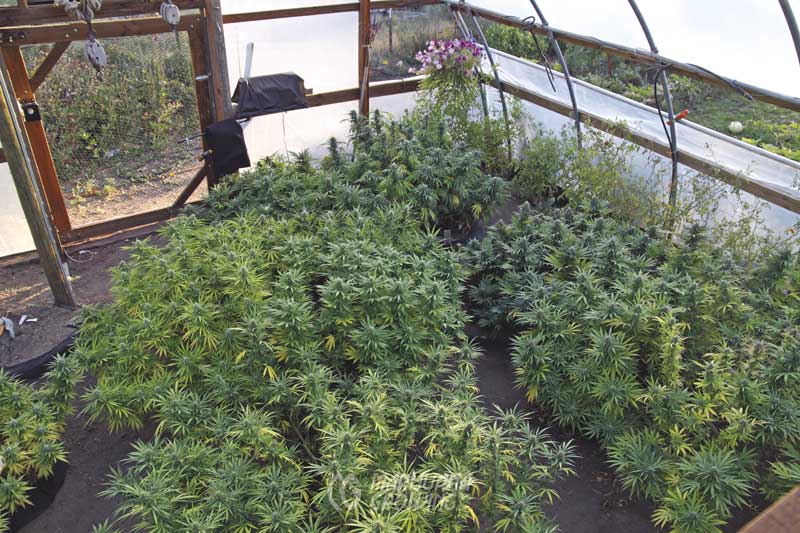
The best approach to disease and pest control is a healthy garden that is easy to maintain and offers a pleasant working environment.
Diseases
This chapter approaches disease and pest control by first encouraging gardeners to grow strong, healthy gardens and to keep all medical cannabis paperwork in order.
Fungi do not produce green chlorophyll, and they reproduce by spreading tiny microscopic spores rather than seeds. Countless fungal spores are present in the air at all times. When these microscopic airborne spores find the proper conditions, they will settle, take hold, and start growing. Some fungi, such as bud-rotting gray mold (Botrytis), are so prolific that they can spread through an entire crop in a matter of days!
Unsterile, soggy soil coupled with humid, stagnant air provides the environment most fungi need to thrive. Although there are many different types of fungi and related diseases, they are usually prevented with similar methods.
Anthracnose
Fungus
Common names: anthracnose, leaf blight, leaf shoot, brown blight
Specific diseases that cause anthracnose include: anthracnose (Colletotrichum coccodes = C. atramentarium Taubenhaus = C. dematium)
Threat to garden: low to medium
Identify: Leaves show first symptoms when they turn light green. Soon, sunken water-soaked spots that grow into irregular shapes develop grayish centers with dark borders. Stems develop white
wounds that turn black. Little black and white dots soon develop in wounds. Stems may develop cankers. This disease is worst during cool, damp weather (especially in clay and bog soils) and when plants are stressed (especially in hydroponic systems). Anthracnose is not transmitted in seeds but can be found on seed surfaces.
Damage: Anthracnose slows growth and diminishes harvest. It is occasionally fatal.
Cause: Anthracnose is caused in cannabis by three species of Colletotrichum fungi. Colletotrichum atramentarium also causes anthracnose. Brown blight (anthracnose) is caused by Alternaria and Stemphylium. Fungi overwinter in plant debris or soil, and start to grow in the spring.
Prevention: Sanitation is the best prevention. Remove plant residues. When pruning, make clean cuts with sharp, sterile tools to keep wounds clean. Use new soil, and avoid underwatering or overwatering. Avoid planting in clay soils, or amend clay soils to improve drainage. Do not wet foliage and stems when watering.
Control: Trichoderma harzianum (Trichodex) controls anthracnose. Sulfur or copper powders or sprays applied weekly as soon as the disease is identified will keep spores from spreading, but they will not kill the disease. Look for contact fungicides that contain chlorothalonil. There are many systemic fungicides that kill anthracnose.
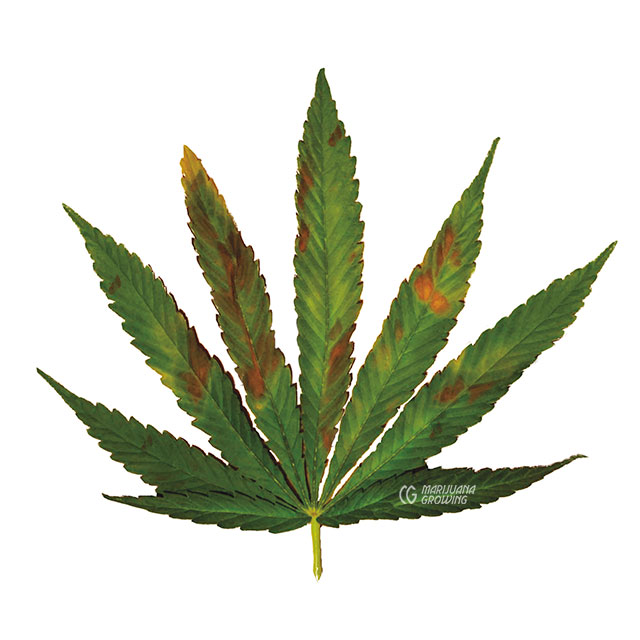
Anthracnose
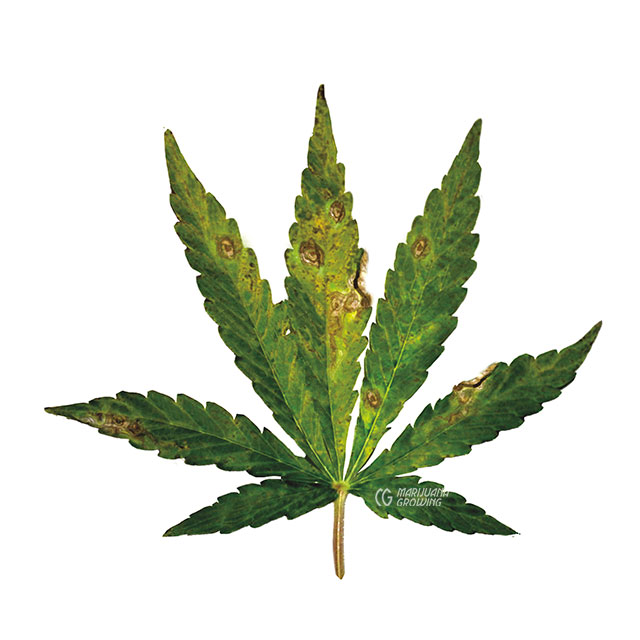
Blight
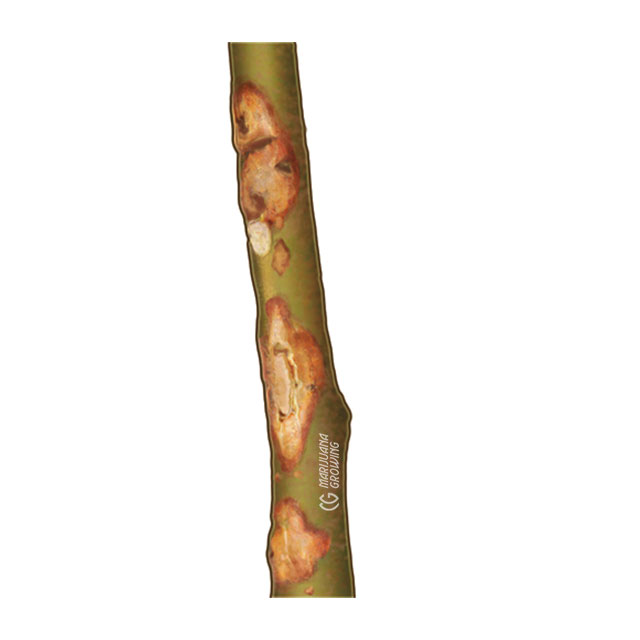
Canker
Blights
Fungal disease
Common names: brown blight, southern blight, twig blight
Specific diseases that cause blight include: bacterial blight (Pseudomonas syringae pv. cannabina) Cylindrosporium blight (Cylindrosporium spp., C. cannabinum Ibrahimov) Leptosphaeria blight (Leptosphaeria cannabina, L. woroninii, L. acuta) brown blight (Alterneria alternata = A. tenuis) southern blight (Sclerotium rolfsii), Sclerotium root and stem rot (Athelia rolfsii [teleomorph]) twig blight (Dendrophoma marconii, Botryosphaeria marconii [teleomorph])
Threat to garden: low to medium
Identify: Blight is a general term that describes many plant diseases that are caused by fungus, most often a few weeks before harvest. Signs of blight include discolored leaf tips; dark, blotchy spots on foliage; slow growth; sudden yellowing; wilting; and plant death. Most blights spread quickly through large areas of plants.
Damage: kills leaves, slows growth, and kills plants
Cause: unsanitary garden room conditions; infected soil, air or plant tissue is introduced into the garden
Prevention: Cleanliness! Use fresh, sterile growing medium. Avoid excess nitrogen fertilization. Avoid blights by keeping plants healthy with the proper nutrient balance and good drainage to prevent nutrient buildup.
Biological: Use Serenade (Bacillus subtilis) against brown blight. Use Binab, Bio- Fungus, RootShield, Supresivit, Trichopel, (Trichoderma harzianum) or SoilGuard (Trichoderma virens). Use a Bordeaux mixture to stop fungal blights. Stopping blights in advanced stages is difficult; the best solution is to remove diseased plants and destroy them.
Control: Once blight takes over plant tissue, little can be done. Remove plants from the garden and sterilize the area to avoid contamination.
Canker
Fungal disease
Common names: stem canker, hemp canker
Specific diseases that cause canker include: Cladosporium stem canker (Cladosporium cladosporioides, C. herbarum, Mycosphaerella tassiana [teleomorph])hemp canker (Sclerotinia sclerotiorum)Ophiobolus stem canker (Ophiobolus cannabinus, O. anguillidus) Phoma stem canker (Phoma herbarum, P. exigua) Phomopsis stem canker (Phomopsis cannabina, P. achilleae, Diaporthe arctii var. achilleae [teleomorph])
Threat to garden: low
Identify: The first water-soaked wounds appear on maturing stems and branches. They develop into dark cankers that continue to deepen, and fungus invades the plant. Finally, the black-hearted disease continues to grow on dead stems.
Damage: Hemp canker, mainly a fiber hemp disease, occasionally affects medicinal cannabis.
Cause: present in soil or unsterile, tainted soil
Prevention: Use fresh soil or growing medium for each crop. Keep garden and garden area clean. Remove all plant residues from soil surface. Compost by using a big pile and high temperatures.
Control: Best to prevent hemp canker. All chemical controls are systemic. Once disease takes over, it is often too late. Contans WG contains Coniothyrium minitans bacteria, a parasite to S. sclerotiorum.
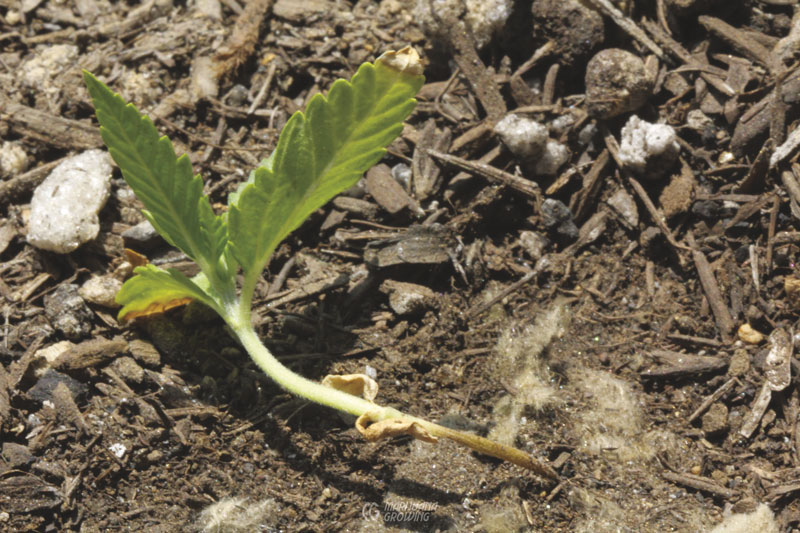
Damping-off hit this seedling before it developed true leaves. (MF)
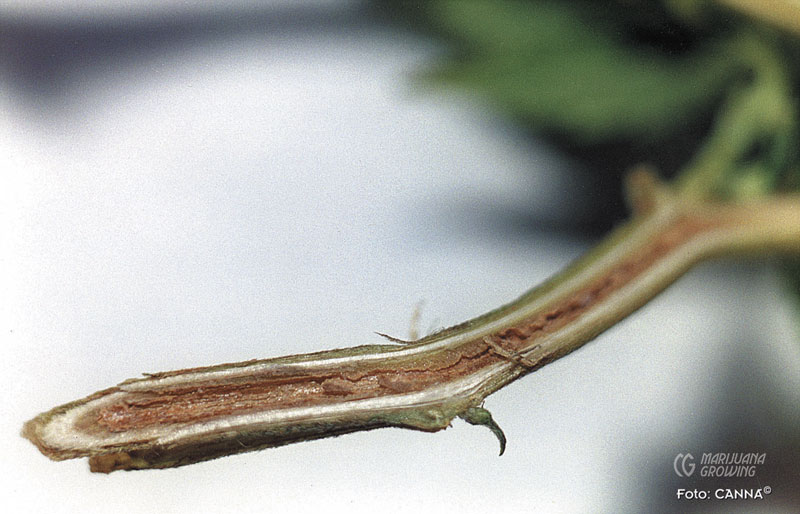
Cut the stem of an infected plant to find evidence of Fusarium
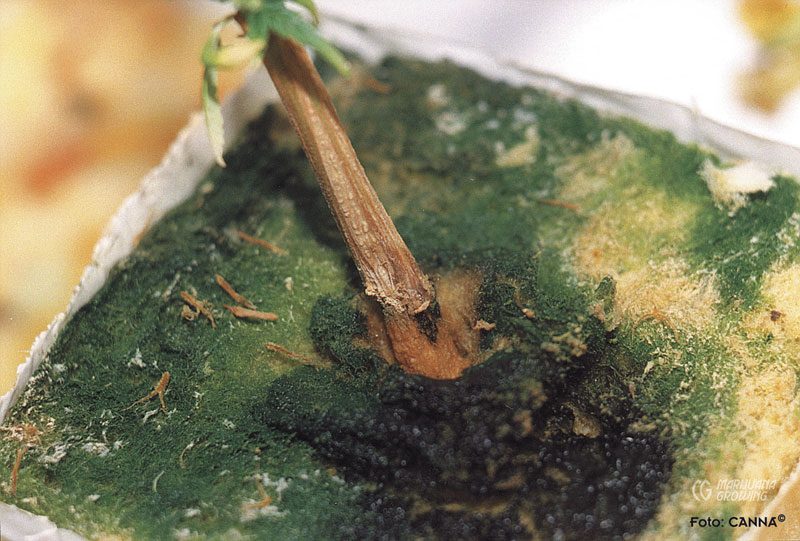
Fusarium wilt destroyed this plant.
Damping-Off
Fungus: kills seeds, seedlings, and clones
Common names: damping-off, stem rot, moldy germination, young plant disease
Specific diseases that cause damping-off include: (Botrytis cinerea, Botryotinia fuckeliana [teleomorph], Fusarium oxysporum, F. solani, Nectria haematococca [teleomorph], Macrophomina phaseolina, Pythium aphanidermatum, P. debaryanum auct., P. ultimum, Rhizoctonia solani, Thanatophorus cucumeris [teleomorph] = Pellicularia filamentosa).
Threat to garden: High threat to seedlings! See “Gray Mold (Botrytis cinerea, aka Bud Mold): Stems, Flower Buds.”
About: Damping-off is a catchall term; the disease has many causes.
Identify: There are two kinds of damping-off: one kills seeds when they germinate and before they break through the soil; the second type, post/ emergence damping-off, is the rotting or wilting of seedlings soon after they emerge from the soil. Succulent stems have become water-soaked and then necrotic and develop a sunken, zone at ground level. The little herbaceous plants fall over on the ground. Root decay follows.
Damage: Damping-off attacks rooting cuttings at the soil line if present in growing medium. As the fungi invade stem tissue, the stem loses girth at the soil line, weakens, and then discolors with a brown, watery soft rot. Finally, fluid circulation is cut, killing the seedling or cutting. Damping-off prevents newly sprouted seeds from emerging and attacks seedlings, causing them to rot at the soil line; it yellows foliage and rots older plants at the soil line.
Cause: Various fungal species, including Botrytis, Pythium, and Fusarium, are present in the air, growing medium, plant, or seed. This disease breeds in humid conditions and in poorly aerated, overwatered growing mediums. It attacks weak plants.
Prevention: Control soil moisture. Overwatering is the main precursor to damping-off. Careful daily scrutiny of soil will ensure that the proper amount of moisture is available to seeds or cuttings. Germinate seeds between clean, fresh, moistened paper towels and move seeds to soil once sprouted. Do not plant seeds too deeply; cover with soil one and a half times the width of the seed. Use fresh, sterile growing medium and clean pots to guard against harmful fungus in the soil. Start seeds and root cuttings in a fast-draining, sterile coarse sand, rockwool, Oasis, or Jiffy cubes, which are difficult to overwater. Set them on a grate or surface that readily drains. Do not place a humidity tent over sprouted seedlings—a tent can lead to excessive humidity and damping-off. Damping-off is inhibited by bright light; grow seedlings under the HID rather than fluorescent bulbs. Keep fertilization to a minimum during the first couple of weeks of growth.
Seeds: Coating the seed with protective dust is a form of insurance. Seed disinfection is used to kill organisms of anthracnose and other diseases carried on seed. Damping-off organisms are in the soil, not on the seed. The coating is intended to kill or inhibit fungi in the soil immediately surrounding the seed and so provide temporary protection during germination.
Cuttings: Cuttings are less susceptible to damping-off and love a humidity tent to promote rooting. Keep germination temperatures between 70ºF and 85ºF (21.1ºC–29.4ºC).
Control Biological: Apply Polygangron (Pythium oligandrum) granules to soil and seed. Bak Pak or Intercept is applied to the soil and Deny or Dagger—forms of the bacterium Burkholderia cepa-cia—is put on the seeds. Epic, Kodiac, Quantum 4000, Rhizo-Plus, System 3, and Serenade also suppress many causes of damping-off.
Chemical: Dust the seeds with Captan. Avoid benomyl fungicide soil drench because it kills beneficial organisms.
Fusarium Wilt
Fungal root disease
Common names: Fusarium, stem canker, Fusarium wilt
Specific diseases that cause Fusarium wilt include: Fusarium foot rot and root rot (Fusarium solani) Fusarium stem canker (Fusarium sulphureum, Gibberella cyanogena [teleomorph], = G. saubinetii) Fusarium wilt (Fusarium oxysporum f.sp. cannabis, F. oxysporum f.sp. vasinfectum)
Threat to garden: medium to high
Identify: Fusarium wilt is most common in warm garden rooms and greenhouses. Fusarium starts as small spots on older, lower leaves. Interveinal leaf chlorosis appears swiftly. Leaf tips may curl before wilting and suddenly drying to a crisp. Portions of the plant or the entire plant will wilt. The entire process happens so fast that yellow, dead leaves dangle from branches.
Damage: This disease starts in the plant’s xylem, the base of the fluid transport system. Plants wilt when fungi plug the fluid flow in plant tissue. Cut one of the main stems in two, and look for the telltale reddish-brown color.
Cause: The water and nutrient solution carries this disease with it when contaminated. The disease is present in the room, growing medium, or plants. Recirculating nutrient solutions above 75ºF (24ºC) creates perfect conditions for Fusarium. It is also spread by contaminated plants, cuttings, etc. Fusarium can also enter via the root system.
Prevention: Cleanliness! Use fresh, clean growing medium. Avoid nitrogen overfertilization. Preventive action is necessary. Keep nutrient solution below 75ºF (23.9ºC). Hydrogen peroxide kills bacteria and will also arrest Fusarium. Always remove and destroy infested plants.
Biological: Mycostop (Streptomyces griseoviridis), or Deny, or Dagger (Burkholderia cepacia) and Trichoderma.
Control Sprays: Treat seeds with chemical fungicides to eradicate the seed-borne infection. Chemical fungicides are not effective on foliage. A metal spray such as copper or zinc helps by making the leaf environment more difficult to penetrate. If there is any root rot, do not spray vitamins onto the plants. Vitamins around roots may strengthen the fungus that is attacking your plant. If mold or fungal attacks appear on leaves discontinue sprays and foliar feedings. Aboveground indications of root rots are difficult to distinguish from wilt diseases. The three most important wilt diseases include Fusarium wilt that is caused by two forms of Fusarium oxysporum, Verticillium wilt that is caused by two Verticillium species, and premature wilt (aka charcoal rot) caused by Macrophomina phaseolina.
Note: Fusarium oxysporum has been studied and genetically modified to create a “mycoherbicide” or an “attack” fungus that preys on cannabis. To the best of my knowledge, the attack fungus has not been released.
Gray Mold (Botrytis cinerea, aka Bud Mold)
Fungal disease Disease/fungi/bacteria/microbe/virus/ pathogen/contaminant
Common names: bud mold, stem rot, bud rot
Specific disease that causes damping-off: Botrytis cinerea
Threat to garden: very high
Identify: Gray mold is the most common fungus that attacks indoor plants and flourishes in moist, temperate climates common to many garden rooms. It attacks seedlings, clones, stems, buds, and stored cannabis.
Seeds/seedlings, clones: see “Damping-Off”
Stems: Gray mold arises as a gray-brown to blackish mat of fungus and fungal spores. Stems yellow at margins of infection. Soft cankers develop that may cause stems to snap. When advanced, the entire stem dies above the infection.
Damage: Gray mold slows growth, diminishes harvest, could cause plant death, and infects other plants. Prevention and control: the same as for flower buds
Flower buds: Bud leaflets yellow and wilt, and pistils brown. Inside the bud— where it is difficult to see at the onset, and is grayish-whitish to bluish-green in color—Botrytis appears hairlike and similar to laundry lint in moist climates. Entire buds become enveloped in a fuzzy gray mold that morphs into gray-brown slime. Damage can also appear as dark, brownish spots on buds in less humid environments. Dry to the touch, the Botrytis-affected area often crumbles if rubbed. Constant observation, especially during the last two weeks before harvest, is necessary to keep this disease out of the garden.
Damage: Single leaves that mysteriously dry out on the buds. They could be the telltale signs of a Botrytis attack inside the bud. Flower buds are quickly reduced to slime in cool, humid conditions or unsmokable powder in warm, dry rooms. Botrytis can destroy an entire crop in seven to ten days if left unchecked. Stem damage—Botrytis starts on stems and not buds—is less common indoors. First, stems turn yellow, and cankerous growths develop. The damage causes growth above the wound to wilt and can cause stems to fold over. Transported by air, contaminated hands, and tools, gray mold spreads very quickly indoors, infecting an entire garden room in less than a week when conditions are right. I saw Botrytis destroy an entire greenhouse in Switzerland in two weeks.
Cause: Caterpillars, wounds, humidity, and dense flowers all factor as causes of gray mold. Airborne spores are present virtually everywhere as gray mold attacks many plants. It is also transmitted via seeds. Botrytis damage is compounded by humid (above 50 percent) climates. In temperate regions with high humidity (60 to 70 percent) and low temperatures, Botrytis can completely destroy a hemp crop within a week.
Prevention: Keep the garden room, tools, and yourself clean. Do yourself a favor and start with clean growing medium! Buy clean medium or treat with steam or electricity. Remove lower leaves and improve air circulation between plants. Grow disease-resistant varieties. Dense, tightly packed, moisture-retaining buds of Cannabis afghanica are the most susceptible to gray mold. Some afghanica varieties came from arid climates and have no resistance to gray mold.
Minimize Botrytis attack incidence with low humidity (50 percent or less), ample air circulation, and ventilation. Grow varieties that do not produce heavy, tightly packed buds that provide a perfect place for this fungus to flourish. Cool (below 70ºF [21.1ºC]), moist climates with humidity above 50 percent are perfect for rampant gray mold growth. Many crosses are more resistant to gray mold than pure indica varieties.
Remove dead leaf stems, petioles, from stalks when removing damaged leaves to avoid Botrytis outbreaks, which is often harbored by dead, rotting foliage. Increase plant spacing, and air circulation between plants. Increase ventilation, keep humidity below 60 percent, and keep the garden room clean! Use fresh, sterile growing medium for each crop. Water when the lights go on so water does not sit all night. Mulch plants to avoid water splashing from soil onto leaves.
Excessive nitrogen and phosphorus levels make foliage tender, letting Botrytis can get a foothold. But higher levels of calcium lower the incidence of Botrytis. Make sure pH is around 6.0 to facilitate calcium uptake. Low light levels also encourage weak growth and gray mold attack. Keep the light levels bright. Botrytis needs UV light to complete its life cycle; without UV light it cannot live.
Control
Cultural and physical control: As soon as Botrytis symptoms appear, use alcohol-sterilized pruners to remove Botrytis-infected buds at least one inch (2.5 cm) below the infected area. Do not let the bud or anything that touches it contaminate other foliage. Remove it from the garden and destroy it. Wash hands and tools after removing infect-ed buds. Increase temperature to 80ºF (26.7ºC) and decrease humidity to below 50 percent.
Biological: Spray plants with Gliocladium roseum and Trichoderma species. Prevent damping-off with a soil application of Gliocladium and Trichoderma species. The Hemp Diseases and Pests book suggests experimenting with the yeasts Pichia guilliermondii and Candida oleophila or the bacterium Pseudomonas syringae.
Sprays: Fixed copper (copper hydroxide, copper oxide, copper oxychloride), copper sulfate, hydrated lime, lime sulfur, and elemental sulfur keep early stages of Botrytis in check as long as it is present on the foliage. Preventive spraying is advised if in a high-risk area, but spraying buds near harvest time is not advised. Seeds are protected from Botrytis with a coating of Captan. Check with your local nursery or hydroponic store for product recommendations.
Sprays of calcium silicate (Ca-silicate, 2,000 ppm, a sealant for concrete and egg shells), (California) calcium bentonite (Ca-bentonite), and calcium formate (Ca-formate, 2,000 ppm) provide effective control of fungi and are safe alternatives to highly toxic fungicides. Potassium bicarbonate, baking soda, changes the pH of the surface of the foliage it contacts. Botrytis cannot grow there. AQ10, a microbial biofungicide that parasitizes powdery mildew, can control and even eliminate the disease. AQ10 will actually eliminate Botrytis when plants are no more than 3 percent infected. See “Sulfur Burners and Pests” under “Sulfur” in this chapter.
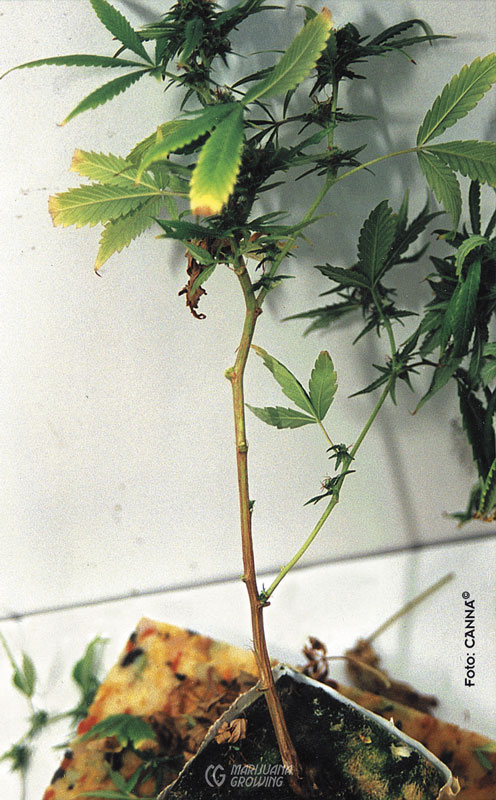
Cut the stem of an infected plant to find evidence of Fusarium
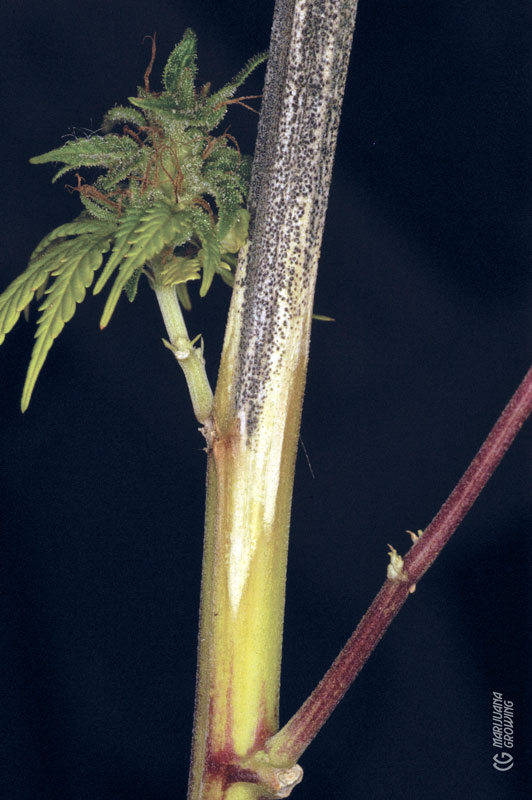
Botrytis is visible on this stem. It is killing all the growth.
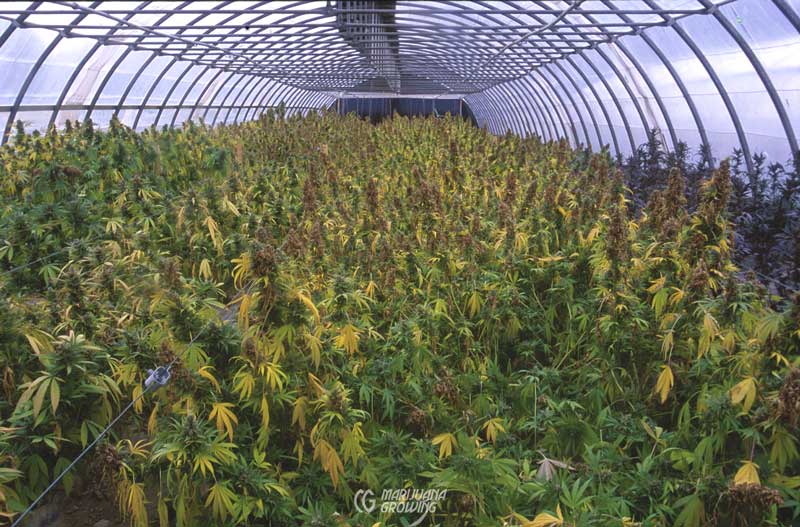
Botrytis cinerea spread through this entire greenhouse in about two weeks.
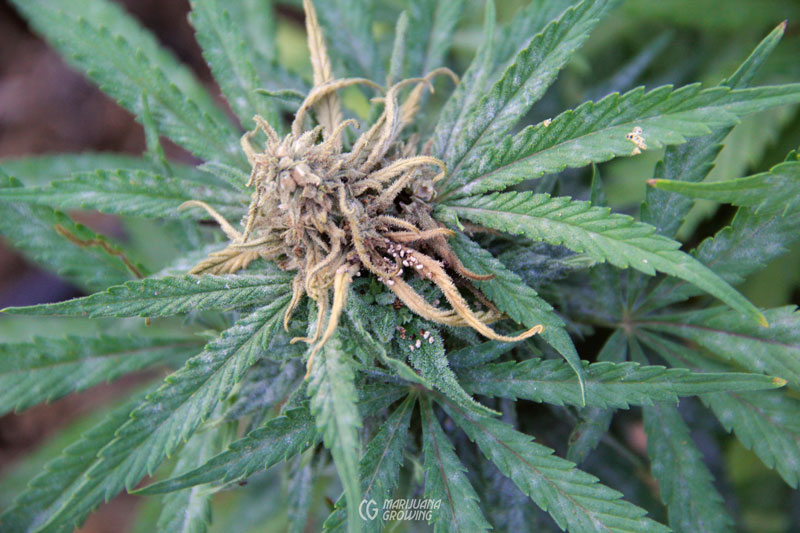
Botrytis cinerea attacked this flower bud.
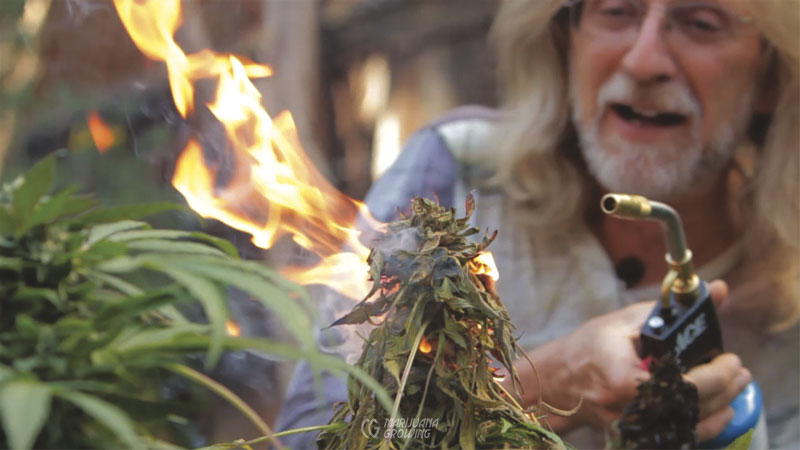
Flaming flowers is one of many ways to kill Botrytis in the garden. This method is very rewarding and also kills fungus spores.
Leaf Spot
Fungal and bacterial disease
Common names: brown blight, brown leaf spot, leaf spot root disease, Curvularia leaf spot, olive leaf spot, pink rot, tar spot, Stemphylium leaf and stem spot, white leaf spot, yellow leaf spot
Specific diseases that cause leaf spot include: brown leaf spot and stem canker (Ascochyta spp., A. prasadii, Phoma spp., Didymella spp. [teleomorph], P. exigua, P. glomerata, P. herbarum). Curvularia leaf spot (Curvularia cymbopogonis, C. lunata, Cochliobolus lunatus [teleomorph] olive leaf spot (Cercospora cannabis, Pseudocercospora cannabina) pink rot (Trichothecium roseum) Stemphylium leaf and stem spot (Stemphylium botryosum, Pleospora tarda [teleomorph], S. cannabinum) white leaf spot (Phomopsis ganjae) yellow leaf spot (Septoria cannabis, S. cannabina Peck) Alternaria alternata Keissler is a common fungal pathogen of some 380 different plants and seeds. The opportunistic pathogen causes leaf spot and other diseases.
Caution: Alternaria alternate Keissler also causes upper respiratory tract infections and asthma in people who are sensitive.
Threat to garden: These diseases rarely kill plants, but they do sharply reduce crop yields.
Identify: Leaf and stem fungi, including leaf spot, attack the foliage. Brown, gray, black, or yellow to white spots or blotches develop on leaves and stems.
Damage: Leaves and stems discolor and develop spots that impair plant fluid flow and other life processes. Spots expand over leaves, causing them to yellow and drop. Growth is slowed, harvest prolonged, and in severe cases, death results. Leaf spot is the symptomatic name given to many diseases.
Cause: Bacteria, fungus, and nematodes carry (vector) this disease. Spots or lesions caused by fungi often develop different colors as fruiting bodies grow. Leaf spots are often caused by cold water that was sprayed on plants under a hot HID. Temperature stress causes the spots that often develop into a disease. Viral pathogens are also a major cause of some leaf spots.
Cause: Leaf spot can be caused by (1) fungi already present in an unsterile rooting medium, (2) overwatering and maintaining a soggy growing medium, or (3) excessive humidity.
Prevention: Cleanliness! Use fresh, sterile growing medium with each crop. Move HIDs away from the garden canopy about 30 minutes before spraying, so plants won’t be too hot. Do not spray within four hours of turning the lights off, as excess moisture sits on the foliage and fosters fungal growth. Do not wet foliage when watering, avoid overwatering, and lower garden room humidity to 50 percent or less. Check the humidity both day and night. Employ dry heat to raise the nighttime temperature to five or ten degrees below daytime levels, and keep humidity more constant. Allow adequate spacing between plants to provide air circulation. Remove damaged foliage. Avoid excessive nitrogen application.
Control
Biological: Copper- and sulfur-based sprays may help keep leaf spots in check, but they are often phytotoxic when applied regularly indoors.
Sprays: Copper- and sulfur-based sprays. Many bacterial and fungal diseases can be controlled with Bacillus subtilis (Serenade).
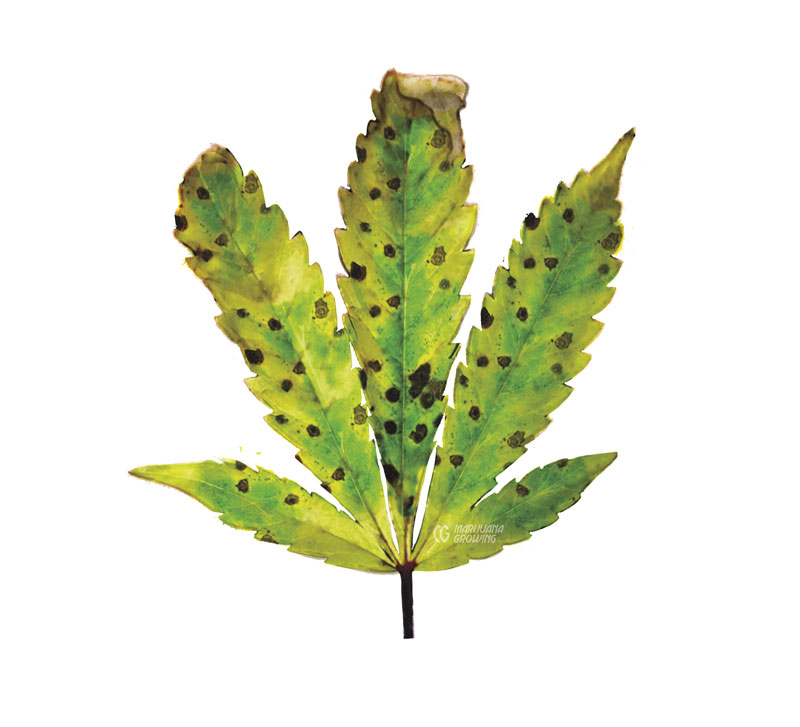
Leaf spot can be caused by many different problems. Once dead tissue appears on leaves, mold and fungus can take hold and grow.
Mildews
Fungal disease
Common names: black mildew, downy mildew, powdery mildew
Specific diseases that cause mildew include: downy mildew (Pseudoperonospora cannabina, P. humuli) black mildew (Schiffnerula cannabis) powdery mildew (Leveillula taurica, Oidiopsis taurica [anamorph], Sphaerotheca macularis, = S. humuli, Oidium sp. [anamorph])
Threat to garden: medium to very high
About: Mildews are called “powdery mildew” among cannabis growers. This term encompasses all mildews. Mildew grows on foliage, leaves, and buds. Most look like foliage was sprinkled with fine flour or talcum powder. Mildews drain the vigor of plants, and pose a health risk for some people when smoked.
Identify: The first indication of infection is small spots on the tops of leaves. Next, a powdery looking substance (flowering fungus) appears on foliage. At this point, the systemic disease has been inside the plant a week or more, and the disease can be only arrested by external treatments— but not eliminated. Spots progress to a fine, pale, gray-white powdery coating on growing shoots, leaves, and stems.
Damage: Powdery mildew is not always limited to the upper surface of foliage. Growth slows, leaves yellow, and plants die as the disease advances. Occasionally fatal indoors, this disease is at its worst when roots dry out and foliage is moist. Plants are infected for weeks before they show the first symptoms.
Cause: Mildew is caused by one of the many different species of fungi from the order Erysiphales. Spores are present in the air all the time. They find cool, moist garden rooms with poor circulation the perfect place to live.
Prevention: Once established, mildews must be eliminated from an empty garden room. They cannot be eliminated from plant tissue without the help of a systemic chemical. Cleanliness! Prevent this mildew by avoiding cool, damp, humid, dim conditions in the garden room, as well as fluctuating temperatures and humidity. Low light levels and stale air affect this disease. Increase air circulation and ventilation, and make sure light intensity is high. Space containers far enough apart so air freely flows between plants. Allow foliage to dry before turning off lights. Remove and destroy foliage more than 50 percent infected. Avoid excess nitrogen. Copper, sulfur-lime, and potassium bicarbonate sprays are good prophylactics.
Clones: If buying clones at a dispensary or if acquiring from friends, quarantine or isolate the clones for a week to see if they have powdery mildew and other diseases or pests before introducing them to the main plant population.
Sulfur products such as Safer’s Defender prevent powdery mildew on contact with foliage, but the disease is still inside the plant. Applying sulfur make the cannabis taste bad when smoked. It appears to concentrate on resins. Chimera, a cannabis breeder, does not recommend using sulfur on vegetative or flowering plants. He recommends using a sulfur burner in a room to kill all mildew when no plants are in the room.
Apply Serenade (Bacillus subtilis) or spray with a saturation mix of baking soda and water to kill surface contamination to keep the disease in check. Copper-based sprays may keep this mold in check. A saturation of baking soda spray dries to a fine powder on the leaf; the baking soda changes the surface pH of the leaf to 7.0, and powdery mildew cannot grow. An organic “systemic” called AquaShield is available from Botanicare, and it has had very favorable reports. A mixture of 10 to 20 percent milk and 80 to 90 percent water is also effective, but it smells bad.
Control: None. Destroy damaged plant material.
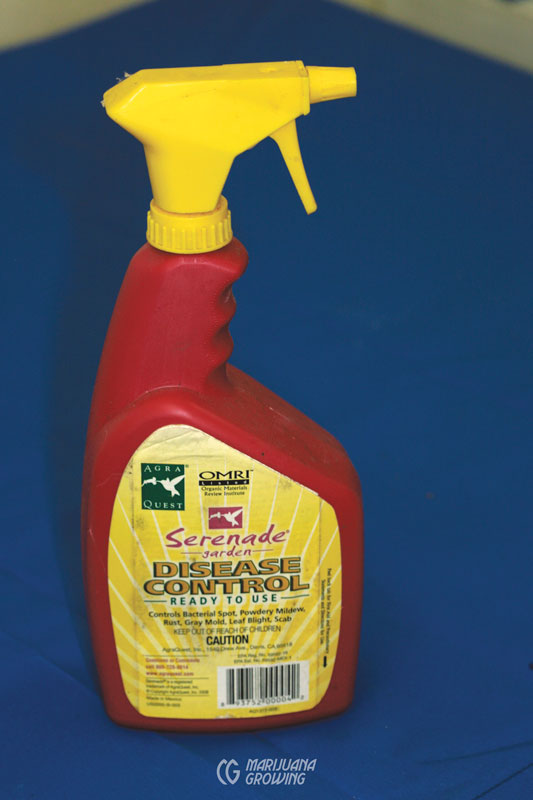
Serenade contains Bacillus subtilis, a powerful natural fungicide.
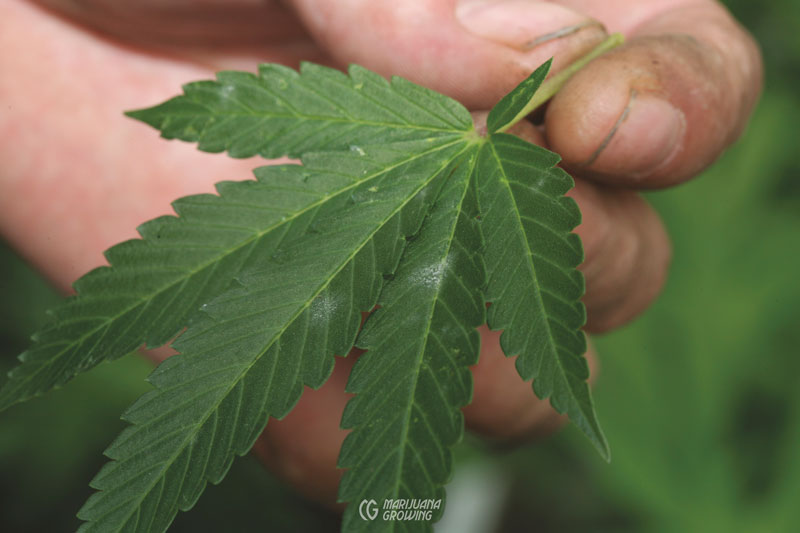
Mildews appear as a little bit of white powder on leaf suface.
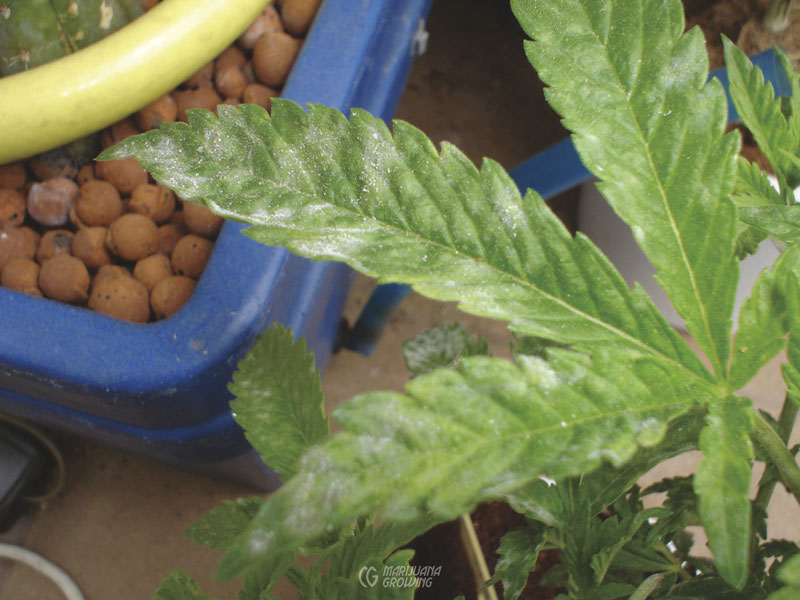
Soon powdery mildew enters plant tissue and spreads.
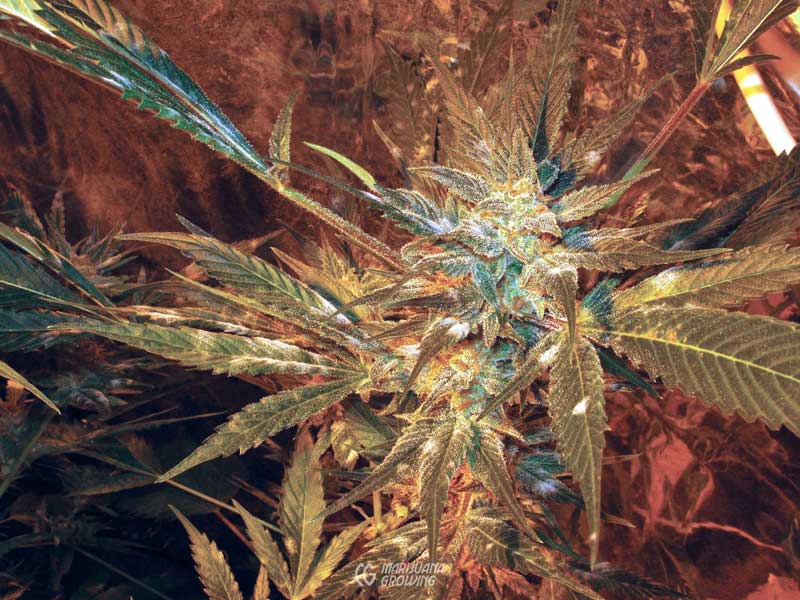
Powdery mildew has taken over this plant.
Root Rot
Fungal disease
Common names: root rot, soil rot
Specific diseases that cause root rot include: Phymatotrichum root rot aka cotton root rot (Phymatotrichopsis omnivore = Phymatotrichum omnivorum) pink rot (Trichothecium roseum = Cephalothecium roseum Corda) Rhizoctonia soreshin and root rot (Rhizoctonia solani Kühn) tropical rot (Lasiodiplodia theobromae = Botryodiplodia theobromae Pat)
Threat to garden: medium
Identify: Root rot disease is a catchall term for different fungal and pathogen root infections (see Pythium below). These rots cause roots to turn from a healthy white to light brown. As the rot progresses, roots turn darker and become slimy. Growth aboveground is slow. Leaf chlorosis is followed by wilting of the older leaves on the entire plant. When severe, rot progresses up to the base of the plant stock, turning it dark. Root rot is most common when roots are deprived of oxygen and allowed to stand in unaerated water. Soil pests that cut, suck, and chew roots create openings for rotting diseases to enter. Inspect roots with a 10× magnifying glass for signs of pest damage.
Damage: brown slimy roots, slow growth, damaged foliage, and a low yield
Cause: Many fungi cause root rot in cannabis including charcoal rot (Macrophomina phaseolina), tropical rot (Lasiodiplodia theobromae = Botryodiplodia theobromae), Rhizoctonia soreshin, and root rot (Rhizoctonia solani).
Prevention: Cleanliness! Use fresh, sterile growing medium. Make sure calcium levels are adequate, and do not overfertilize with nitrogen. Keep pH above 6.5 in soil and about 6.0 in hydroponic mediums to lower disease occurrence, except cotton rot, which likes a high pH. Control any insects, fungi, or bacteria that eat roots.
Biological: Binab, Bio-Fungi, RootShield, Supresivit, Trichopel (Trichoderma harzianum), or SoilGuard (Trichoderma virens).
Control: Once roots are more than half covered with rot, recovery will be very slow if at all. The best control is to toss out the plants. Completely sterilize and sanitize the garden after a bout with root rot.
Sprays: Sprays are not effective for root rot once damage is done.
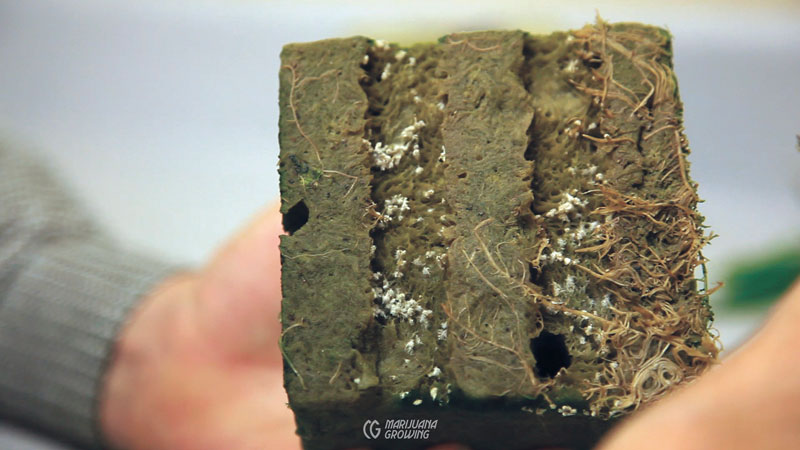
Root rot killed these roots.
Pythium
Plant parasites
Common names: Pythium wilt, Pythium, root rot, damping-off,
Specific diseases that cause root rot in cannabis include: Pythium irregulare, Pythium ultimum, and Pythium aphanidermatum
Threat to garden: high Identify: Pythium can be everywhere and it spreads easily. Infestations can wipe out an entire crop in a greenhouse or indoor garden. Pythium is a fungus-like organism that grows and colonizes a plant by producing hyphae (threadlike, filamentous cells) that suck nutrients from host cannabis plants and release enzymes that destroy root tissue. Pythium attacks cannabis roots, causes cutting rot, stem rot, and foliar blight under the right conditions. P. ultimum, has a very wide range of hosts. P. ultimum diseases occur most often at temperatures below 68°F (20ºC). P. aphanidermatum infections occur more often at temperatures above 77°F (25ºC).
Damage: First plants appear stunted and if you look at the root carefully you will see the tips are dead. The roots appear water-soaked and slimy. Seeds may be infested at germination. Stems of seedlings and cuttings may appear soft and watery. Root rot symptoms, regardless of the cause, are surprisingly similar. Accurate diagnosis of Pythium is essential because fungicides labeled for other root rot pathogens will not control Pythium root rot.
Cause: Pythium that attacks cannabis loves wet substrates with high EC. Sometimes they even contaminate soilless potting mixes. Poor sanitation— using dirty tools and containers or keeping dead infected plants in the garden—are some of the main causes. Fungus gnats and shore flies vector Pythium in cannabis gardens.
Prevention: Clean everything! Disinfect everything—walls floor, benches, containers, tools, everything! Use high-quality cuttings—remove any cuttings that show signs of disease. Use clean potting mix. Keep potting soil covered and dry when stored. Growing media, especially peat that holds more than 70 percent moisture is predisposed to P. ultimum damage. Highly decomposed (dark) peat is more susceptible to Pythium root rot than a nondecomposed medium or light peat that holds less moisture. Overwatering and overfertilizing, poorly draining media and roots in standing water all increase Pythium infection rates. When overfertilized, excess nitrogen suppresses natural plant defenses. Toxic salt buildup in the substrate damages root tips which provides an easy wound for Pythium to infect.
Control Biological: The commercial products Mycostop and Actino-Iron (Streptomyces griseoviridis) are available to protect cannabis and suppress Pythium. Applications of Activated Aerated Compost Tea (AACT) will help prevent infection. Pseudomonas fluorescens, Streptomyces griseoviridis, S. lydicus, Streptomycin lydicus, Gliocladium virens, Pythium oligandrum and Trichoderma harzianum may be available in commercial substrate mixes to prevent and combat Pythium.
Sprays: Pythium becomes resistant to sprays after repeated applications. Make sure to rotate sprays to avoid disease resistance. Once Pythium infests a plant, sprays do little good. They are best used as a preventative measure. Apply Alude, Biophos, Rampart (phosphorous acid), Banol (propamocarb) and Segway (cyazofamid) as per instructions.
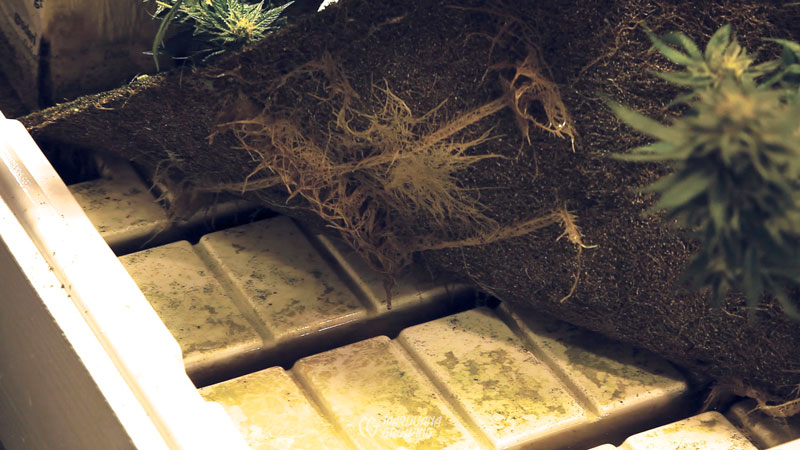
Pythium attacks roots in the entire garden.
Phytophthora
Fungal disease/host-specific parasite
Common names: water mold, plant destroyer, blight, Phytophthora blight
Specific diseases that cause root rot in cannabis include: Phytophthora species
Threat to garden: medium to high
Identify: The Phytophthora genus, referred to as water molds (Oomycetes), contains an estimated 500 species that damage cannabis. An infestation can wipe out an entire cannabis crop. These pathogens are usually host-specific parasites. They thrive, grow, reproduce, and infect plant roots in water and saturated soil. Phytophthora produces swimming spores (zoospores) are attracted to the roots and infect them. Symptoms are often misdiagnosed.
Damage: This disease attacks the entire plant—roots, stems and foliage—often causing sudden wilting and death. It can infect plants in different growth stages. When plants are infected early in life they die quickly. For example, when clones and seedlings dampen-off they rot at soil line. Infected older plants wilt irreversibly. When you see lesions that girdle the stem, it is too late to save the plant.
First, small dark green spots develop that later get bigger and look scalded. The fungal disease infests and penetrates plant tissue with long threadlike structures (sporangiophores). It causes blights, damping-off and rots. This disease cuts fluid flow within plants and causes leaf yellowing, browning and premature fall and death. These symptoms are worst in hot weather. Plants often wilt and collapse in less than a week.
Belowground you will find rotten roots and few or no feeder roots. The zone between phloem and xylem are dark and discolored. The cambium layer is often reddish brown in color. But conclusive diagnosis requires laboratory analysis of irrigation water or plant material.
Cause: Occurs naturally in most soils and is promoted by excessive substrate moisture and warm wet humid weather. Rain and water spread the disease from plant to plant and throughout garden. Phytophthora also survives on and in infested seed. Wind also disseminates the disease.
Prevention: Disinfect all tools, containers, water, soil and garden area with bleach, peroxide or another disinfectant. Keep garden temperatures cool when possible. Avoid overwatering and standing water in garden. Use clean growing media. Avoid excessive nitrogen fertilization.
Biological: Plant resistant cannabis varieties. Composted bark added to soil mixes kills Phytophthora as do organic materials that release ammonia and nitrous acid and sulfur-based fertilizers Add composted hardwood or fir bark in potting mixes. They help aerate media, release inhibitors and promote antagonistic soil fungi such as Trichoderma sp. to build up
Control: Phytophthora is difficult to control with sprays. Fungicides— maneb, mancozeb, zineb and Bravo (Chlorothalonil) are contact fungicides that prevent the disease from entering the seed and plant. Treat water with disinfectant or ozone system. Sterilize growing medium. Keep everything clean!
Sprays: They have limited success. Phosphorous acid (Allude) and the cinnamic acid group (dimethomorph (Acrobat, Forum)) inhibit but do not kill Phytophthora. Read label carefully and follow directions because application timing is essential.

Phytophthora is killing this garden.
Rust
Fungal disease
Common names: rust, hemp rust
Specific diseases that cause rust include: rust (Aecidium cannabis, Uredo kriegeriana, Uromyces inconspicuus) hemp rust (Melampsora cannabina)
Threat to garden: very low
Identify: Rust appears as orange blotches on both sides of leaves, mainly on industrial hemp. Tiny yet visible yellow spores fall to infest more foliage.
Damage: Rust discolors and kills foliage but is not fatal.
Cause: Rust is caused by unsterile growing conditions, infested soil, and another host. Sometimes controlling the second plant, the host, will control the rust. In the end, rusts have two separate forms that must have both hosts to propagate.
Prevention: clean growing conditions
Control: It can be controlled by spraying with thiocarbamate (the same stuff they put in Odor Eaters shoe insoles). Thiocarbamate (Zineb-Maneb), is systemic and restricted. DO NOT USE on consumable cannabis.
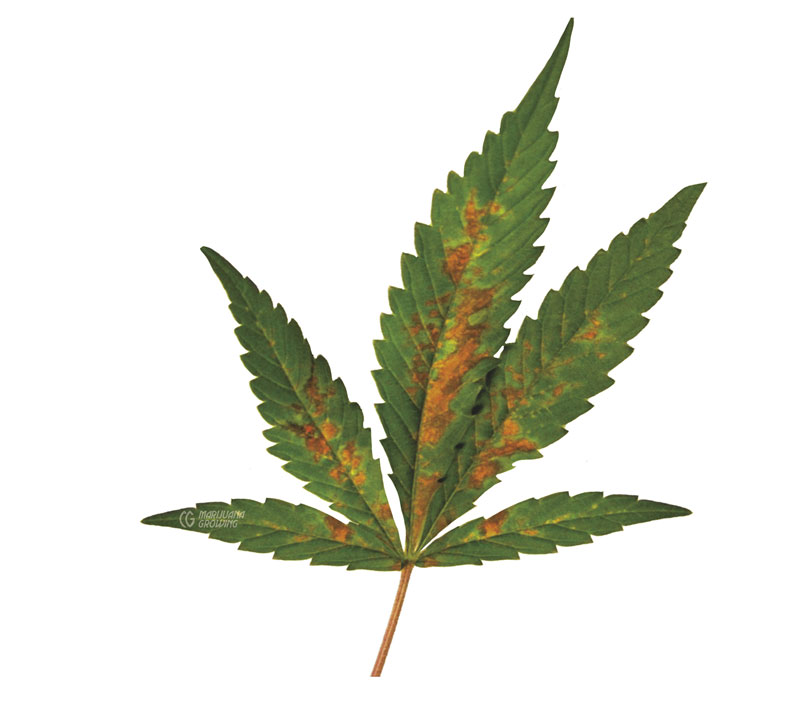
Rust is a fungal disease that is easy to mistake for cultural problems.
Verticillium Wilt
Fungal disease
Common names: wilt, Verticillium wilt
Specific diseases that cause Verticillium wilt include: Verticillium wilt (Verticillium alboatrum, Verticillium dahliae)
Threat to garden: low to medium
Identify: Lower older leaves develop chlorotic yellowing on margins and between veins before turning dingy brown. Plants often wilt during the day and recoup when the light goes off. Wilt soon overcomes parts of the plant or the entire plant. Disease starts in the roots and progresses upward, plugging the vascular system. Cut the stem in two and look for the telltale brownish xylem tissue. The fungus blocks the flow of plant fluids, causing wilt and death.
Damage: Blocks the flow of fluids in plants causing wilt and eventual death.
Cause: This fungus is present in unsterile soils and growing mediums. It can be transmitted via cuttings and seeds. Verticillium can persist in soils for long periods, and once activated can quickly overtake your garden. It is sensitive to moist soil and moderate temperatures: 75ºF (23.9ºC) is optimum with 55ºF (12.8ºC) minimum and 86ºF (30ºC) maximum for infection to occur.
Prevention: Cleanliness is critical. Use sterile tools. Use fresh, sterile soil with good drainage. Keep plants growing strong and vigorous. Avoid wounding plants. Use ammoniacal nitrogen as a source of nitrogen and less overall nitrogen and higher levels of potassium. Do not overfertilize. Make sure to remove infected plants, and keep everything clean!
Biological: Bio-Fungus (Trichoderma species), Rhizo Plus (Bacillus subtilis) Control: None. Once Verticillium is in the plant, the end is near. Sterilize the entire room if this disease appears.
Sprays: No chemical spray is effective on Verticillium wilt.
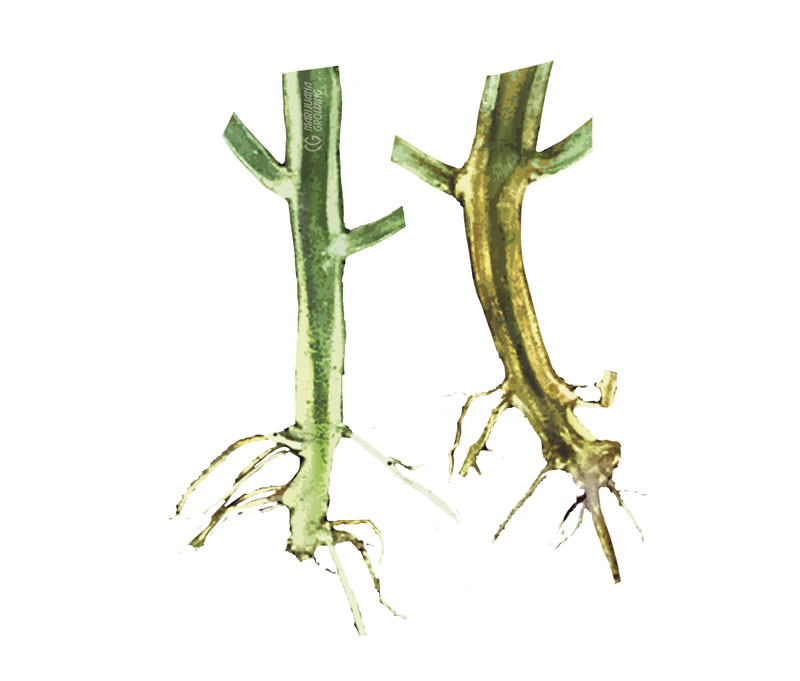
Verticillium wilt
Algae
Common names: algae, green algae, blue-green algae, green slime
Threat to garden: medium
Identify: Earthy/moldy smelling algae, most often green, can also be brown, reddish, or black. Slimy green algae need nutrients, light, and a moist surface on which to grow. These algae are found growing on moist rockwool and other growing mediums exposed to light. They cause little damage but attract fungus gnats and other critters that damage roots. Once roots have lesions and abrasions, diseases enter easily.
Damage: Algae grow anywhere— growing media; hydroponic, gulleys, pumps, and reservoirs—blocking feeder nozzles and blocking the flow of nutrients in the garden. Algae also attract root-destroying fungus gnats and nematodes. See “Fungus Gnats” and “Nematodes” for more information.
Cause: The earthy/moldy smell comes from decomposition in the growing medium and nutrient solution. Algaeuse nutrients and remove oxygen from the nutrient solution, which suffocates roots. Decomposing algae also release toxins that make roots more susceptible to disease attacks.
Prevention: Algae grow when water and nutrients combine under a light source. Remove the light and algae cannot grow. All containers, reservoirs, tubing, channels, and so forth must be lightproof. Prevention of algae is vital. Algae attract fungus gnats and their larvae, as well as nematode infestations. Because control options for these problems and pests once present are limited, the best method of algae control is to prevent the problem. Cover the moist rockwool and growing mediums to exclude light. Run an algaecide in the nutrient solution or water with an algaecide.
Control: A little bit of algae causes few problems, but thick, earthy growth requires action. Clean the system and add an algaecide in the proper proportions. Algae quickly regrow after the algaecide wears off, and the next application must be heavier to be effective. Most often, algaecides are not effective and actually more phytotoxic to roots than damage caused by algae. Unestablished and weak plants will suffer most.
Sprays/drenches: Diazinon, Endosulfan, Propiconazole, Thiram, Ziram, Quinomanid, Irgarol 1051 and hydrogen peroxide. Some grapefruit seed extracts kill algae without harming the plants.
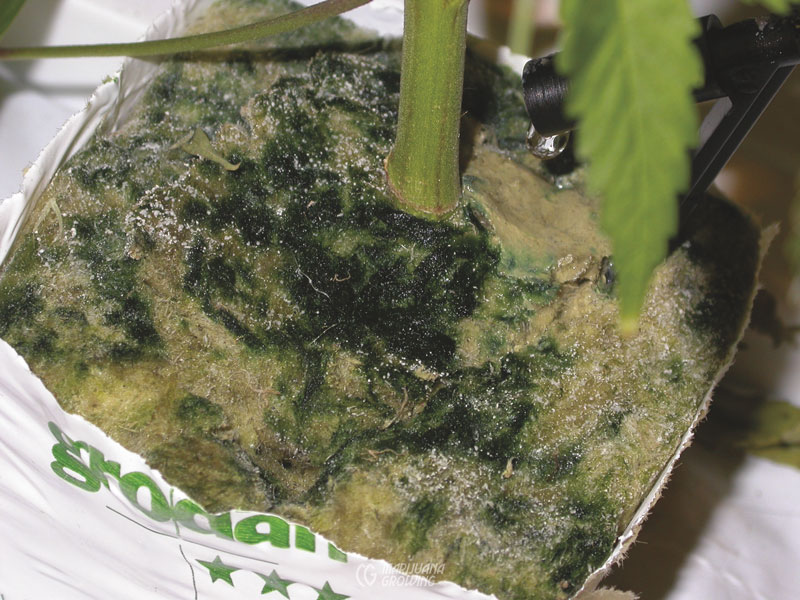
Algae on the surface of rockwool
Bacterial Diseases
Crown Gall
Common names: crown gall
Specific disease that causes crown and stem gall: crown gall (Agrobacterium tumefaciens)
Threat to garden: low
Identify: Crown gall (Agrobacterium tumefaciens) causes galls or tumorlike growths on stems and the root crown. Plant growth is stunted.
Damage: Large galls form on stems and root crown. Although usually not fatal, once crown gall invades plant tissue, the plant cannot be saved.
Cause: Crown gall is caused by Agrobacterium tumefaciens bacteria that live in the soil as well as on root surfaces. It enters and infects plants via a fresh wound.
Prevention: Practice good garden and tool sanitation. Clones are most susceptible to crown gall disease. Take all sanitary precautions when taking clones. Prevent crown gall with applications of Agrobacterium radiobacter strain K1026 or strain K84, sold under the brand names Galltrol and Gallex).
Control: None. If crown gall is found in the garden, isolate and destroy affected plants immediately. Disinfect entire garden.
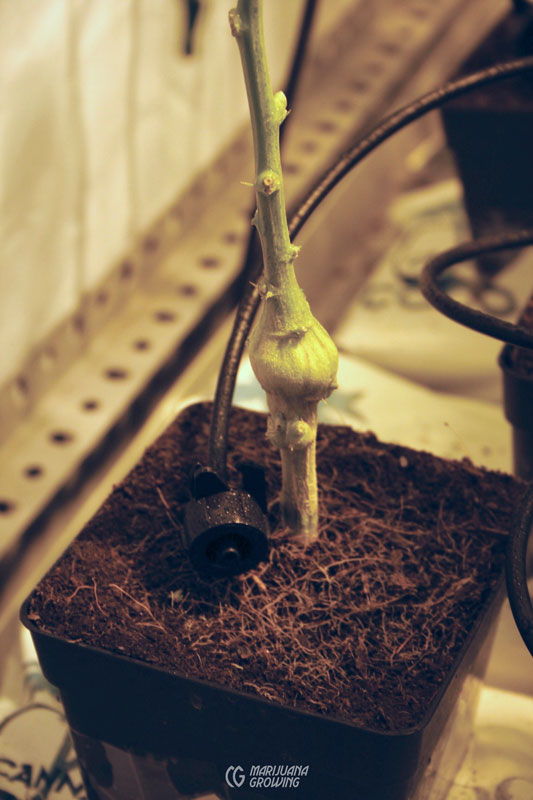
Crown gall on the stem of a cannabis plant

Crown gall infected this entire garden
Viruses
Viral disease
Common names: hemp mosaic virus, hemp streak virus (HSV)
Specific viruses include: alfalfa mosaic and Lucerne mosaic (genus Alfamovirus, alfalfa mosaic virus [AMV]) arabis mosaic (genus Nepovirus, arabis mosaic virus (ArMV)) cucumber mosaic (genus Cucumovirus, cucumber mosaic virus (CMV)) hemp mosaic (hemp mosaic virus) hemp streak (hemp streak virus)
Threat to garden: low to medium-high
Identify: Classic virus infection symptoms include sickly growth, leaf spots, stem spots, yellowing, interveinal yellow streaks, and diminished harvest. Sometimes leaf margins darken sporadically.
Damage: Viruses inhabit the fluid distribution system in plants and impair it. Telltale signs of many viruses include some or all of the following: discolored spots, mottling, chlorosis, streaking, and sometimes margins and leaf tips roll upward. Once a plant gets a virus, little can be done to kill the virus. Viruses seldom kill cannabis, but a viral infection can seriously reduce yields.
Cause: Viruses enter plants via (insect) wounds, pollen, and seed infections. They invade every part of a plant. Once established, viruses multiply in plant cells where they can completely take over the plant. They seldom kill but can severely reduce cannabis yields. Once taking hold in a plant, viruses are almost impossible to exterminate.
Vectors: Viruses are spread by insects, mites, plants, animals, and human vectors. Aphids, whiteflies, seeds, and cuttings are the worst. Infected tools also transport viruses from one plant to another.
Prevention: Cleanliness! Always use fresh, sterile growing medium. Disinfect tools before cutting foliage on different plants. Do not wound plants, and keep other diseases and pests from wounding plants. If you smoke, wash your hands with disinfectant before handling plants. DO NOT SMOKE TOBACCO products around cannabis plants.
Control: Destroy all plants infected with virus.
Biological: none
Sprays: No chemical sprays are effective against viruses.
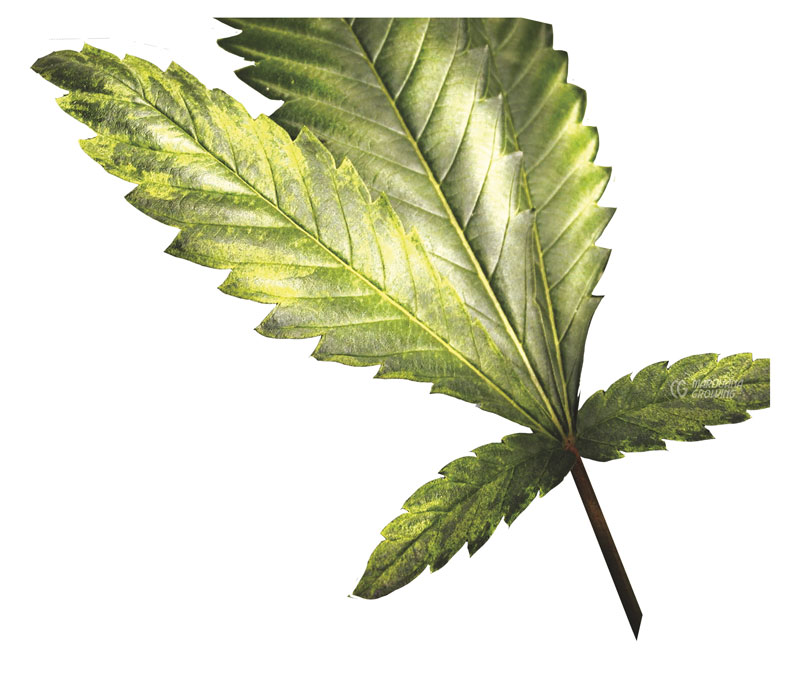
Leaf infected by a mosaic virus
Storage Fungi and Bacteria
Disease Common names: bacteria, fungi, viruses, gray mold, hemp cancer, brown blight
Specific diseases that cause damping-off include: gray mold (Botrytis cinerea) Sclerotinia sclerotiorum, Alternaria alternata
Bacteria pathogenic to humans found on cannabis include: Salmonella muenchen, Klebsiella pneumoniae, Enterobacter cloacae, E. agglomerans, Streptococcus (Group D), Thermoactinomyces candidus, T. vulgaris, Micropolyspora faeni, Aspergillus fumigatus, A. niger, A. flavus, A. tamarii, A. sulphureus, A. repens, Penicillium chrysogenum, P. italicum, Rhizopus stolonifer, Alternaria alternata, Curvularia lunata, and Histoplasma capsulatum.
Aspergillus can be killed by baking cannabis at 150ºC for 15 minutes, but only about 15 percent is destroyed by smoking through a water pipe.
Threat to Dried Buds: high
Identify: Contaminated stored cannabis is often darker, and the texture is changed by the whitish, light-gray fungus that becomes visible. Fungi often appear fuzzy and you may see shades of bluish-green and dark-green. A stale musty “locker room” odor is often apparent. Other times it could exude an ammonia-like odor. If decomposition is rapid, biological activity makes the cannabis warm to the touch.
Damage: Storage molds and bacteria degrade and decompose dry cannabis. Most of the bacteria and fungi that attack dry cannabis are only pathogens and do not infect humans unless they suffer from infections, allergies, or immune system problems. When you light a joint, burning cannabis does not kill fungus. The fungus actually precedes the smoke entering the body. Other contaminants are pet hair, human hair, dust, insect feces, residues, and so on; some of them are highly infectious and others give off toxins.
If any of the above screening tests is positive, the suspect cannabis is discarded without identifying the contaminant.
Cause: Enclosing and storing buds before they are completely dry can give rise to storage fungi and bacteria. Unsanitary contaminated tools, garden rooms, and plants carry pests and diseases.
Prevention: Carefully cultivated and harvested cannabis harbors a minimum of hazardous microorganisms. Thoroughly dry buds and leaves before storage. Available vacuum packing machines are, and will inject inert nitrogen into the storage bag when sealing. Inert nitrogen gas takes the place of all oxygen and prevents further decomposition.
Control: Screen for contamination before packaging for use as medical cannabis. Opportunistic infections pose the greatest danger to immune-suppressed consumers. Sterilize medical cannabis, preferably by gamma irradiation. Baking at low temperatures, gas-sterilizing, even Cobalt 60 irradiation do not kill microbes and are therefore not acceptable methods of decontaminating dry cannabis.
Drying: Dry cannabis contains about 10 percent moisture. Storage fungi cannot live in an environment below 15 percent. Once dry, keep it dry. Avoid damaging dry and drying cannabis. Do not place apple or citrus peels in the drying container; they decompose and attract diseases. Store dry cannabis in vacuum-sealed containers. Opening sealed containers reexposes cannabis to contaminants and moisture. Be careful avoid letting the dried cannabis absorb more moisture. Making hash from contaminated cannabis is common—and a bad idea. The contaminants remain in the hash but in a concentrated form, and microbial pathogens and toxins are not always destroyed by heating or other methods of sterilization. There is no truth to the rumor that moldy cannabis is more psychotropic. Unlike moldy grapes, moldy cannabis is not more potent! Check out “What to do with a moldy crop?” in chapter 9, Harvest, Drying & Curing.

Poorly dried and cured cannabis can smell like ammonia.
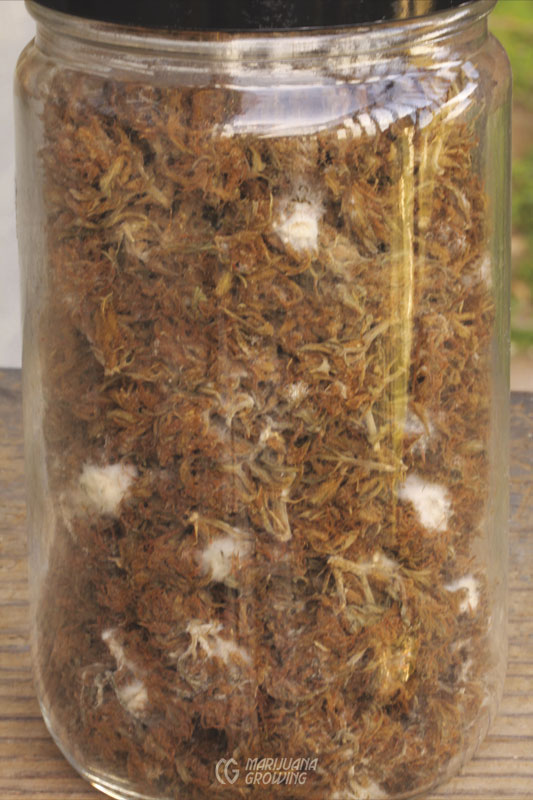
Mold soon becomes a problem when cannabis is improperly dried and cured. These buds were infected with mold, and the jar made a perfect environment for growth. (MF)
Contaminants
Contaminants adulterate almost all consumed cannabis. Most of these contaminants are harmless, such as dust, but many of the contaminants may be harmful especially to medical patients with a compromised immune system. At best, contaminants taint the taste of cannabis. Contaminants include but are not limited to fungi, bug bodies and feces, sprays, pet hair, dirt and grime, and metal flakes. In Hayward, California, a well-known cannabis patient with an unusual immune disease died from repeated exposure to the miticide called Avid. Avid is still registered for use in the USA on lawn and garden ornamentals and flowers only.
Caution! DO NOT USE AVID ON MEDICAL OR ANY CANNABIS CROPS. It is derived from the soil microorganism Streptomyces avermitilis. Translaminar insecticides and miticides penetrate the leaf tissue and remain in the plant’s system. Avid is illegal to sell in the USA, but it is available in Canada. It is for ornamentals only. Avid contains a powerful neurotoxin that is absorbed and accumulates over time.
In the late 1970s, the US government sprayed the herbicide Paraquat on cannabis crops in Mexico, and more recently in Hawaii. Paraquat and other Drug War pesticides permeate vegetative growth. They cause serious health problems in humans.
Fungal or bacterial infections can result from sloppy cultivation techniques. A small number of plant pathogens remain in poorly dried and stored cannabis. Some of these pathogens can infect humans. Individuals with a depressed immune system are most at risk.
Aspergillus, a bacterial contaminant, is found in some improperly stored cannabis. It has been cited by organ transplant experts as a risk to exclude a candidate from receiving a transplant. Tim Garon from Washington state was denied a liver transplant due to these consequences; he passed away in 2008.
Controlling all cannabis for Aspergillus and preventing its occurrence with clean gardening and proper drying and storage are essential. See chapter 9, Harvest, Drying & Curing, for more information.
Gritweed is cannabis buds covered in tiny, glasslike particles that are actually silica. Gritweed was a big problem in the Netherlands for a few years. It started when the number of coffee shops was cut in half by government policies. Find references to gritweed in old issues of Soft Secrets (www.softsecrets.nl).
Pest Insects and Mites
Ants
Common names: ants, piss ants, red ants, big-headed ants, little black ants, pavement ants
Latin names: order Hymenoptera
Garden threat: low
Identify: ants
Damage: Ants are annoying; they spread diseases from the outdoor garden to the indoor garden and from plant to plant. Some species of ants “farm” aphids, moving them from source to source for the honeydew aphids give off.
Cause: Ants can enter a garden room that is not sealed shut. They may be drawn by a food source inside the garden room.
Prevention: If ants are entering from outside the garden room, block their entry with a small barrier of cinnamon, Tanglefoot, etc.
Control: Apply as per directions for sweet bait traps: Terro, Pic, Drax Ant Kill Gel (sugar-feeding ants), Drax-FP (grease and sugar-feeding ants), MAXFORCE, (cockroach and Pharaoh ant killer—hydramethylnon). See “Ant Bait”.
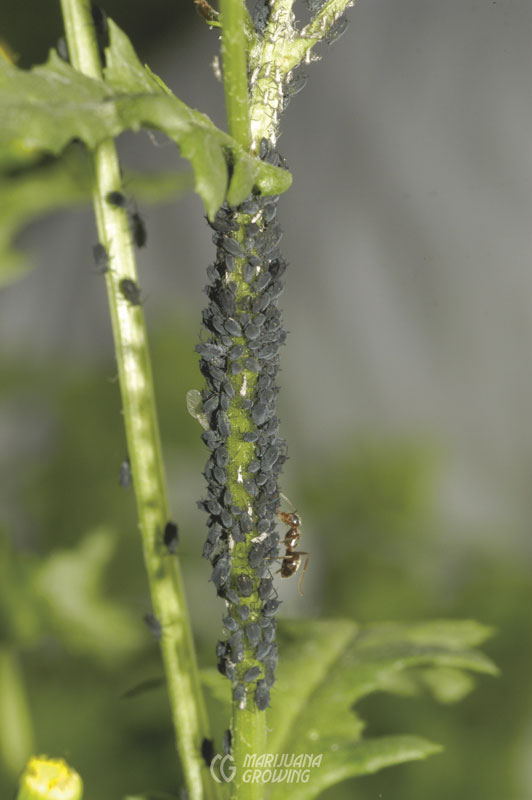
Ants farm aphids, spreading them to other plants.
Aphids
Common names: peach aphid, black bean aphid, bhang aphid, hops aphid
Aphid species that attack cannabis include: green peach aphid (Myzus persicae, Homoptera: Aphididae. = Phorodon persicae) black bean aphid (Aphis fabae, Momoptera: Aphididae) bhang aphid aka hemp louse (Phorodon cannabis, Homoptera: Aphididae. = Aphis cannabis = Mysus cannabis, = Paraphorodon cannabis, = Diphorodon cannabis, = Aphis sativae, = Phorodon asacola, = Capitophorus cannabifoliae, = Semiaphoides cannabiarum) hops aphid (Phorodon humuli)
Garden threat: Low. Aphids seldom attack indoor plants and occasionally infest outdoor plants.
Identify: Aphids, also called plant lice, are about the size of a pinhead. They are easy to spot with the naked eye, but use a 10X magnifying glass for positive identification. Aphids are found on leaf undersides, branches, and buds.
Normally grayish to black, aphids can be green to pink. In any color, aphids exude sticky honeydew as they feed. Most aphids have no wings, but for those that do, their wings are about four times the size of their bodies. Aphids give birth to mainly live female larvae, without mating, and can produce 3 to 100 hungry larvae every day. Each female reproduces between 40 and 100 offspring that start reproducing soon after birth. Aphids are most commonly found indoors when they are plentiful outdoors.
Install yellow sticky traps near the base of several plants and near the tops of other plants to monitor invasions of winged aphids, often the first to enter the garden. As they feed, aphids exude sticky honeydew that attracts ants that feed on it. Ants like honeydew so much that they take the aphids hostage and make them produce honeydew. Look for columns of ants marching around plants, and you will find aphids.
Damage: Aphids suck the life-giving sap from foliage, causing leaves to wilt and yellow. Aphids prefer to attack weak, stressed plants. Some species prefer succulent, new growth, and other aphids like older foliage or even flower buds. Look for aphids under leaves or huddled around branch nodes and growing tips. This pest transports (vectors) bacterium, fungi, and viruses. Aphids vector more viruses than any other source. Destructive sooty mold also grows on honeydew. Any aphid control must also control ants, if they are present. Some aphids infest flower tops, causing buds to distort. Aphids can cause entire plants to wilt, be stunted, and die.
Cause: Aphids enter garden rooms and greenhouses on dirty tools, clothes, etc. Or they are naturally present in the garden area outdoors.
Prevention: Grow strong, healthy plants. Inspect plants regularly for aphids. Blast off any sign of aphids with a heavy spray of water.
Control: Manually remove small numbers of aphids. Spot-spray small infestations, and control ants. Introduce predators if problem is persistent.
Cultural and physical control: Manual removal is easy and works well to kill aphids. When affixed to foliage—sucking out fluid—aphids are unable to move and easy to crush with fingers or sponges dipped in an insecticidal solution.
Biological: Lacewings, Chrysoperla species, are the most effective and available predators for aphids. Release one to 20 lacewings per plant, depending on infestation level, as soon as aphids appear. Repeat every month. Eggs take a few days to hatch into larvae that exterminate aphids. Gall midge Aphidoletes aphidimyza is available under the trade name Aphidend; parasitic wasp Aphidius matricariae is available commercially. Adybugs also work well to exterminate aphids. Adults are easily obtained at many retail nurseries during the summer months. The only drawback to ladybugs is their attraction to the HID lamp—release about 50 ladybugs per plant, and at least half of them will fly directly into the HID, hit the hot bulb, and buzz to their death. Within one or two weeks, all the ladybugs will fall victim to the lamp, requiring frequent replenishment. Verticillium lecanii (fungus)—available under the trade name of Vertalec—is aphid-specific and effective.
Control ants with borax. See “Boric Acid”.
Sprays: Homemade and insecticidal soap sprays are very effective. Apply two or three times at five- to ten-day intervals. Pyrethrum (aerosol) applied two to three times at five- to ten-day intervals.
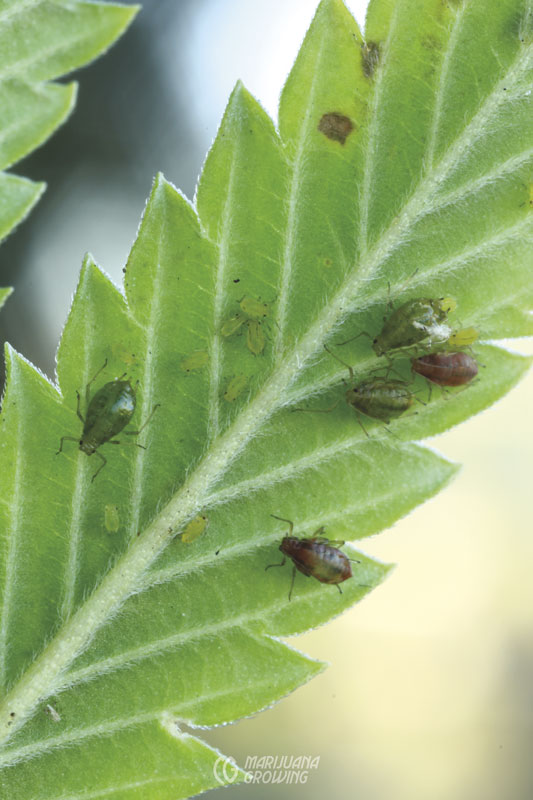
Young adult aphids, translucent with green and brown (MF)
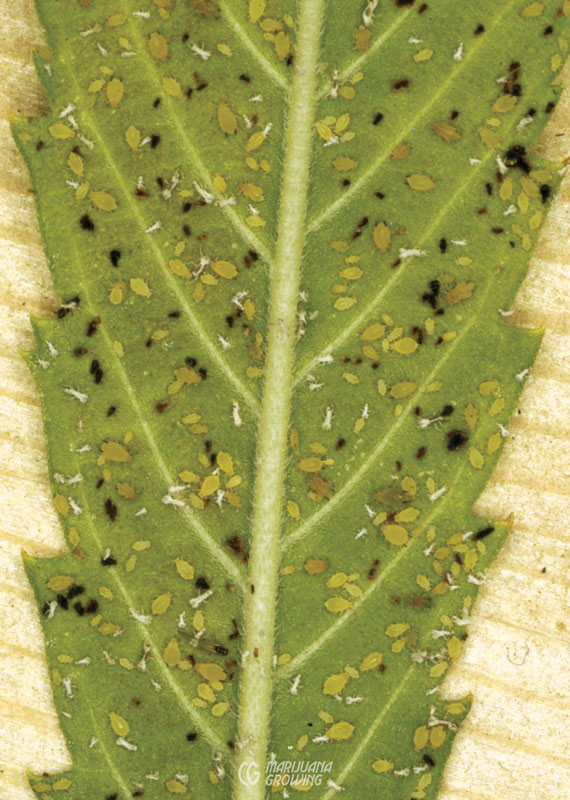
Aphids, spider mite,s and thrips are on this leaf.
Root Aphids
Common name: root aphid
Garden threat: very high
Root aphid species that attack cannabis include: grape phylloxera
Identify: Root aphids (grape phylloxera) are tiny aphid-like insects that feed on a number of plant roots. They are often confused with fungus gnats. Oval- to pear-shaped, phylloxera are small (0.04 inch [1 mm] long) and from yellow/ yellowish green/olive green to light- to dark-brown or orange in color. Oval shaped eggs are yellow. Nymphs are small versions of adults. The majority of grape phylloxera adults are wingless females. Root aphids,in the genus Phemigus, are increasingly feeding on cannabis root systems and have become a major pest in parts of the USA and other parts of the world. Inspect roots by sliding the root ball out of the container.
Root aphids are super tiny insects with legs. Aphids colonize roots on the outside of the root ball especially near drainage holes. They are about the size and color of coco fiber grains.
Damage: Phylloxera feed on roots and rootlets, causing them to yellow from the bottom up, swell, and turn hard. Dead (necrotic) spots develop where pests feed. Secondary fungi infect wounds and often girdle roots, killing large sections. Plants become stunted, and yield diminishes substantially. Infestations can kill plants. Damage is easily confused with disorders caused by nutrients, water, and so forth.
Cause: Root aphids can be introduced to the garden by infested soil clones or seedlings. They can also be carried in on dirty tools, or fly or crawl into unfiltered rooms. They overwinter as small nymphs on roots. In spring when soil temperatures exceed 60ºF (15ºC), they start feeding and growing. Indoors, root aphids are very active 24/7. When soil temperatures fall below 60ºF (15ºC), all life stages die except the small nymphs. There are three to five generations each year. First instar nymphs are active crawlers and may move from plant to plant in the ground, on the soil surface, or by blowing in the wind. They may also be moved between vineyards on cuttings, boots, or equipment. Grape phylloxera is more common near vineyards, where they infest grape vines.
Prevention: Avoid cool, heavy clay soils and soils in grape-growing regions that are infested with grape phylloxera. Avoid overfertilization with nitrogen.
Use sticky yellow traps to monitor flying adults. Pesticide treatment will not eradicate phylloxera populations; even if much of the phylloxera is killed, populations often rebound quickly.
Control: Once the garden is infested, root aphids are hard to dispatch. A multipronged approach may be necessary to completely break their life cycle. A strong drench such as BotaniGard slows root aphids down, followed by releases of predatory nematodes (Heterorhabditis bacteriophora), which helps ensure that they are all killed and eaten!
BotaniGard is an insecticide that is composed of a living fungus, Beauveria bassiana. This fungus seeks out aphids and infects them, causing death. Then it releases spores, waiting for more victims. It also works to control whiteflies and thrips. You can order it at many garden stores or through garden websites on the Internet.
Neem oil and citrus oil have also been used to kill aphids, but they sometimes affect plant roots. Test them on a sample plant before using either of them in the garden. The aphids should be treated every other day with a minimum of six treatments. Rotate the insecticides.
BotaniGard can be combined with pyrethrum. The neem and citrus oils can be mixed with each other as well as with pyrethrum. The idea is to totally eliminate the pests. Predatory nematodes (Heterorhabditis bacteriophora) are super effective and easy to use. The best part about using the nematodes is that they will kill all of the little root aphids! Once aphids are gone, it is difficult for them to re-infect the garden. They were probably introduced to the garden by a new element such as a clone or infected planting mix.
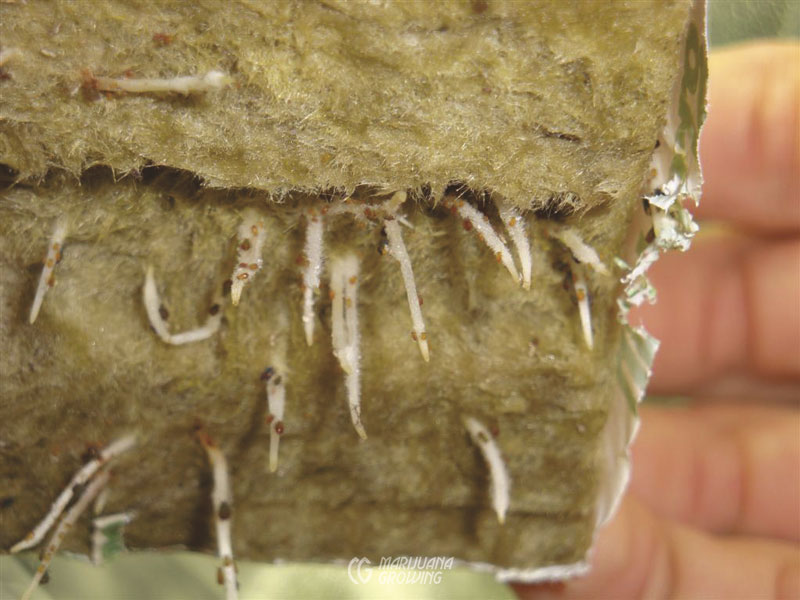
Root aphids
Bees and Wasps
Garden threat: none
Bees (Anthophila, more than 20,000 known species)
Wasps (order Hymenoptera and suborder Apocrita)
Hornets (order Hymenoptera, family Vespidae, genus Vespa)
Identify: Bees and wasps that sting are usually from a half-inch (1.3 cm) to more than an inch (2.5 cm) long. Many have yellow stripes around their bodies; others have none. They are especially attracted to indoor gardens when weather cools outdoors. They move right in. They have many names and manifestations. For example, in Alabama there are four wasps that sting: red, red-faced, small red, and black. Also, there are two hornets, one that builds big nests and has a bald or white face. European wasps also make appearances.
Note: Many beelike insects are beneficial. See “Beneficial Insects” in this chapter.
Damage: No damage to plants but can become a nuisance in garden rooms— they hurt like hell when they sting! Cause: Bees and wasps occur in garden areas during spring, summer, and autumn in most climates but can be active in winter in warm climates.
Prevention: Exclude from garden rooms and greenhouses with screens and traps.
Control: Bees and wasps are occasionally a problem indoors and are most efficiently controlled with sprays.
Cultural and physical control: They enter garden rooms through vents and cracks, and are attracted by the growing plants, a valuable commodity in the middle of a cold winter! Screen all entrances to the room. Install more circulation fans to make flying difficult. Wasp traps, sweet flypaper, and Tanglefoot impair these pests. Bees and wasps are also attracted to the hot HID and fly into it and die.
Biological: unnecessary
Sprays: Pyrethrum is recommended. Stuff small nests into a wide-mouthed jar—do it at night when the wasps are quiet—and place the jar in a freezer for a few hours. Use Sevin (carbaryl) only if there is a problem with a wasp nest. Use wasp and hornet sprays to control as well, but DO NOT allow the spray to get on plants, as it will damage the plant tissue.
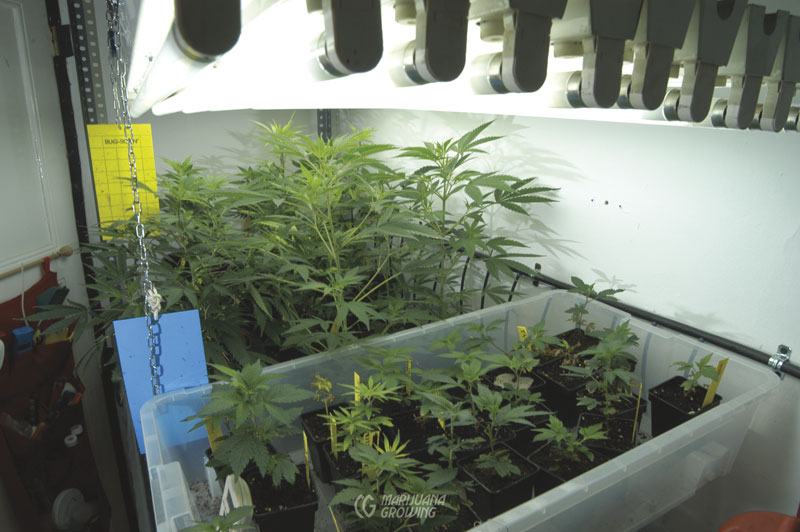
Sticky yellow traps are kept in place to monitor insect populations.
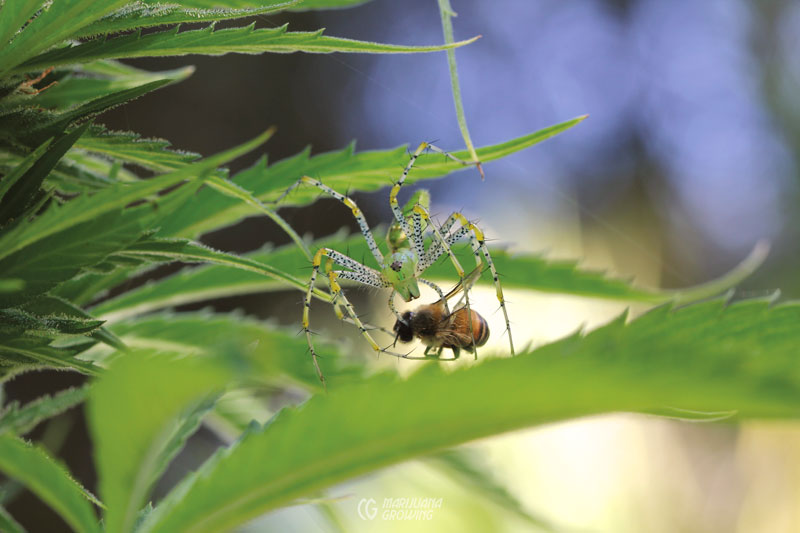
Green lynx spider attacking a bee (MF)
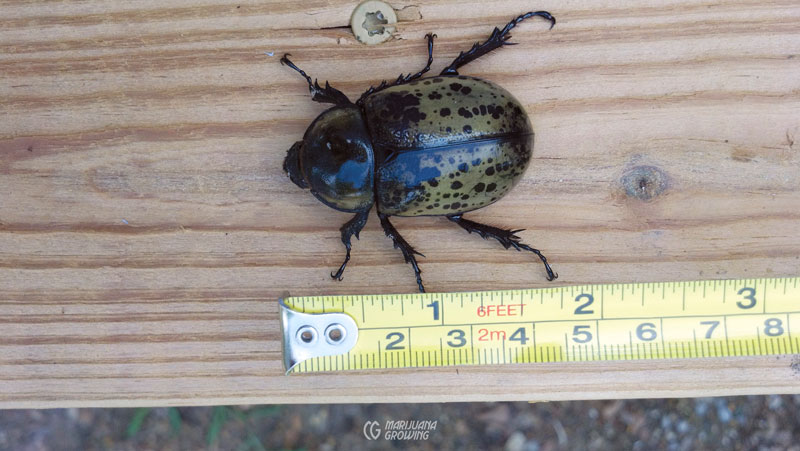
This unknown beetle was captured in Alabama and measures nearly two inches (5 cm) in length!
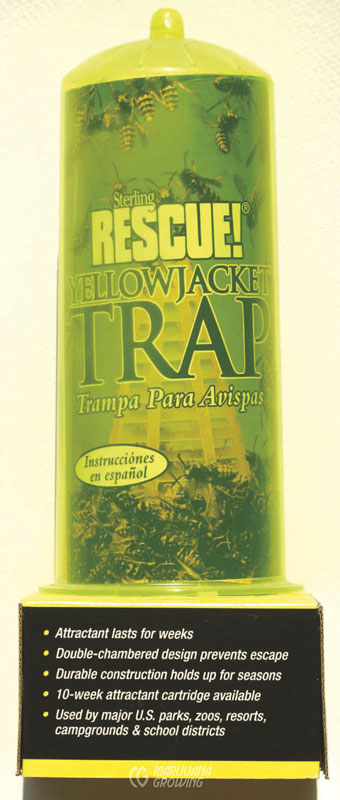
Wasp traps keep wasps in check and work well to monitor activity
Borers
Garden threat: outdoors medium, seldom seen indoors
Borer species that attack cannabis include: European corn borer (Ostrin-ia nubilalis, Lepidoptera: Pyralidae. = Pyrausta nubilalis, = Botys silacealis) hemp borer (Grapholita delineana, Lepidoptera: Olethreutidae. = Cydia delineana, = Laspeyresia delineana, = Grapholita sinana, = Cydia sinana) common stalk borer (Papaipema nebris, Lepidoptera: Noctuidae. = P. nieta)
Identify: Many boring insects are members of several families that include boring larvae, grubs, minors, maggots, and so forth that tunnel or bore into stems, foliage, and roots. At one stage in their lives they could turn into beetles, caterpillars, or moths of many shapes, colors, and sizes. Look for their entry hole and dead growth on either side of the entry hole along the main stem, often discolored and accompanied by sawdust. Borers are more common outdoors than indoors. Borers are more common in areas where industrial hemp is growing. Borers have accounted for serious crop loss in Europe.
Many borers are able to produce three to five generations per year that flourish in temperatures above 60ºF (15.6ºC). Borers overwinter in the soil and emerge the following year. Disrupting the life cycle is the best long-term control. Some borers spin cocoons.
Damage: Tunnels and burrows inside stems, foliage, and roots curtail fluid flow and cause plant parts to wilt. If borer damages the main stem severely, fluid flow to the entire plant could stop, causing death. Wounds and feces attract moisture, disease, and infections. Hemp borers have a ravenous appetite and can destroy flowering tops and cannabis seeds.
Cause: Outdoors, borers are in the soil and in agricultural crops and roses, among other ornamentals and vegeta-bles. Though seldom a problem indoors, borers occasionally attack outdoor crops.
Prevention: Seldom a problem indoors. Bait with Bt (Bacillus thuringiensis) to prevent and kill borers. Watch for beetles and moths that lay borer eggs.
Controls: Borers can be fought with 50 percent methyl parathion (0.5 oz [14.8 ml]) for 1,000 square feet (9.3 m2). After harvesting, the stubble and waste stalks should be burned, and the field plowed.
Cultural and physical control: Hand-pick all beetle grubs. Borers often cause so much damage on a particular stem that it has to be removed and destroyed.
Sprays: Bacillus popilliae is specific to beetles or rotenone individually injected into stems.
Biological: Several mixes of beneficial nematodes control these borers in soil.
Biological Control: The wasp Trichogramma evanescens Westwood, Hymenoptera species of parasites and predators prey on Grapholita delineana.
Caterpillars and Loopers Caterpillar species that attack cannabis include: silver moth (Autographa gamma, Lepidoptera: Noctuidae. = Plusia gamma, = Phytometra gamma) dot moth (Melanchra persicariae, Lepidoptera: Noctuidae. = Polia persicariae, = Mamestra persicariae) cabbage moth (Mamestra brassicae, Lepidoptera: Noctuidae. = Barathra brassicae) garden tiger moth (Arctia caja, Lepidoptera: Arctiidae) common hairy caterpillar (Spilosoma obliqua, Lepidoptera: Arctiidae. = Diacrisia obliqua) beet webworm (Loxostege sticticalis, Lepidoptera: Pyraustinae. = Phlyctaenodes sticticalis) corn earworm moth (Helicoverpa zea) chrysanthemum webworm (Cnephasia interjectana, Lepidoptera; Tortricidae. = Cnephasia virgaureana) death’s-head moth (Acherontia atropos, Lepidoptera: Sphingidae. = Sphinx atropos)
Garden threat: low indoors, high outdoors and greenhouses Caterpillars and loopers leave plenty of droppings on the plant. The droppings accumulate between buds. Droppings fall out when the buds are hung to dry; inspect below the hung buds to find the droppings.
Caterpillars turn into moths or butterflies and fly away. Some transform quickly and fly; others take longer to migrate. Cater-pillars have a peak occurrence and can be planned for, in most instances. They may complete a life cycle and do it again, but most typically they develop slower and pupate or lay eggs that overwinter. Some do so as a larva. They will also move like armyworms.
Identify: From a half-inch to four inches long (1.3–10.2 cm), caterpillars and loopers are cylindrical with feet, often green, but can be virtually any color from white to black. Caterpillars have sets of feet the entire length of the body, while loopers have two sets of feet at either end of the body. Loopers place their front feet forward, arch their body upward in the middle, and pull their rear set of legs forward. Some have stripes, spots, and other designs that provide camouflage. Seldom a problem indoors, caterpillars and loopers are in a life stage—between a larva and a flying moth or butterfly—and are most com-mon when prevalent outdoors. One way to check for caterpillars and loopers is to spray one plant with pyrethrum aerosol spray and shake the plant afterward. The spray has a quick knockout effect, and most caterpillars will fall from the plant. Caterpillars are problems primarily for outdoor growers.
Caterpillars eat floral clusters from the inside out, and their activities provide a vector for a pervasive cannabis fungal disease.
Leaf-eating caterpillars spend most of their time on leaves. They often manipulate leaves before eating them; their feeding habits include eating small sections of leaf in between leaf veins, or eating large chunks of leaf outright.
Damage: These munching critters chew and eat pieces of foliage and leave telltale bites in leaves. Some caterpillars will roll themselves inside leaves. An infestation of caterpillars or leafhoppers will damage foliage and slow growth, eventually defoliating, stunting, and killing a plant.
Cause: Untilled soil outdoors around and in garden area. Eggs overwinter in soil and are often killed by tilling. Adjacent plants attract or have caterpillars and their eggs.
Prevention: Bait with Bt (Bacillus thuringiensis) before caterpillars are normally out.
Control: Shake plants several times a day to dislodge the insects. Preventive sprays containing insecticidal soaps and organic toxins can be used selectively during vegetative cycle, but extreme care must be taken during floral cycle.
Cultural and physical control: Manually remove.
Biological: Trichogramma wasps, spined soldier bug (Podisus maculiventris, Podibug).
Sprays: Pyrethrum aerosol works great! Homemade spray/repellent, hot pepper and garlic, Bt, pyrethrum, rotenone, and neem products.
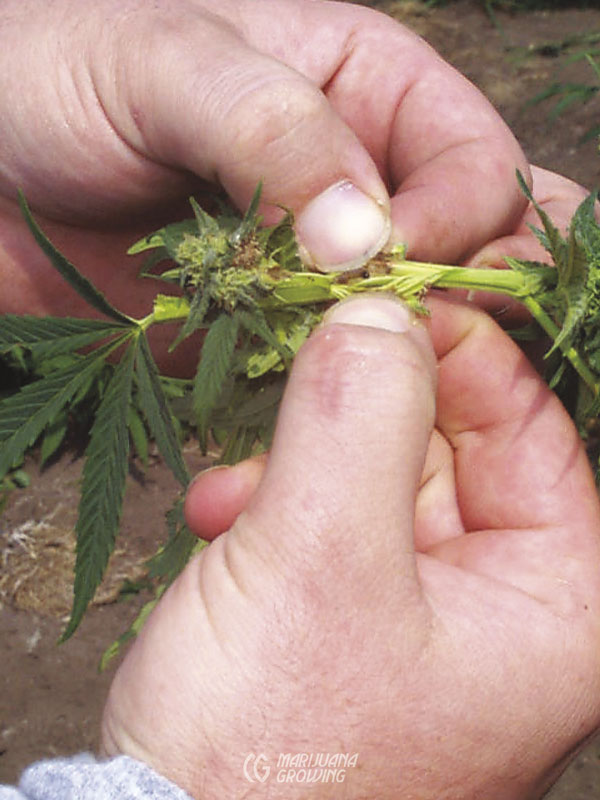
Sticky yellow traps are kept in place to monitor insect populations.
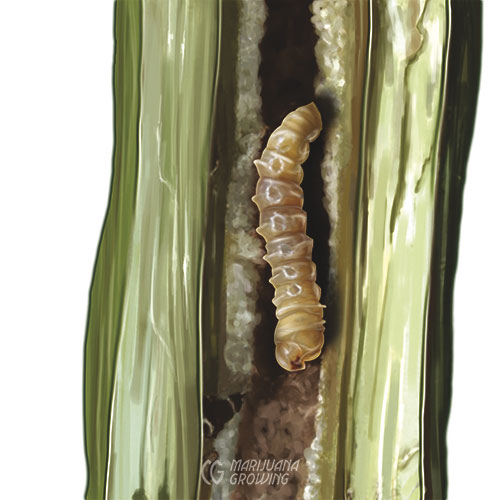
Borers live inside stems.
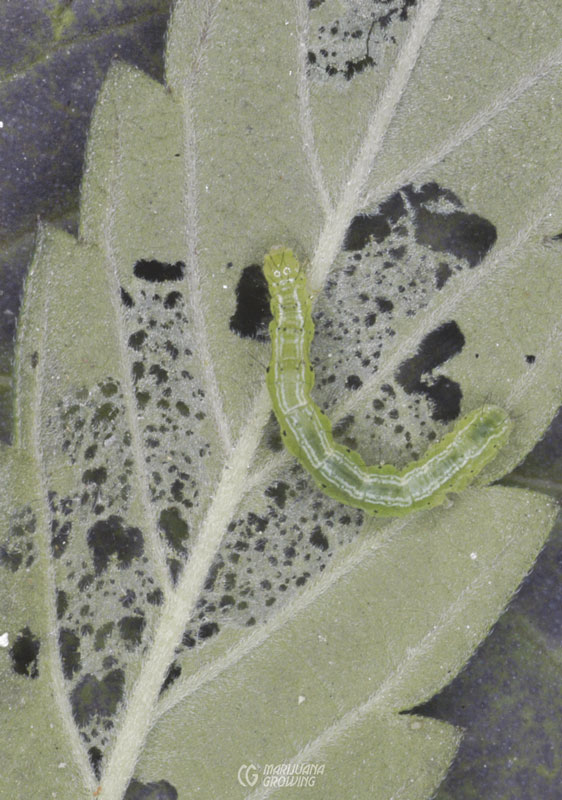
Caterpillar populations can explode. The little worms eat more than their body weight in foliage every day.
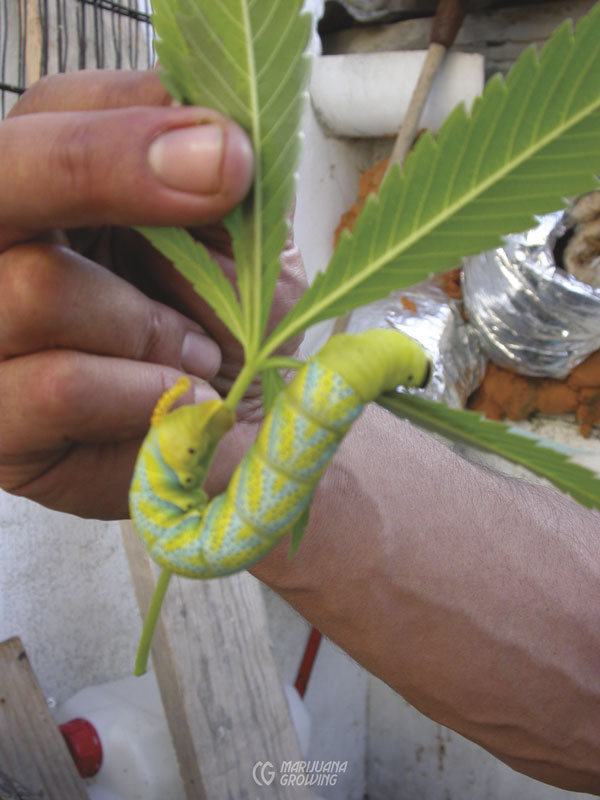
This beautiful caterpillar is able to munch down many leaves in a single day!
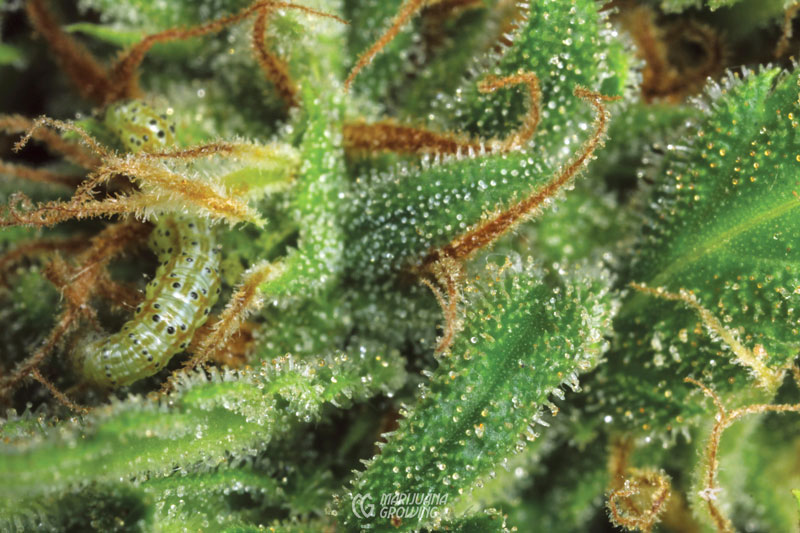
Look closely at the left side of the photo and you will see a corn earworm disguised as part of the resinous foliage. (MF)
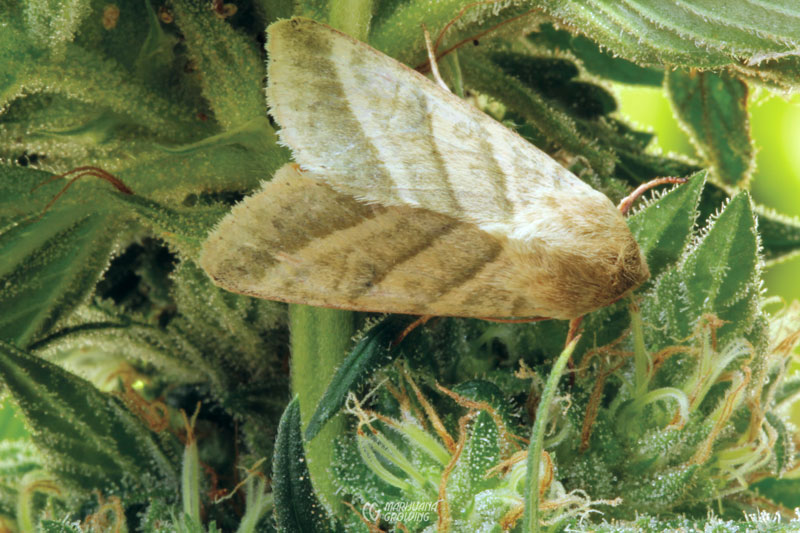
This moth lays the eggs that hatch into the (cannabis) corn earworms. Always keep an eye out for this moth in your garden! (MF)
Crickets
Common names: crickets, field crickets, house crickets, mole crickets, tree crickets
Cricket species that attack cannabis include: family Gryllidae (Gryllus desertus, Gryllus chinensis) mole cricket (Gryllotalpa gryllotalpa, Gryllotalpa hexadactyla) tree cricket (Oecanthus indicus)
Garden threat: low
Identify: There are more than 900 spe-cies of crickets. They range in size from 0.6 to 1 inch (15–25.4 mm). Crickets have somewhat flattened bodies and long antennae. Generally nocturnal, crickets may be confused with grasshoppers that have similar (jumping) hind legs and body structure. The familiar chirp (stridulation) of crickets is produced predominately by males. Crickets are found in moist areas and climates and are known to frequent gardens, especially around water sources, singing their song on warm summer nights. Crickets are omnivorous scavengers. They eat decaying plant material, fungi, and tender seedling plants. Crickets lay eggs in the fall that hatch in the spring. A single female can lay up to 200 eggs.
Damage: Crickets eat young seedlings and emerging plants. Cause: Crickets are common in humid conditions in (tropical) warm weather and during hot summers.
Prevention: Keep crickets outdoors! Drive them away from greenhouses by cleaning the perimeter. They have many food sources and seldom attack cannabis.
Cutworms
Common names: beet armyworm, black cutworm, cabbage moth, common cutworm, paddy cutworm
Cutworm species that attack cannabis include: black cutworm (Agrotis ipsilon Lepidoptera: Noctuidae. = Euxoa ypsilon) paddy cutworm (Spodoptera litura Fabricius, Lepidoptera: Noctuidae. = Prodenia litura Fabricius) beet armyworm (Spodoptera exigua, Lepidoptera: Noctuidae. = Laphygma exigua) claybacked cutworm (Agrotis gladiaria, Lepidoptera: Noctuidae) common cutworm (Agrotis segetum, Lepidoptera: Noctuidae. = Euxoa segetum) Bertha armyworm (Mamestra configurata, Lepidoptera: Noctuidae)
Garden threat: low
Identify: Cutworms are larvae of other pests that are in the soil during a stage of their life. Cutworms are larvae that eat the base of the stem and cut off the plant. They come in many shapes and sizes. Cutworm larvae have a big appetite and will devour seeds, sprouted seeds, and seedlings. They must become strong to transform into moths or butterflies. Once plant roots and stems are stronger and tougher, cutworms are less of a threat. Cutworms rarely find their way into an indoor garden. Outdoors they are most common in backyard gardens and in greenhouses where plants grow in the ground.
Damage: Cutworms dine on emerging plants and seedlings, ultimately killing them. Often small plants emerge for a few days and the roots are eaten by a cutworm.
Cause: untilled soil that contains cutworm eggs
Prevention: Till soil or use new soil.
Control: Bt bait mixed in soil
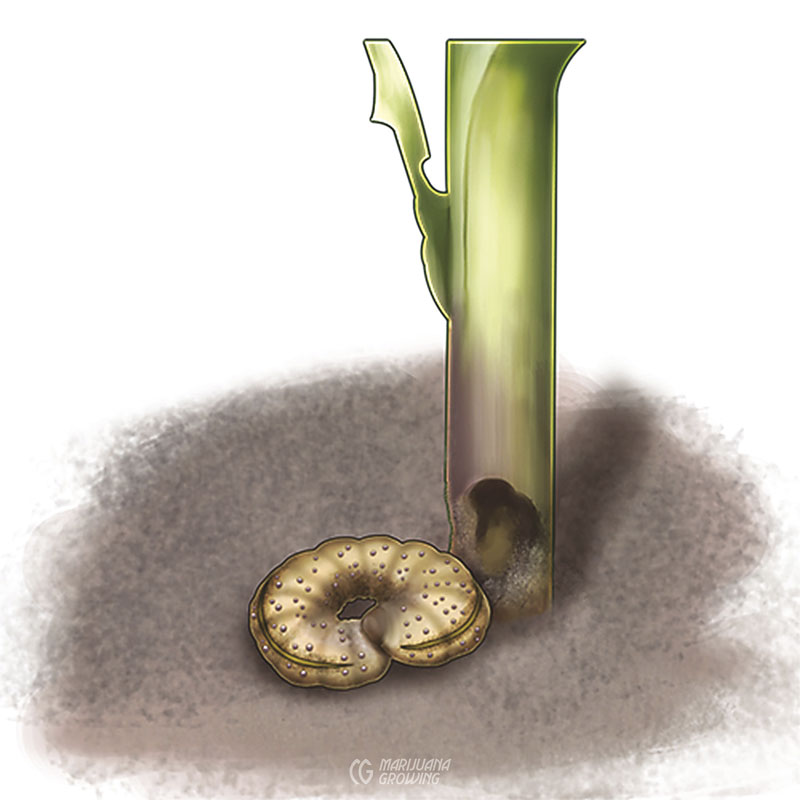
Cutworms live near the base of a plant.
Grasshoppers
Common names: two-spotted grass-hopper, clear-winged grasshopper, citrus locust. (I always call them saltamontes, Spanish for grasshopper.)
Grasshopper species that attack cannabis include: Melanoplus bivittatus, Chloealtis conspersa, Camnula pellucida, Zonocerus elegans, Chondracris rosea
Garden threat: low
Identify: Grasshoppers and locusts pose little threat to cannabis crops unless large swarms of the pests arrive. Some years there are plagues of grasshoppers, and lo-custs swarm and migrate, eating all plants in sight. They are easy to identify and come in many sizes. With long, folded legs, grasshoppers are built to bound long distances. They are occasionally problem-atic outdoors. Grasshoppers stay around only for a short period of time and move on. Grasshoppers are best handpicked from your plants if you wish to control them. Birds also eat grasshoppers.
Damage: Very little damage to leaves. Seldom will swarms of locusts appear and eat all foliage in sight.
Cause: You let them into your indoor garden room. Outdoors, grasshoppers have a free range and cause little damage.
Prevention: none needed
Control Biological: Encourage birds in your garden. Handpick grasshoppers with nimble fingers.
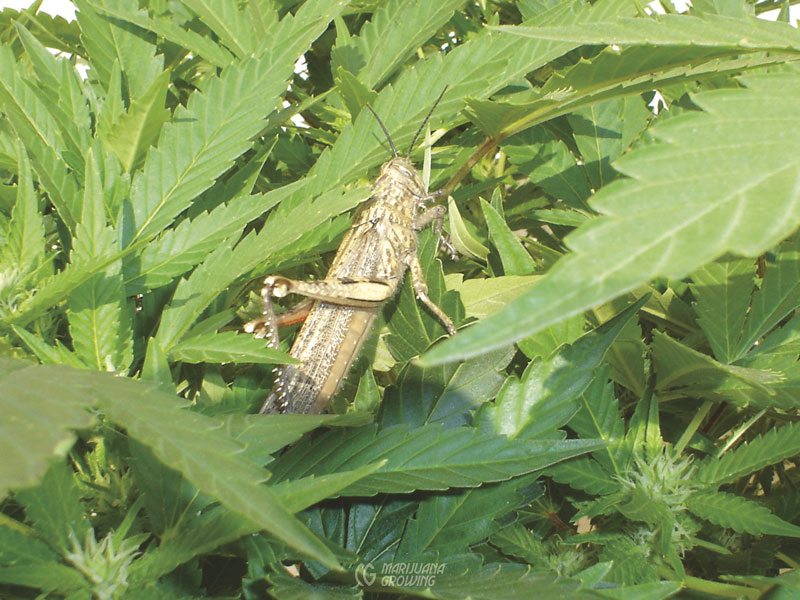
Grasshoppers are normally not attracted to cannabis. But if they get hungry, grasshoppers will eat anything! (MF)
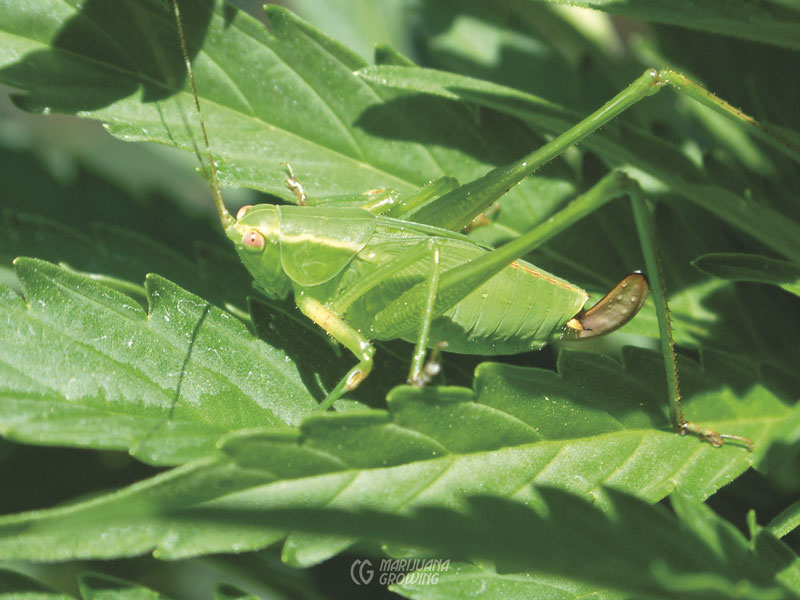
There are many, many different species of grasshoppers. (MF)
Leafhoppers
Common names: Leafhopper, greenhouse leafhopper, spittlebug,
Leafhopper species that attack cannabis include: (family Cicadellidae) Zygina (Erythroneura) pallidifrons, Graphocephala coccinea, Empoasca fabae, Empoasca flavescens, Philaenus spumarius, Bothrogonia ferruginea, Stictocephala bubalus
Garden threat: low indoors, high outdoors and greenhouses
Identify: Leafhoppers include many small, 0.125 inch (3.2 mm) long, wedge-shaped insects that are usually green, white, or yellow, but some are larger and look like green grasshoppers with leafs for wings. They can move very fast. Many species have minute stripes on wings and bodies. Their wings peak like roof rafters when not in use. Leafhoppers suck plant sap for food and exude sticky honeydew as a by-product. Spittlebug and leafhopper larvae wrap themselves in foliage and envelop themselves in a saliva-like liquid, plant sap. They can be serious pests, especially the glasshouse leafhopper (Zygina pallidifrons).
Damage: Leafhoppers cause stippling (spotting) on foliage, similar to that caused by spider mites and thrips. Leaves and plant lose vigor, and in severe cases death could result.
Cause: Eggs come in via unclean garden practices. Adults enter via the front door, cracks, or holes in garden rooms. Outdoors, this pest has free range.
Prevention: Cleanliness! Screen windows and use hygienic control.
Cultural and physical control: Black-light traps are attractive to potato beetles.
Biological: The fungus Metarhizium anisopliae is commercially available under the trade name Metaquino.
Sprays: pyrethrum, rotenone, sabadilla.
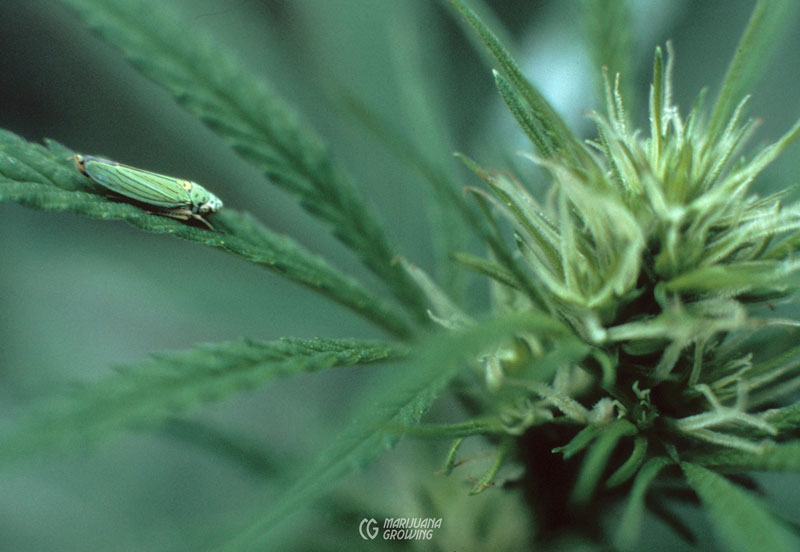
The leafhopper on the left-hand side of the photo blends in with the foliage. (MF)
Leaf Miner
Common name: leaf miner
Leaf miner species that attack cannabis include: (family Agromyzidae) Liriomyza (Agromyza) strigata, Phytomyza horticola, Agromyza reptans, Liriomyza eupatorii, Liriomyza cannabis
Garden threat: very low
Identify: Adult leaf miner flies lay eggs that hatch into one-eighth-inch (0.25 mm) long green or black maggots. You seldom see the maggots before you see the leaf damage they create when they tunnel through leaf tissue. Leaf miners are more common in greenhouses and outdoors than indoors.
Damage: The tiny maggots burrow between leaf surfaces, leaving a telltale whitish-tunnel outline. The damage usually occurs on or in young supple growth. It is seldom fatal, unless left unchecked. Damage causes plant growth to slow, and if left unchecked, flowering is prolonged and buds are small. In rare cases the damage is fatal. Wound damage encourages disease.
Cause: These little pests fly in through the door and are often abundant outdoors.
Prevention: Little prevention is necessary because they pose little threat to the garden.
Controls: Leaf miners cause little problems for indoor crops. The most efficient and effective control is to remove and dispose of damaged foliage, which includes the rogue maggot, or to use the cultural and physical control listed below.
Cultural and physical control: Smash the little maggot trapped within the leaf with your fingers. If the infestation is severe, smash all larvae possible and remove severely infested leaves. Compost or burn infested leaves. Install yellow sticky traps to capture adults.
Biological: braconid wasp (Dacnusa sibirica), chalcid wasp (Diglyphus isaea), parasitic wasp (Opius pallipes)
Sprays: Repel with neem oil and pyrethrum sprays. Maggots are protected within tunnels, and sprays are often ineffective. Hemp Diseases and Pests suggests to water plants with a 0.5 percent solution of neem. This solution works fast and stays on plants for four weeks after application.
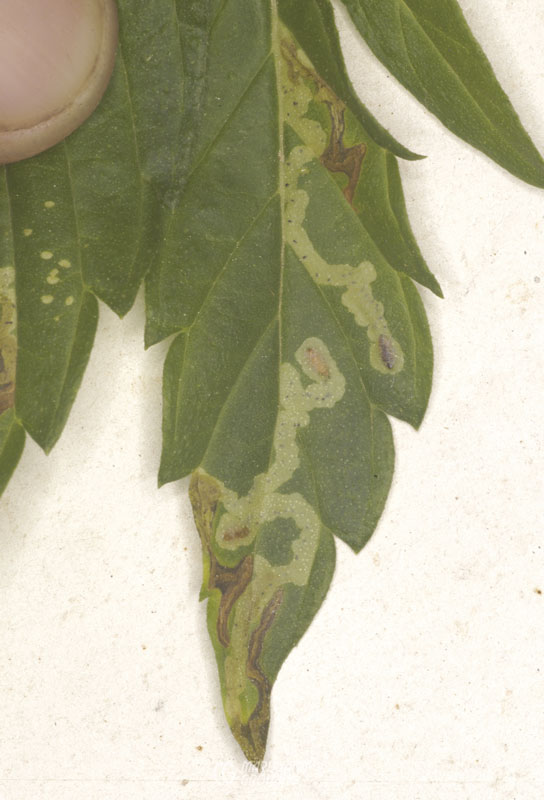
Leaf miners burrow between the surfaces of foliage, leaving telltale channels.
Fungus Gnats
Fungus gnat species that attack cannabis are from two families: Mycetophilidae and Sciaridae.
Garden threat: medium
Identify: Winged adult gnats are gray to black, long-legged flies with wings. Related to crane flies that also infest soil and root zones, fungus gnats are also called “sciarid flies” or “sciarids.”
Adults measure 0.06 to 0.125 inches (1.5–3.2 mm) long. Spot flies scurrying near plant bases and on growing media or foliage. Females deposit eggs in moist growing media. White to transparent larva with black heads feed on both dead and living plant tissue, including roots. Maggots (larvae) grow to 0.16 or 0.2 inches (4 or 5 mm) long. Fungus gnats are long with long legs. Look for them around the base of plants in soil and soilless gardens. They love the moist, dank environments in rockwool and the environment created in NFT-type hydroponic gardens. Adult females lay about 200 eggs every week to ten days. Fungus gnats are believed to spread plant disease pathogens in the media, so good control is important.
Damage: Fungus gnats infest growing mediums and roots near the surface. They can eat fine root hairs and scar larger roots when in large numbers and food is scarce, causing plants to lose vigor and foliage to turn pale. Fungus gnat damage can penetrate roots and stems when severe. Root wounds invite wilt fungi like Fusarium or Pythium, espe-cially if plants are nutrient-stressed and growing in soggy conditions. Maggots prefer to consume dead or decaying, soggy plant material; they also eat green algae growing in soggy conditions. Adults and larvae can get out of control quickly, especially in hydroponic systems with very moist growing mediums. The adult gnats stick to resinous buds like flypaper! The gnats are very difficult to clean from the buds.
Cause: Overly moist overfertilized soil or growing medium rich in organic nitrogen and green algae growth attract fungus gnats.
Prevention: Keep garden room, tools, supplies, and yourself clean. Do not overwater or overfertilize. Do not let green algae grow on substrate surface. Lower the humidity in the room. Cover air intakes with fine screens. Monitor for fungus gnat presence with yellow sticky traps set out at the base of plants.
Controls: The easiest control for these pests is with Vectobac, Gnatrol, or Bac-timos—all contain Bacillus thuringiensis var. israelensis (Bt-i). This strain of Bt controls the maggots; unfortunately, it is available only in one-gallon (3.8 L) containers. It is difficult to find at garden centers; check hydroponic stores.
Azadirachta (neem tree) kinoprene, difubenzuron, or cyromazine can also be effective. Gnatrol controls larvae, but it must be specific to gnats and not for caterpillar control.
Cultural and physical control: Do not overwater. Keep ambient humidity low. Do not let growing medium remain soggy. Cover growing medium so green algae will not grow. Yellow sticky traps placed horizontally one to two inches (2.5–5.1 cm) over growing medium catch adults.
Biological: Bt-i works best. Alternatives include the predatory soil mite Hypoaspis (Geolaelaps mites) and the nematode Steinernema feltiae.
Heavy-duty chemical controls include heavy soil drenches with malathion, acephate, or diazinon.
Pyrethrum (pyrethroids) works somewhat effectively, but repeat applications are necessary.
Gnats can be killed by disturbing or heating soil, by predatory wasps, and by applying insecticidal soap, neem, rotenone, or garlic oil to gnat infestations. It is best to control gnats proactively.
Sprays: Apply neem or insecticidal soap as a soil drench.
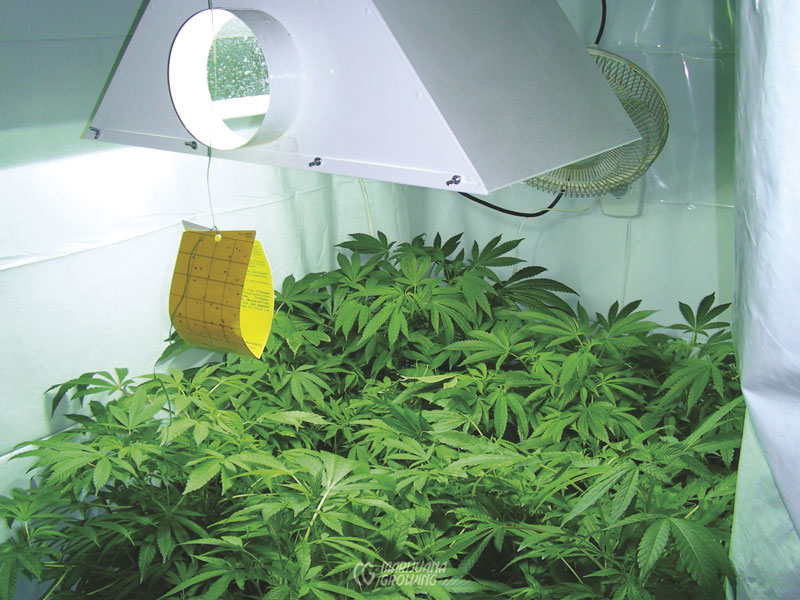
Fungus gnats often go unnoticed. A yellow sticky trap placed near substrate or above plant canopy helps monitor their presence.
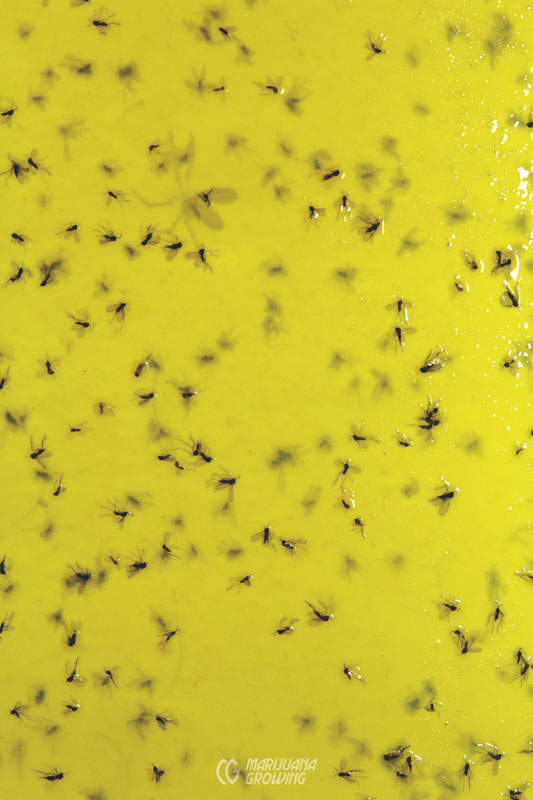
A close-up view of this yellow sticky trap reveals a fungus gnat infestation.
Mealybugs
Garden threat: medium
Mealybug species that attack cannabis include: long-tailed mealybug Pseudococcus longispinus
Identify: Somewhat common indoors, these 0.08 to 0.2 inch (2–5 mm) oblong, waxy-white insects move very little, mature slowly, and live in colonies that are usually located at stem joints. Like aphids, mealybugs excrete sticky honeydew.
Damage: Mealybugs suck sap from plants, slowing plant growth. They leave sticky honeydew in their wake, which attracts sooty mold and draws ants that eat the honeydew.
Cause: Mealybugs can be brought into the garden on contaminated plants or as the result of an unclean garden and surrounding garden area. Humans and animals transfer this pest at the crawler stage.
Prevention: Little damage is caused by these pests, and they are seldom presentin clean garden rooms. Outdoor and greenhouse growers must keep gardens clean and tidy to avoid infestations. They are most problematic during mid to late summer.
Control: Manual removal is tedious but very effective. Wet a Q-Tip in rubbing alcohol and wash scale away. A small knife, fingernails, or tweezers may also be necessary to scrape and pluck the tightly affixed mealybugs and scales after they are treated with alcohol.
Biological: There are numerous species of mealybugs. Each has natural predators, including species of ladybeetles (ladybugs) and parasitic and predatory wasps. There are so many species of each that it would be exhaustive to list them here. For more specific information, see Hemp Diseases and Pests.
Sprays: Homemade sprays that contain rubbing alcohol, nicotine, and soaps all kill these pests. Insecticidal soap, pyrethrum, and neem oil are all recommended.
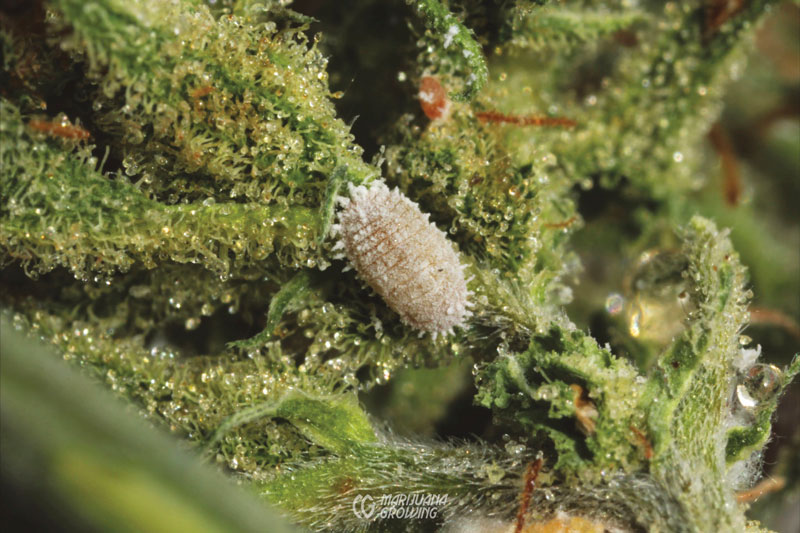
Mealybug (MF)
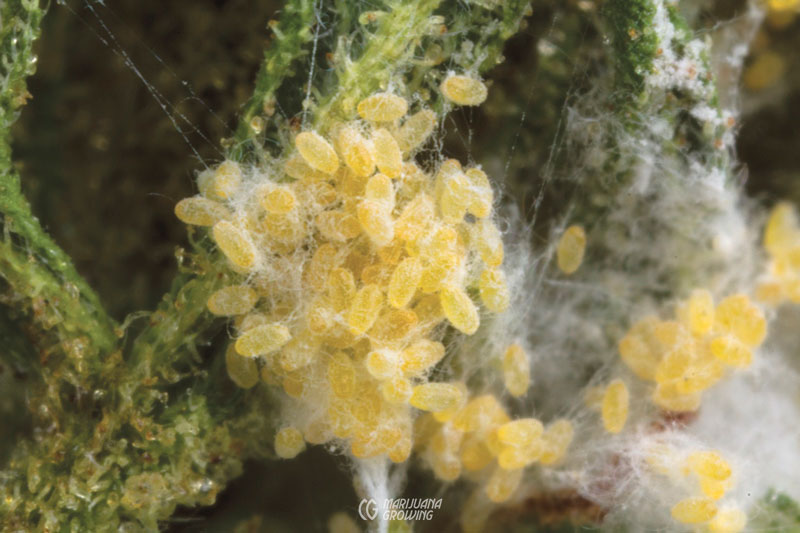
Mealybug eggs (MF)
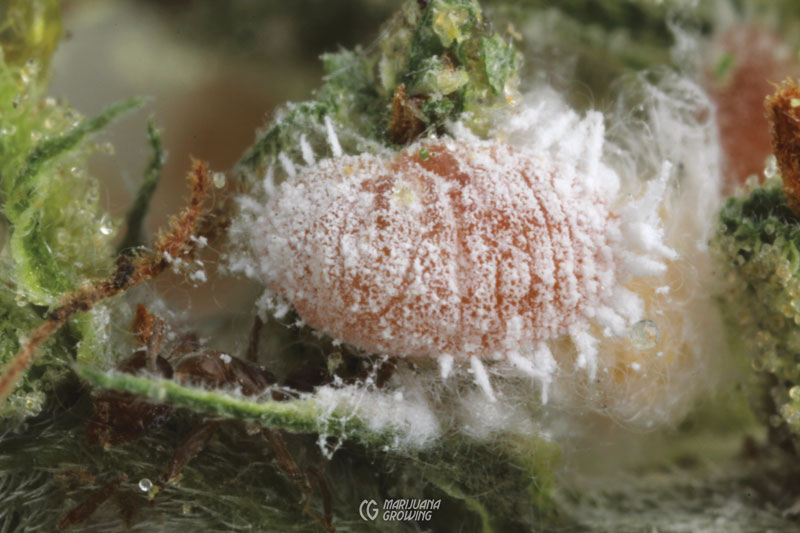
This photo of a Hibiscus mealybug was taken on an infested ‘Haze’ plant. Males have wings and are not stationary. Nymphs move and are known as crawlers. An immature female, pictured above, reaches maturity in a few weeks. (MF)
Scale
Common names: Scale
Scale species that attack cannabis include: cottonycushion scale (Icerya purchasi) European fruit lecanium (Parthenolecanium corni) hemispherical scale (Saissetia coffeae) white peach scale (Pseudaulacaspis pentagona)
Garden threat: low to medium
Identify: Scale looks and acts similar to mealybugs but is usually more round than oblong. Scales may be white, yellow, brown, gray, or black. Their hard protective shell is 0.08 to 0.15 inch (2–3.8 mm) across. Once established, mealybugs and scale rarely or never move. Check for them around stem joints where they live in colonies. Scales sometimes excrete sticky honeydew.
Damage: These pests suck sap from plants, which causes growth to slow. They also exude sticky honeydew as a by-product of their diet, which encourages sooty mold and draws ants that eat the honeydew.
Cause: Scale can be brought into the garden on contaminated plants or as the result of an unclean garden and surrounding garden area. Humans and animals transfer this pest on dirty tools, clothes, and so on.
Prevention: Keep garden and surrounding area clean. Do not bring in infested plants.
Controls: These pests present little problem to indoor growers. The easiest and most efficient control is listed under “Cultural and physical control” below.
Cultural and physical control: Man-ual removal is somewhat tedious but very effective. Wet a Q-Tip in rubbing alcohol and wash scale away. A small knife, fingernails, or tweezers may also be necessary to scrape and pluck tightly affixed mealybugs and scales after they are treated with alcohol.
Biological: There are numerous spe-cies of mealybugs and scales. Each has natural predators, including species of ladybeetles (ladybugs) and parasitic and predatory wasps. There are so many species of each that it would be exhaustive to list them here. For specific information, see Hemp Diseases and Pests.
Sprays: Homemade sprays that contain rubbing alcohol, nicotine, and soaps all kill these pests. Insecticidal soap, pyrethrum, and neem oil are all recommended.
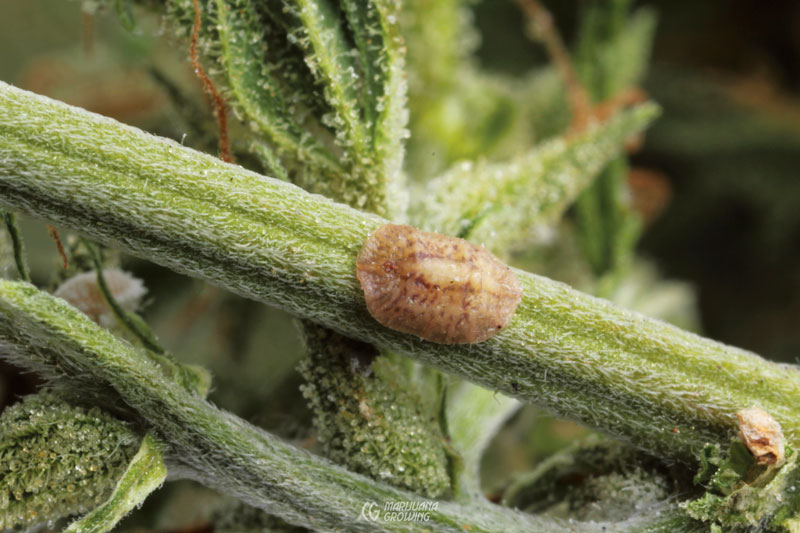
Scale on cannabis stem (MF)
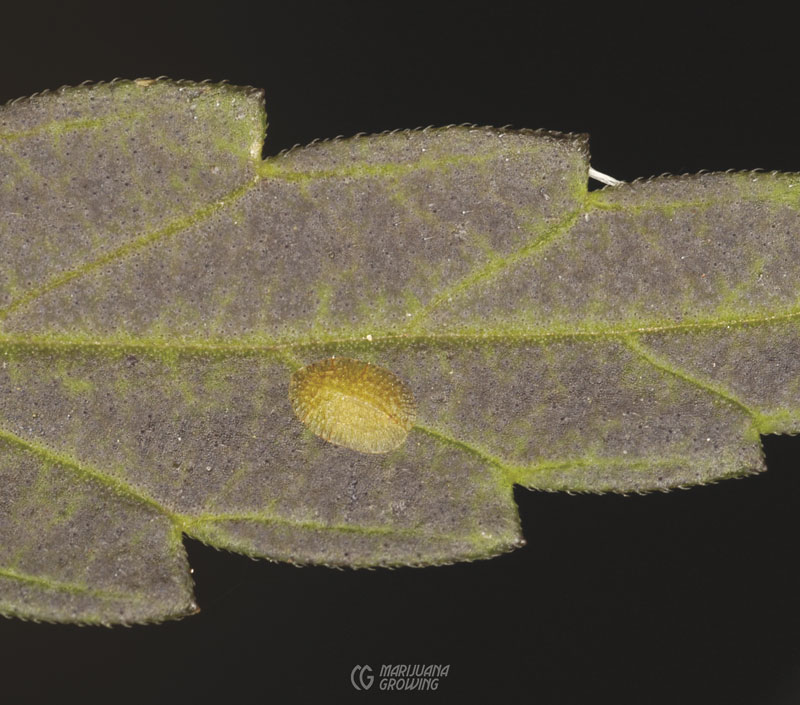
This little scale is living on the surface of a leaf.
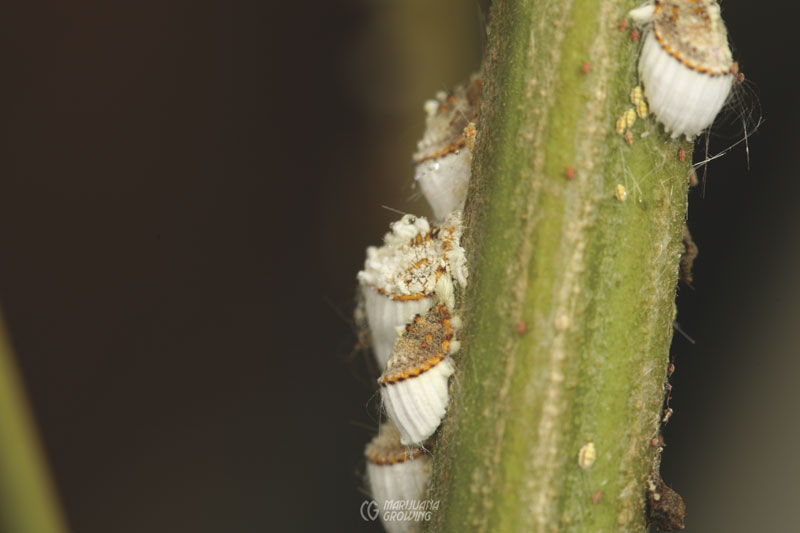
This colony of scale is living on the plant stem. They spread fast!
Nematodes
Common names: root-knot nematode, stem nematode, nematodes, needle worm, eelworm
Nematode species that attack cannabis include: cyst (Heterodera humuli Filipjev, H. schachtii Schmidt) needle (Paralongidorus maximus (Butschli) Siddiqi = Longidorus maximus (Butschli) Th. et Swang) root-knot (Meloidogyne incognita (Kofoid &White) Chitwood, M. javanica (Treub) Chitwood) stem (Ditylenchus dipsaci (Kühn) Filipjev)
Garden threat: low to medium
Identify: Of the 15,000 of species of microscopic nematodes, only a few are destructive to plants, including cannabis. Most often nematodes attack roots and are found in the soil; however, a few nem-atodes attack stems and foliage. Big ones are sometimes called eelworms. Others, called needle worms, can be seen only under a microscope. Root nematodes can often be seen in and around roots with the help of a 30X microscope. Often growers just diagnose the damage caused by destructive nematodes rather than actually seeing them. Do not confuse nematode symptoms with nematode attacks. If plants already have adequate water and nutrients, be sure to check for nematodes.
Damage: Slow growth, leaf chlorosis, wilting for several hours during daylight hours from lack of fluid flow—symptoms can be difficult to discern from nitrogen deficiency. Root-knot nematodes are some of the worst. Root damage is evidenced by swollen knots and galls. Lesion nematodes make reddish brown wounds and cause leaf yellowing when they scrape stems. Cut and scraped roots are compounded by fungal, viral, and bacterial attacks. Roots turn soft and mushy. Bad nematodes attack both hydroponic and soil gardens. Stem nematodes live aboveground, attacking foliage that then swells and yellows. Foliage later distorts and plants are stunted.
Cause: Nematodes spread from soil to hydroponic gardens in the wind and on equipment, pets, and people. Fungus gnats and their larvae also transport and spread nematodes. Unsterile, infected soil and water also carry nematodes. Prevention: Do not raise seedlings in soil and transplant to hydroponics.
Control: In soil, control with fumigation; in hydroponics, clean the system. Remove and destroy all plant material and growing medium. Disinfect and sterilize garden room with bleach.
Cultural and physical control: Cleanliness! Use new, sterilized potting soil or soilless mix to exclude nematodes’ entrance. Nematodes rarely cause problems indoors in clean garden rooms.
Biological: French marigolds (Tagetes patula) repel soil nematodes, as does the fungus Myrothecium verrucaria, trade name DiTera ES).
Sprays: Neem used as a soil drench.
Root Maggots
Common names: Root maggots, seedcorn maggot
Root maggot species that attack cannabis include: seedcorn maggot (Delia platura) cabbage maggot (Delia radicum)
Garden threat: low to medium
Identify: Both the seedcorn maggot and the cabbage maggot attack cannabis roots. The seedcorn maggot is 1.5 to 2 inches (3.8–5 cm) long. The seedcorn maggot converts into a fly that is a bit smaller than a common housefly. Cabbage maggots are 0.3 inch (0.8 cm) long, and the adult fly is bigger than a housefly. These pests winter over in unclean soil. In the spring they emerge as adult flies and soon lay eggs in the soil at the base of young plants. The squirmy, whitish larvae hatch several days later with a ravenous appetite.
Damage: Root maggots chew and burrow into stems and roots. The seedcorn maggot attacks seeds and seedling roots. Cabbage maggots attack roots, leaving hollowed-out channels and holes in larger roots. Both maggots destroy small, hairlike feeder roots. Wounds made byroot maggots also foster soft rot and fungal diseases.
Cause: unsterile soil or growing medium
Prevention: Cleanliness! Use fresh, new, store-bought soil when planting in containers. Cover seedlings with Agronet to exclude flies, and plant late in the year to avoid most adult flies. Place an 18-inch (45.7 cm) collar of foam rubber around the base of the plant to exclude flies.
Cultural and physical control: Biological: Control with nematodes Steinernema feltiae or Heterorhabditis bacteriophora.
Sprays: Kill root maggots with neem and horticultural oil used as a soil drench.
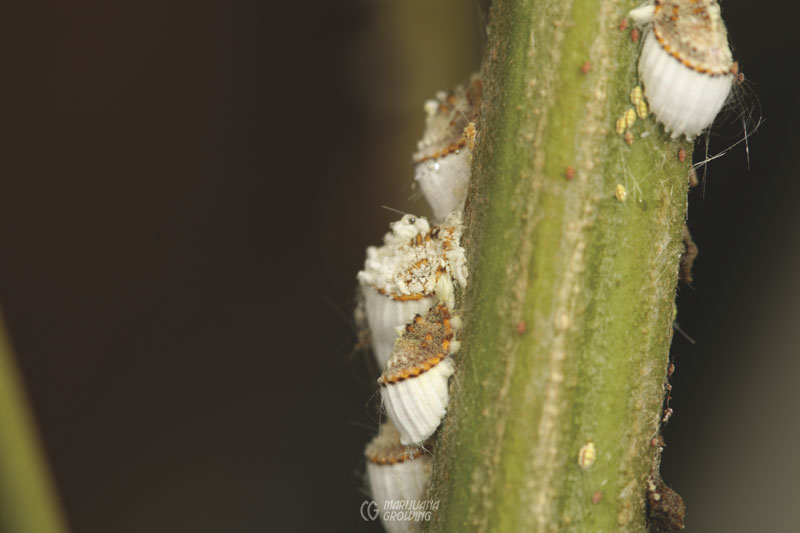
Root-knot nematodes cause growth to slow dramatically. Roots develop nodules and have a difficult time drawing in water and nutrients.
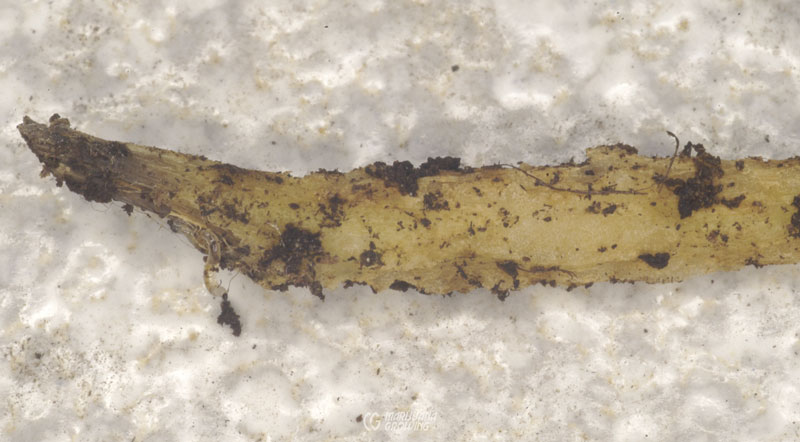
Root maggots ate this root down to a point. The little maggots consumed all the tender root hairs.
Seed Maggots
Common names: seed maggots, seed worms
Species that attack cannabis seeds include: Delia platura
Garden threat: low to medium
Identify: Several species of mites, (fly) maggots, and weevils attack stored seed. Once established, these pests are difficult to destroy.
Damage: Pests burrow into seeds and eat seeds and sprouted seeds.
Cause: contaminated seeds, pests already in the storage container, or pests allowed to enter seed storage area
Prevention: Mechanical damage of hempseed stimulates the breeding of mites.
Control: fungitoxic preparations (i.e., Panogen and Aldogen) The miticide Cinnamite (cinnamalde-hyde), produced by Mycogen, is very effective. Tyrophagus mites can be controlled by seed treatment. See “Cutworms” and “Crickets” in this chapter.
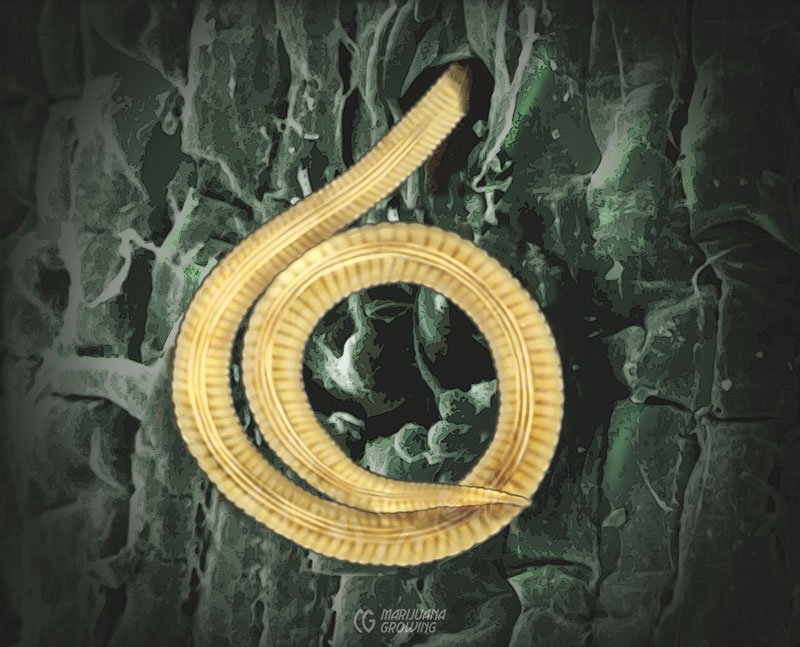
This minute nematode is entering a root to suck the life from the plant!
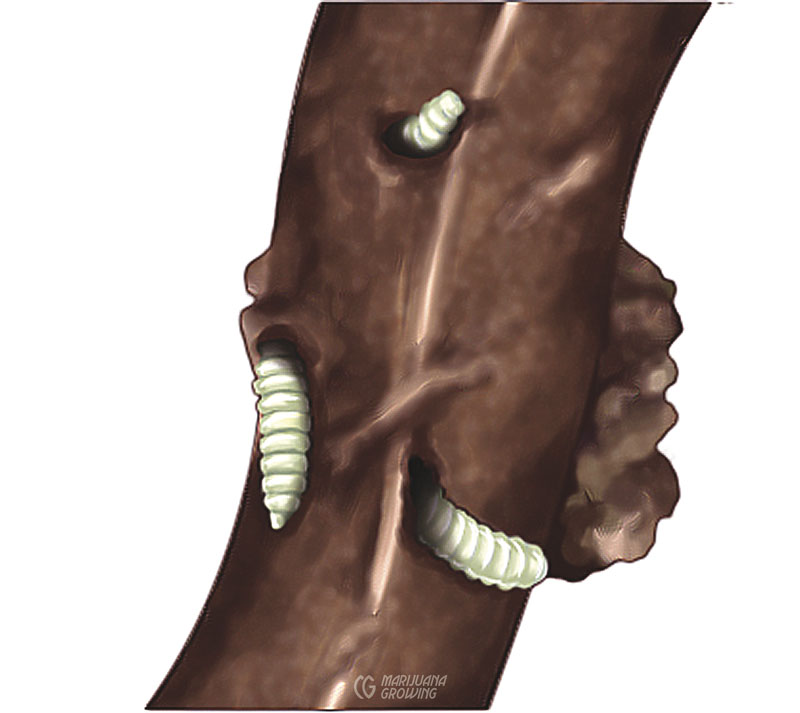
Root maggots are found in and around roots
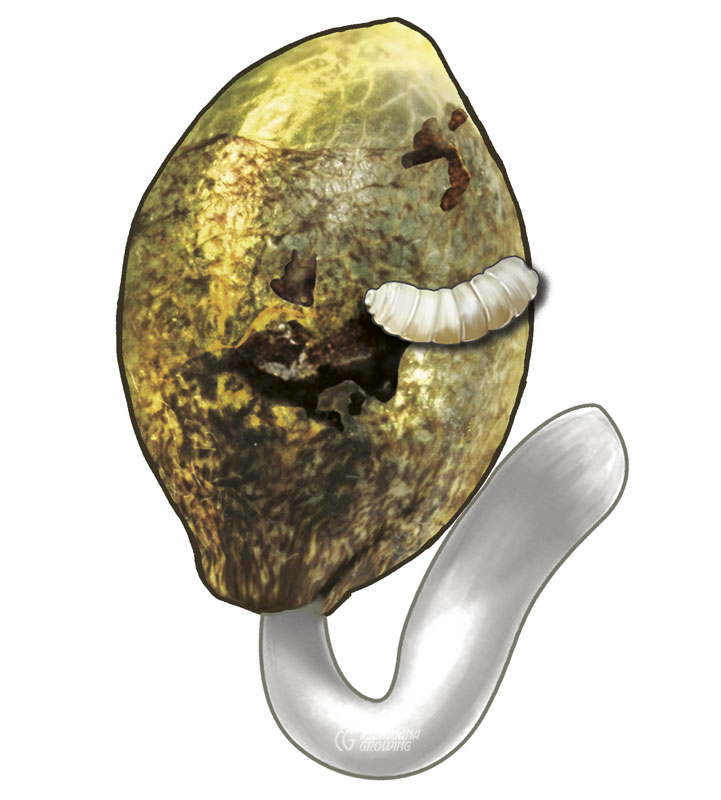
Seed maggots are relatively uncommon in cannabis seeds.
Slugs and Snails
Slug and snail species that attack cannabis include: (gastropods from the Mollusk phylum) Agriolimax species, Arion species, Helix aspersa, Deroceras reticulatum
Garden threat: high for tender seedlings, low as plants mature
Identify: Slugs and snails are soft and slimy white, dark, or yellow, occasion-ally striped. They are 0.25 to 3 inches (0.6–7.6 cm) long. Snails live in a circular shell; slugs do not. Slugs and snails hide by day and feed at night, leaving a slimy, silvery trail of mucus in their wake. They lay translucent eggs that hatch in about a month. Slugs and snails repro-duce prolifically, and the young mollusks often eat relatively more than adults.
Damage: Slugs and snails make holes in leaves, often with a weblike appearance. They will eat almost any vegetation, roots included. These creatures winter over in warm, damp locations in most climates. Slugs and snails especially like tender seedlings. They will migrate to adjacent gardens in quest of food
Cause: Snails and slugs overwinter in the soil and garden debris. They are distributed in unsterile soil and garden residue.
Prevention: Till garden soil and soil around garden perimeter to disrupt life cycle. Use clean tools and soil.
Control
Cultural and physical control: A clean, dry perimeter around the garden will make it difficult for slugs and snails to pass. Spotlight and handpick them at night. A thin layer of lime, diatomaceous earth, or salty beach sand about two to six inches (5–15 cm) wide around indi-vidual plants, beds, or the entire garden will present an impassable barrier. The lime is not thick enough to alter soil pH, yet it will repel or dissolve pests. To trap, attach short one-inch (2.5 cm) feet on a wide board and leave it in the garden. The pests will seek refuge under the board. Pick up the board every day or two, and shake the slugs off and step on them. Poisonous baits usually have metaldehyde as a base. Confine the bait to a slug hotel. Cut a 1 × 2-inch (2.5–5 cm) slot in a covered plastic container to make a slug and snail hotel. Place slug and snail bait inside the hotel. The hotel must keep the bait dry and off the soil. In a slug hotel, none of the poison bait touches the soil, and the bait is inacces-sible to children, pets, and birds. Place slug and snail hotels in out-of-the-way places. Natural baits include a mix of jam and water and beer. If using beer, it must be deep enough to drown mollusks.
Biological: The predatory snail Rumina decollata—available commercially—is yet another way to combat plant-eating slugs and snails.
Sprays: Young slugs and snails are not attracted to bait; spray for young at night or early morning with a 50 percent ammonia-water solution. After an hour, rinse off solution with water.
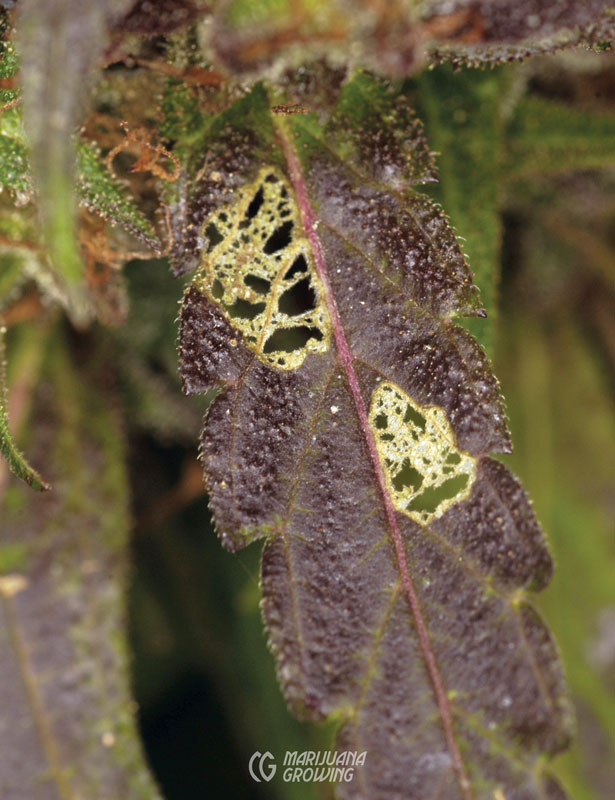
Snail damage

Slugs leave a slimy trail and can be a big problem in moist climates.

Deadline stays on the soil for weeks.
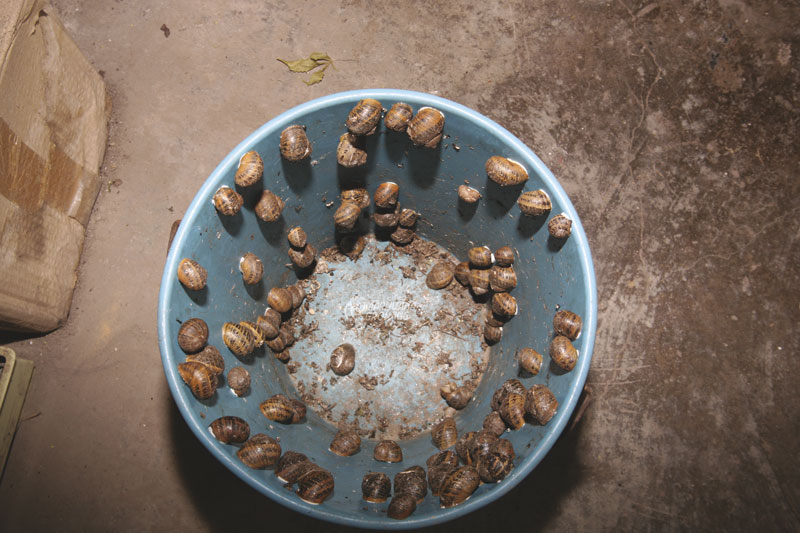
This gardener tossed snails into a bucket every time he found one. He fed the snails cornmeal for a week and sautéed them in garlic cannabis butter.
Spider Mites
Spider mite species that attack cannabis include: two-spotted spider mite (Tetranychus urticae, Acari: Tetranychidae. = Tetranychus bimaculatus, = Tetranychus telarius = Epitetranychus althaea) Spider mites have covered this male branch of flowers with webbing. They are congregating at the top of the plant because it is dead, and they do not know where to go! carmine spider mite (Tetranychus cinnabarinus, Acari: Tetranychidae. = Tetranychus telarius) hemp russet mite (Aculops cannabicola, A. (Vasates) cannabicola, Acari: Eriophyidae) oriental mite (Eutetranychus orientalis) privet mite (Brevipalpus obovatus, Acari: Tenuipalpidae, Brevipalpus rugulosus) ta ma mite (Typhlodromus cannabis, Acari: Phytoseiidae)
Garden threat: common in all garden rooms, especially untidy rooms
Identify: Find microscopic spider mites on leaf undersides, sucking away life-giving fluids. To an untrained naked eye, the 0.04-inch (1 mm) mites are hard to spot. Early infestations produce little visible evidence. Spider mites appear as tiny specks on leaf undersides; however, their telltale signs of feeding—yellowish-white spots, stippling on the tops of leaves—are easy to see. Stippling is virtually identical to damage caused by thrips. A magnifying glass or low-power microscope (10X to 30X) helps to identify the yellow-white, two-spotted brown or red mites and their translucent eggs. Indoors, the most common is the two-spotted spider mite, but many other mites attack cannabis.
After a single mating, females are fertilized for life. Females lay up to 20 eggs per day during a lifespan of two to four weeks. Eggs hatch in three days at 80ºF (26.7ºC). A single female can spawn a million mites a month in ideal conditions!
Accelerated reproduction allows mites to quickly adapt and become resistant to pesticides. Effective control measures must incorporate many different methods and products.
Damage: Mites suck life-giving sap from plants, causing overall vigor loss and stunting. Leaves are pocked with suck-hole marks and are yellow from failure to produce chlorophyll. Leaves lose partial to full function, and then turn yellow and drop. Once a plant is overrun with spider mites, tiny webs can easily be seen when misted with water. Spray water mist on suspect stems and under leaves as infestations progress. Severe cases cause plant death. Spider mites also function as vectors, spreading diseases as they mutilate foliage. Some estimates claim 60 percent of British Colombia, Canada, garden rooms are infested with spider mites.
Cause: Mites enter a garden on infested clones, plants, clothes, pets, etc., or they can blow in with the wind. Unclean growing conditions are the main cause of mites.
Prevention: Cleanliness is the most important first step to spider mite control. Keep the garden room and tools spotless and disinfected. Mother plants often have spider mites. Spray mothers regularly with miticides, including once just three days before taking cuttings. Dip cuttings in a miticide after roots have formed and before they are moved out of the clone room. Dip small plants again one week later.
If spider mites become established in a garden room, they are nearly impossible to exterminate. You must remove all grow equipment and plants and clean the entire garden room with a 5 percent bleach solution. You can also rent a wallpaper steamer to steam/sterilize cracks in the room.
Cultural and physical control: Spi-der mites thrive in a dry, 70ºF to 80ºF (21.1ºC–26.7ºC) climate, and reproduce every five days in temperatures above 80ºF (26.7ºC). Create a hostile environment by lowering the temperature to 60ºF (15.6ºC) and spray foliage, especially under leaves, with a jet of cold water. Spraying literally blasts mites off the leaves, as well as increases humidity. Manual removal works for small populations. Smash all mites in sight between the thumb and index finger, or wash leaves individually in between two sponges. Avoid infecting other plants with contaminated hands or sponges.
Remove leaves with more than 50 percent damage and securely destroy them, making sure insects and eggs do not reenter the garden. If mites have attacked only one or two plants, isolate the infected plants and treat them separately. Take care when removing foliage not to spread mites to other plants.
Severely damaged plants should be carefully removed from the garden and destroyed. Smear a layer of Tanglefoot around the lip of containers and at the base of stems to create barriers spider mites have a difficult time crossing. Spider mites can also stream a web strand and float to the next branch or plant. Avoid over-crowding. This will help isolate them to specific plants.
Note: To contain spider mites, smear a layer of Tanglefoot at each end of drying lines when hanging buds. Once foliage is dead, mites try to migrate down drying lines to find live foliage with fresh, flowing sap.
Biological: Neoseiulus (Amblyseius) californicus and Mesoseiulus Phytoseiulus) longipes, are the two most common and effective predators. Phytoseiulus persimilis, Neoseiulus (Amblyseius) fallacius, Galendromus (Metaseiulus) occidentalis, and Galendromus (Typhlodromus) pyri predators are also available commercially. When properly applied and reared, predatory spider mites work very well. Read the section “Beneficial Insects” in this chapter before ordering. There are many suppliers; just type “spider mite predator” into a web browser such as Google.
About predators: First, predators can eat only a limited number of mites a day; the average predator can eat 20 eggs or 5 adults daily. As soon as the predators’ source of food is gone, some mites die of starvation while others survive on other insects or pollen. Check with suppliers for release instructions related to specific species. A general dosage of 20 predators per plant is a good place to start. Predatory mites have a difficult time traveling from plant to plant, so setting them out on each plant is necessary. Temperature and humidity levels must be at the proper levels to give the predators the best possible chance to thrive. When spider mites have infested a garden, the predatory mites cannot eat them fast enough to solve the problem. Predatory mites work best when there are only a few spider mites. Introduce predators as soon as spider mites are seen on vegetative growth, and release them every month thereafter. This gives predators a chance to keep up with mites. Before releasing predators, rinse plants thoroughly to ensure that toxic- spray residues from insecticides and fungicides are gone.
Persimilis (Phytoseiulus persimilis) will destroy spider mites Progressive control measures for spider mites
Cleanliness: Clean the garden room daily and disinfect tools. Do not introduce new pests into the garden on clothes. No animal visits, etc.
Create hostile environment: humidity, temperature, water spray
Create barriers: Smear Tanglefoot around pot lips, at the base of stems, and on the ends of drying lines.
Dip cuttings and vegetative plants: Dip small plants in pyrethrum, horticultural oil, or neem oil.
Remove damaged foliage: Removefoliage that is more than 50 percent damaged.
Introduce predatory mites: Release predators before infestations get out of hand. Homemade sprays often lack the strength to kill infestations, but they work as a deterrent by repelling mites. Popular homemade sprays include Dr. Bronner’s soap, garlic, hot pepper, citrus oil, and liquid seaweed combinations. If these sprays do not deter spider mites after four to five applications, switch to a stronger spray such as neem oil, pyrethrum, horticultural oil, nicotine sulfate, or cinnamaldehyde. Insecticidal soap does a fair job of controlling mites. Usually two or three applications at five- to ten-day intervals will do the trick. Horticultural oil smothers eggs and can be mixed with pyrethrum and homemade sprays to improve extermination.
Rotate sprays so mites do not develop immunity.
Spray: Pyrethrum (aerosol) is the best natural miticide! Apply two to three applications at five- to ten-day intervals. Pyrethrum is the best control for spider mites. Spider mites should be gone after two or three applications at five- to ten- day intervals, providing that sanitary preventative conditions are maintained. Eggs hatch in five to ten days. The second spraying will kill the newly hatched eggs and the remaining adults. The third and subsequent applications will kill any new spider mites, but mites soon develop a resistance to synthetic pyrethrum.
There are no pesticides registered for hemp growing. This is a bridge that will be crossed as cannabis becomes legal.
Neem Oil
Heavy-duty chemical miticides are available but are not recommended for use on plants that will be consumed by humans. If using any chemical miticide, be sure it is a contact poison and not systemic. Use Stirrup M (cinnamaldehyde) extracted from Cinnamomum zeylanicum. The synthetic hormone attracts spider mites, and is used very successfully to enhance miticides.
Miticides: acaricides
Miticides: The organotins are a group of acaricides that double as fungicides. Of particular interest is Plictran (cyhexatin).
Floramite is a contact miticide, and thorough coverage is essential. This miticide is active on all mite life stages, including eggs. Do not apply less than a week before harvest.
TetraSan is a growth regulator for mites, inhibiting the molting process to control mites in greenhouses and on outdoor ornamentals. It is a contact and translaminar miticide that leaves four weeks’ residual control after one application. It is effective on all stages of life; even adult females become sterile.
Vendex: This product is a restricted-use pesticide
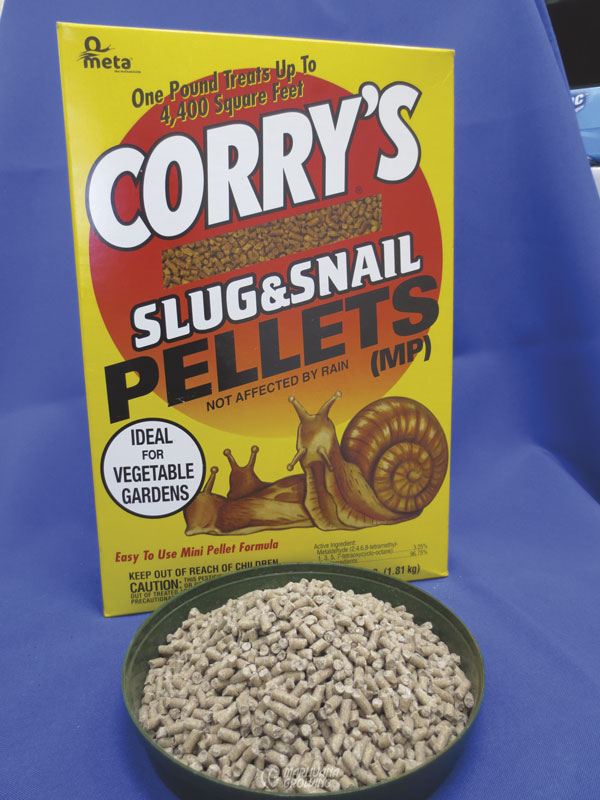
Slug and snail
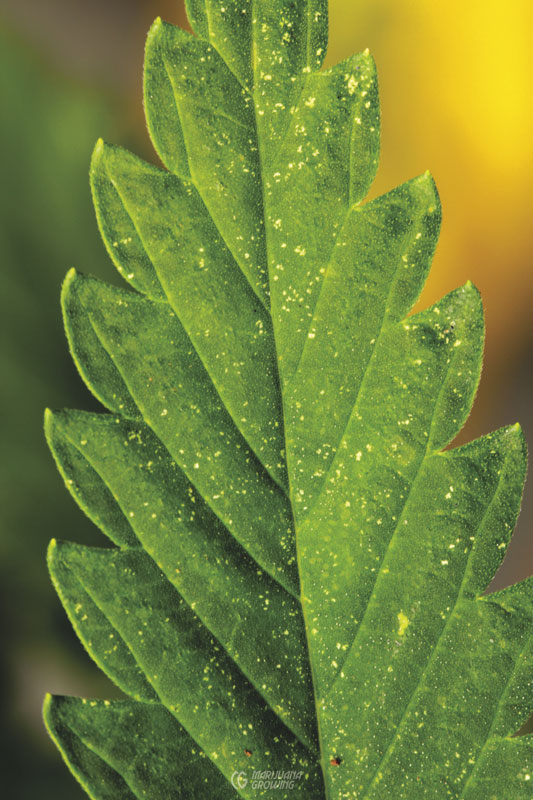
Spider mites stippled this leaf.
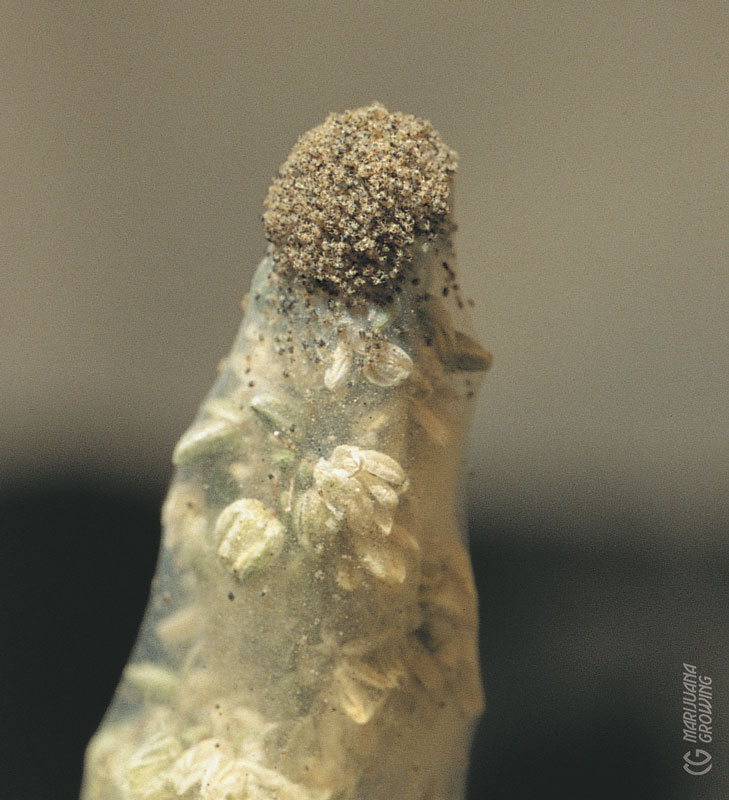
Spider mites have covered this male branch of flowers with webbing. They are congregating at the top of the plant because it is dead, and they do not know where to go!
Broad/Cyclamen Mites
Garden Threat: low to high
Common Names: Broad mite, yellow tea mite, citrus silver mite, tropical mite, chilli mite, jute white mite, rubber leaf mite. Cyclamen mite, Stenotarsonemus pallidus
Broad Mite Species that Attack Cannabis include: Polyphagotarsonemus latus, Acari species
Common names: broad mite, yellow tea mite, citrus silver mite, tropical mite, chilli mite, jute white mite, rubber leaf mite, cyclamen mite (Stenotarsonemus pallidus)
Broad mite species that attack cannabis include: Polyphagotarsonemus latus, Acari species Broad mites (Polyphagotarsonemus latus) and cyclamen mites (Stenotarsonemus pallidus ) are very similar in their life cycle and the damage they cause, so they are together in this section. First they are distinguished, and then symp-toms and control measures are lumped together.
Broad mites and cyclamen mites live and breed on many plants, including cannabis. They migrate to lower leaves and infest plants quickly. The symptoms can easily be confused with nitrogen deficiency. They do not make spiderwebs.
Garden threat: low to high
Identify broad mites: Aggressive adult mites are microscopic, about 0.1 mm long with eight legs. Larvae have six legs and are hungry at hatch. They are less than half the size of the red spider mite. Soft-bodied nymphs move fast. Color is translucent white and yellowish and other light tones. Broad mites reproduce most prolifically at temperatures between 70ºF to 80ºF (21.1ºC–26.7ºC). The long eggs (0.08 mm) have a series of about 30 whitish bumps, an oval shape with protruding circular surface, and they stick hard to the leaves. The adult has a dark dorsal band. Each female can produce 40 to 50 eggs in a lifetime. They hatch in two to three days—with an appetite. After eating for two to three days, they start the pupal stage en route to adulthood.
Identify cyclamen mites: Less than 0.2 mm long, these waxy looking mites have four pairs of legs and range from colorless to green or brownish. Cyclamen mites share many characteristics with broad mites. Male cyclamen mites have a very strong claw mounted at the end of each fourth leg.
These mites avoid light and prefer high humidity and cool 60ºF (15.6ºC) temperatures. They hide inside buds, under leaves, and in any protected place on foliage. Eggs are smooth and hatch in about 11 days when deposited in dark, moist locations.
Damage: Mites secrete a plant growth regulator or toxin as they feed. And af ew mites can cause a lot of damage fast! Feeding damage deforms and distorts young buds and leaves. Leaf edges can curl up or entire leaves can cup down, pucker, crinkle, become brittle, and show signs of scarring. Internodes shorten, growing tips are stunted, and overall growth is underdeveloped. New growth can blacken and die. Damage resembles herbicide damage and can also be confused with viral disease, micronutrient deficiency, or herbicide injury.
Damage may appear for weeks after the mites have been controlled. Damage is usually not detected until significant damage is incurred. Damaged foliage will not recover. A microscope will be necessary to detect the actual mites; a handheld loupe is not powerful enough to see them.
Cause: Microscopic or micro-mites are able to walk short distances and are dispersed long distances by wind or by attaching themselves to people, tools, or a winged insect (aphid, whitefly, etc.) and hitching a ride. Male mites actually transport eggs to new foliage. They migrate to cannabis from many plants, including but not limited to houseplants, African violets, cyclamen, begonias, snapdragons, impatiens, gerbera daisies, fuchsias, daisies, azaleas, ivy, camellias, jasmine, lantana, marigolds, grapes, and vegetable hosts—beets, beans, cucumbers, eggplants, peppers, potatoes, and tomato plants. Mites are also common greenhouse pests in some crops.
Prevention: Cyclamen mites cannot take temperatures above 92ºF (33.3ºC) but the spider mite will. If you drop the humidity to 30 percent, they cannot develop into adults. But the conditions in most garden rooms are perfect for spider mites to thrive. Do not let broad mites enter the garden room or greenhouse. They are more difficult to prevent, and they thrive in hot conditions. Use certified pest-free growing mediums. Keep the garden room very clean. Wear clean clothes and shoes into the garden room and greenhouse. Do not grow ornamental or food plants that attract cyclamen or broad mites.
It is important to eliminate broad mites before flowering because plants cannot recuperate if they go into flowering with broad mite damage.
Control Biological: Locally occurring mite predators give satisfactory control in many areas. Two natural enemies—Euseius stipulatus and Typhlodromus ovalis are being evaluated as biocontrol agents of these mites.
Amblyseius californicus eats red spider mites and broad mites Polyphagotarsonemus latus. If there is no food for the predators, they leave or die. Amblyseius californicus can also eat pollen to maintain themselves. The strawberry (Ricinus communis L.) and margaritas (genebra) are some of the foods with pollen.
Sprays: Broad mites and cyclamen mites are not susceptible to some dinitrophenol compounds and synthetic pyrethroids. Submerging plants completely in a miticide dip is very effective to treat small plants. Fenbutatin, diazinon, and dicofol (Kelthane)—all very harsh chemicals that I do not recommend— have been effective in the control of mites.
| BRAND NAME | ACTIVE INGREDIENT | SAFETY | RESIDUAL DAYS |
| Avid | Streptomyces avermitilis | DO NOT USE | 28 |
| TetraSan | etoxazole | DO NOT USE | 28 |
| CHEMICAL INSECTICIDES AND MITICIDES | |||
| Trade Name* | Active Ingredient | Safe for Cannabis | Notes |
| Akari SC | tert-butyl | No | Do not use in successive applications. |
| Avid | abamectin | No | Produced by soil fungi, Streptomyces species |
| Brigade | bifenthrin | No | Systemic miticide/insecticide, DO NOT USE |
| Floramite | bifenazate | Limited | Apply only once then rotate to another miticide. |
| Forbid 4F | spiromesifen | No | Systemic miticide/insecticide, DO NOT USE |
| Hexygon W | hexythiazox | No | Systemic miticide/insecticide, DO NOT USE |
| Judo | spiromesifen | No | Systemic miticide/insecticide, DO NOT USE |
| Kelthane | dicofol | No | Selective miticide, DDT relative, DO NOT USE |
| Mavrik | tau-fluvalinate | No | Systemic miticide/insecticide, DO NOT USE |
| Orthene | acephate | No | Systemic miticide/insecticide, DO NOT USE |
| Ovation SC | clofentezine | No | Systemic miticide/insecticide, DO NOT USE |
| Pentac | dienochlor | No | Canceled! |
| ProMITE | fenbutatin-oxide | No | Systemic miticide/insecticide, DO NOT USE |
| Pylon | chlorfenapyr | No | Systemic miticide/insecticide, DO NOT USE |
| Pyramite | pyridaben | No | Systemic miticide DO NOT USE |
| Sanmite SC | pyridaben | No | Systemic miticide DO NOT USE |
| Savey | hexythiazox | No | Systemic miticide/insecticide, DO NOT USE |
| Shuttle O | acequinocyl | No | Systemic miticide/insecticide, DO NOT USE |
| Sirocco | bifenazate/abamectin | No | Systemic miticide/insecticide, DO NOT USE |
| Temik | aldicarb | No | Systemic miticide DO NOT USE |
| TetraSan | diphenyloxzoline | No | Do not apply more than twice per crop |
| Ultiflora | milbemectin | Yes | Derived from soil microorganisms and fermentation |
| Vendex | fenbutatin-oxide | No | Systemic miticide/insecticide, DO NOT USE |
| Whitmire Beethoven | etoxazole | No | Toxic to fish and aquatic organisms |
| Zeal | etoxazole | No | Systemic miticide DO NOT USE |
*Not all trade names are included. Check insecticides and miticides for chemical names.
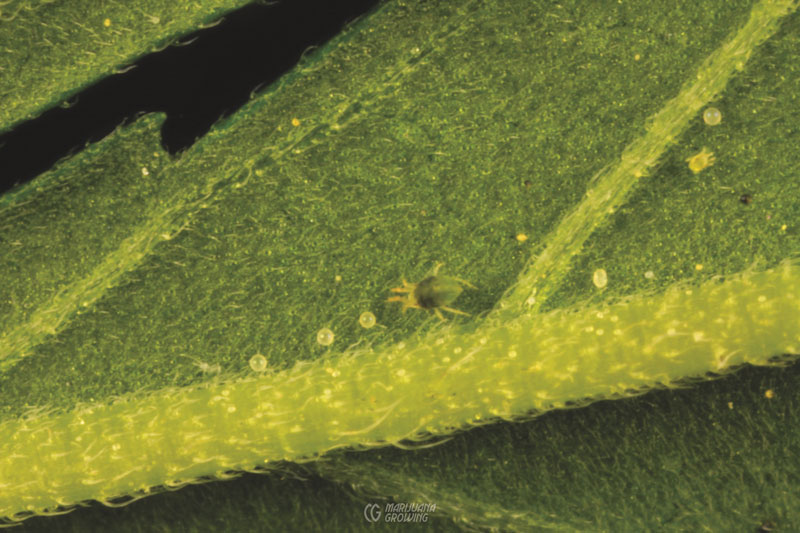
Spider mite adults, juveniles, and eggs on a leaf underside (MF)
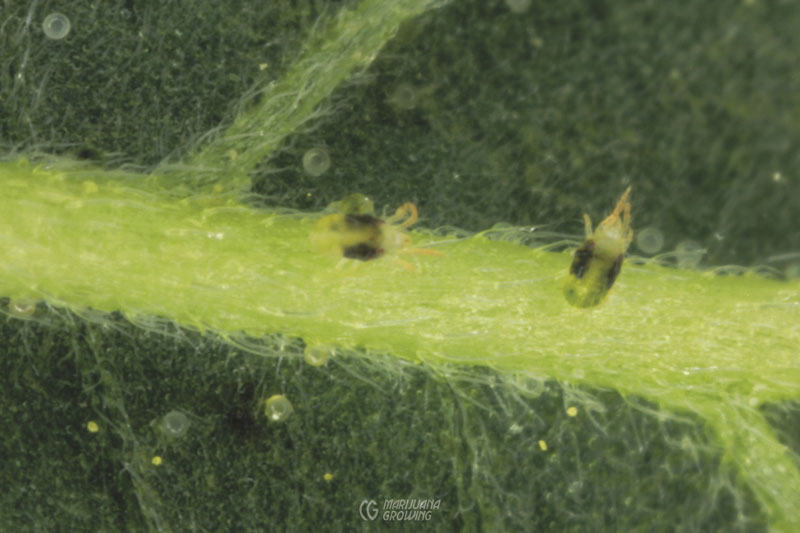
Close-up of spider mite adults and eggs (MF)
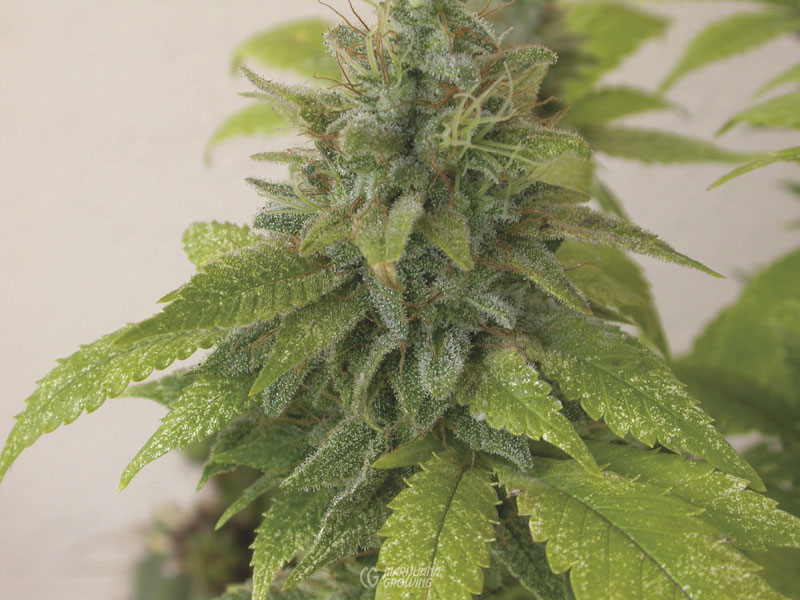
Stippling on leaves is the clue that spider mites live on the undersides.
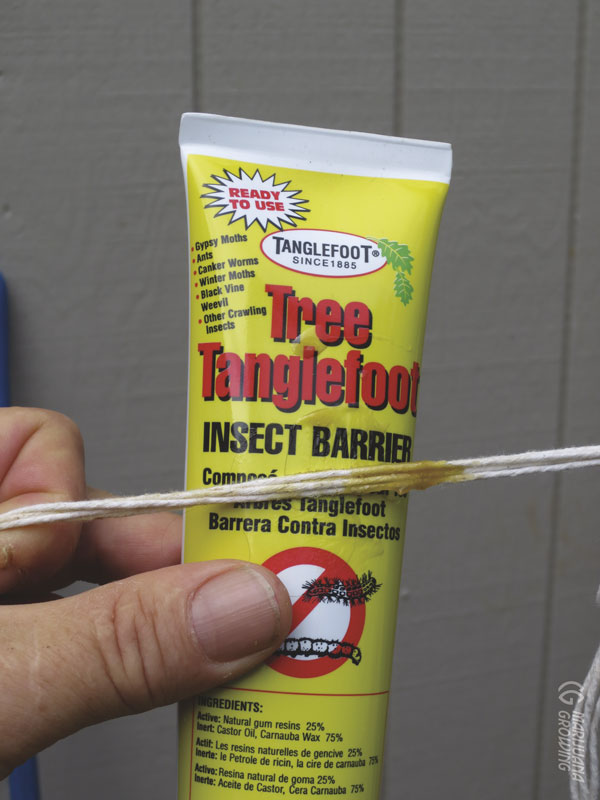
Tanglefoot is an excellent product to help contain spider mites. Smear it around the lip of containers, the base of stems, and at the end of drying lines.
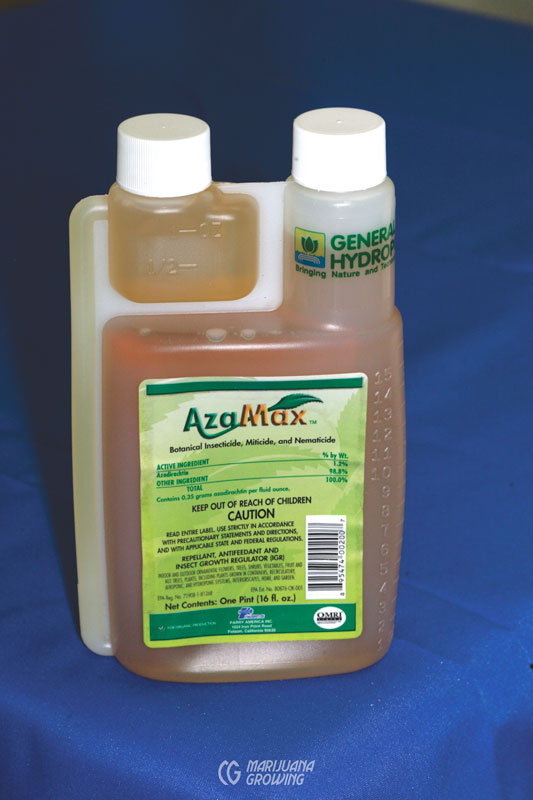
AzaMax is developed from neem seed and very potent.
Hemp Russet Mites
Garden Threat: low to high
Common Names: hemp russet mite, mites
Hemp Russet Mite species that attack cannabis include: Aculops cannabicola
Identify: Hemp russet mites are not well-known but this appalling pest is growing in infamy because it is so hard to control. The mites are very small reaching only 0.2 mm in length and they have just two pairs of legs attached to their pale beige bodies. Even though hemp russet mites are virtually impossible to see with the naked eye, they are easy to distinguish from other destructive mites because they leave no webbing. At 80ºF (27ºC) hemp russet mites achieve a 30-day life cycle.
Damage: Feeds on all types of cannabis plants. They live and feed mainly on leaves, petioles, and meristems. Feeding damage causes leaflets to curl at edges followed by chlorosis and necrosis. Leaves and petioles become brittle. Infestations turn leaves beige with hemp russet mite bodies! Mites feed on female stigmas rendering them sterile. They also consume resin glands which can reduce resin production severely. Hemp russet mites feed on cannabis plants until host is dead. They congregate on the upper part of the plant as it dies. Hemp russet mites vector viruses.
Cause: Introduced to gardens by unsanitary practices, contaminated stock and bad luck. Hemp russet mites hide on plants indoors and in greenhouses. They are believed to overwinter on contaminated seed indoors and outdoors. The minute mites spread easily to nearby plants by splashing water. Wind also carries them greater distances.
Prevention: Keep garden area clean and disinfected. Introduce only pest-free stock into gardens. Disinfect seeds. Keep the garden below 70ºF (21ºC) and below 50% humidity to slow reproductive process. Remove seriously damaged foliage and plants from garden.
Control Biological: The fungus, Hirsutella thompsonii, is a pathogen to hemp russet mites, but I have not seen it available commercially.
Sprays: Miticides and sulfur sprays are somewhat effective. Make sure to get complete foliage coverage when spraying.
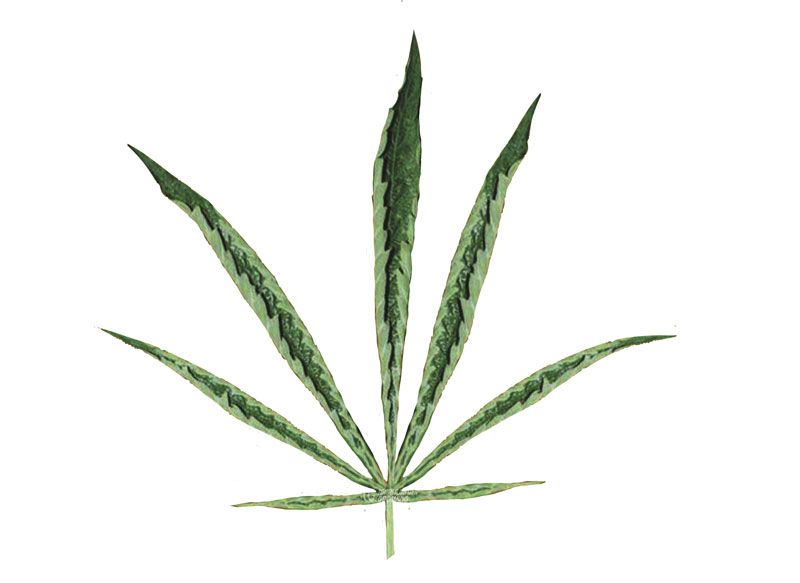
This leaf shows signs of a severe infestation of hemp russet mites.
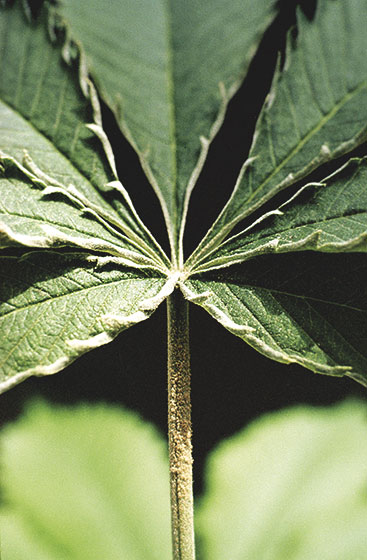
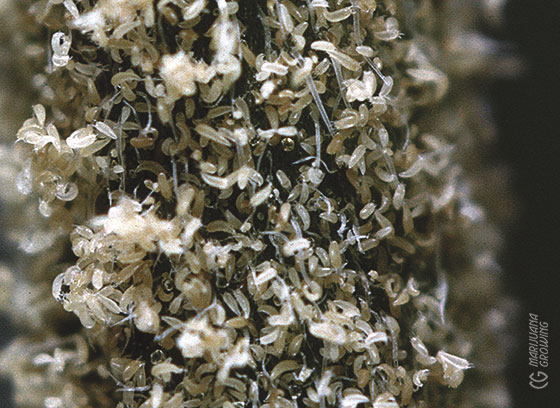
These microscopic hemp russet mites (Aculops cannabicola) infested Cannabis plants in a secure greenhouse at Indiana University. This picture by Karl Hilling shows them on a leaf petiole that was about 2 mm wide.
Termites
Common names: termites, wood termites
Termite species that attack cannabis include: Odontotermes obesus (Isoptera: Termitidae)
Garden threat: low indoors moderately high outdoors
Identify: Termites can be a big problem in outdoor gardens. They are worse near wooded areas, and they have been a big problem in California and warm states in the southern USA and similar climates. They live entirely underground or in elevated tubes.
Damage: Termites like weak and dead plants more than they like wood. Weak, diseased plants will attract termites. Termites eat roots and gnaw away at stems. In fact, they can even burrow through the center of stems and kill plants. Termites are seldom noticed until damage occurs.
Cause: Termites are present in rotten wood or decaying plant matter near the garden.
Prevention: Spray termite insecticide around the perimeter of the garden. Set termite bait in the garden and outside garden structures. Paint exposed wood in garden with a borate to disrupt termite life cycle. Avoid mulching plants with woodchips.
Replace the wood with a slow-acting pesticide available at your local home and garden store. The pesticide will be spread through the colony when the termite returns home.
Control: Locate termite colonies in attics, walls, and in underground burrows under and near buildings. Spray each colony and the surrounding area. Control requires that termites are physically prevented from entry, which is very difficult, or the colony must be eradicated.
Biological: Add natural predators to your environment. Encouraging ants, flies, and spiders around your home is one way to keep termites out—they’ll eat them! Frogs are also good predators. Sprays: Terminix or Spectracide stakes are often used to control termites. They come in a box of 20 ($70 USD) with a drill bit to put them in the soil. The active ingredient is 0.1 percent and is slow-acting bait so the termites can take it back to the mound. The bait does not release into the soil nor does the plant pick it up.
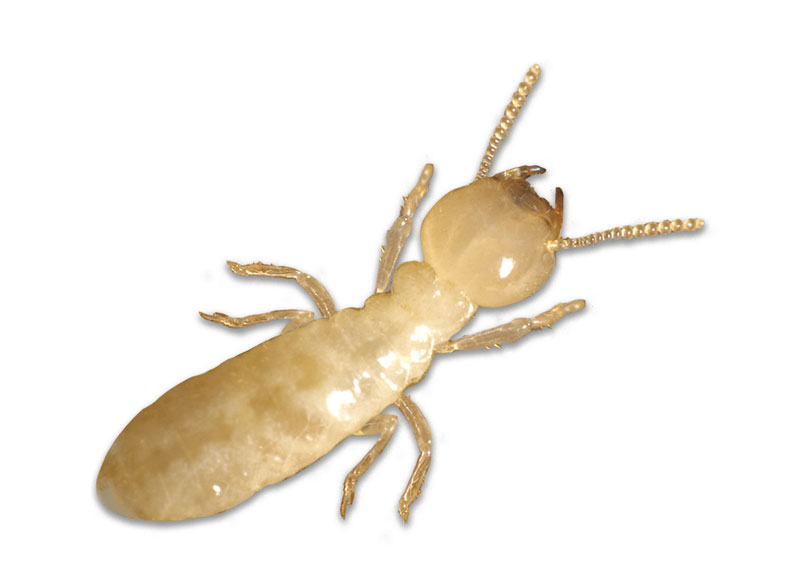
Termites are most common in wooded areas.
Thrips
Common names: greenhouse thrips, western flower thrips, onion thrips
Thrip species that attack cannabis include: greenhouse thrips (Heliothrips haemorrhoidalis) onion (tobacco) thrips (Thrips tabaci) marijuana thrips (Oxythrips cannabensis
Indian bean thrips (Caliothrips indicus) western flower thrips (Frankliniella occidentalis)
Attacks: foliage
Attacks: roots
Garden threat: low to high both indoors and outdoors
Identify: These tiny, winged, fast-moving critters are hard to see but not hard to spot. From 0.04 to 0.05 inch (1–1.3 mm) long, thrips can be different colors, including white, gray, and dark colors, often with petite stripes. Check for them under leaves by shaking parts of the plant. If there are many thrips present, they choose to jump and run rather than fly to safety. But often you will see them as a herd of specks thundering across foliage. Females make holes in soft plant tissue where they deposit eggs that are virtually invisible to the naked eye. Winged thrips easily migrate from infested plants to the entire garden. Several different thrips attack cannabis; some, known as marijuana thrips, are specific to cannabis. Thrips are more common in greenhouses than indoors.
Damage: Thrips rasp and scrape tissue from leaves and buds, and then suck out the sap for food. Stipples—whitish-yellowish to silvery specks—appear on top of leaves; chlorophyll production diminishes and leaves become brittle. You will also see black specks of thrip feces and little thrips. Many times thrips feed inside flower buds or wrap up and distort leaves. Thrips prefer succulent young leaves and flowering tops. Common thrips often eat female calyxes, causing deformed flower tops.
Cause: Thrips enter the garden on contaminated plant stock and on gardeners, tools, and pets as a result of an unclean garden and garden area.
Prevention: Cleanliness! Use yellow sticky traps, which attract thrips, to monitor populations and impair movement. Misting plants with water impairs thrips. Manual removal works okay if only a few thrips are present, but they are hard to catch. Thrips can be very vexing to control once they become established. Thrips migrate daily. They hide in soil and foliage and feed actively in the mornings. The best time to kill them is during feeding. Soil treatments work well too.
Control Biological: Predatory mites (Amblyseius cucumeris and Amblyseius barkeri, Neoseiulus cucumeris, Iphiseius degenerans, Neoseiulus barkeri, Euseius hibisci), parasitic wasps (Thripobius semiluteus, Ceranisus menes, Goetheana shakespearei), pirate bugs (Orius species). The fungus Verticillium lecanii is effective.
Sprays: Homemade sprays such as tobac-co/nicotine (nicotinic acid) base; com-mercial pyrethrum, synthetic pyrethrum, insecticidal soap, and garlic. Apply two to four times at five- to ten-day intervals.
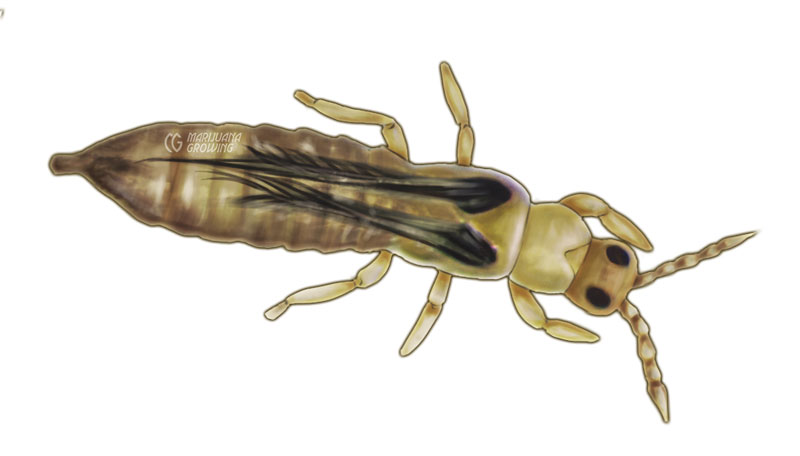
Thrip
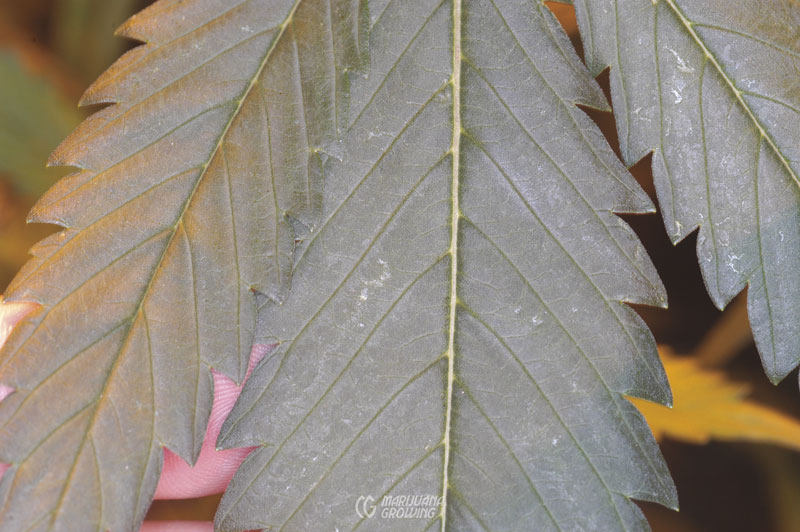
Thrips rasp the top of leaves.
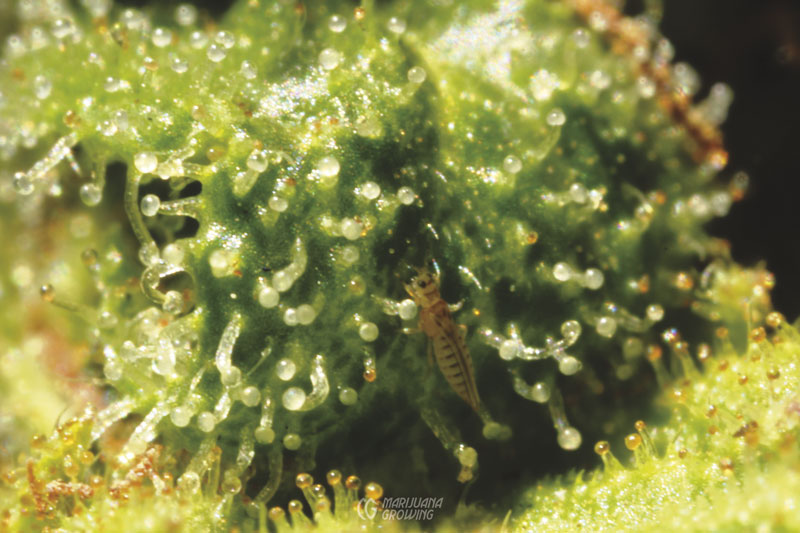
Thrips will attack cannabis in all stages of life. (MF)
Whiteflies
Common names: greenhouse whitefly, sweet potato whitefly, tobacco whitefly, silverleaf whitefly
Whitefly species that attack cannabis include: greenhouse whitefly (Trialeurodes vaporiorum, Homoptera: Aleyrodidae) sweet potato aka tobacco whitefly
(Bemisia tabaci, Homoptera: Aleyrodidae, = Bemisia gossypiperda) silverleaf whitefly (Bemisia argentifolii, Homoptera: Aleyrodidae, = Bemisia tabaci (strain B)
Garden threat: low to high, worse in hot climates
Identify: The easiest way to check for the little buggers is to grab a limb and shake it. If there are any whiteflies, they will fly from underneath leaves. White- flies are easily spotted with the naked eye. Whiteflies look like a small, white moth about 0.04 inches (about 1 mm) long, approximately the size of the tip of a pencil lead. Adult whiteflies have wings. They usually appear near the top of the weakest plant first. They will move downward on the plant or fly off to infest another plant. Eggs are also found on leaf undersides, where they are connected with a small hook. Whiteflies behave very much like spider mites do.
Damage: Whiteflies hide underneath leaves and suck sap from them. Like mites, whiteflies may cause white speckles known as stipples on the tops of leaves. Chlorophyll production and progresses. Whiteflies leave residue on foliage that attracts harmful fungi and diseases.
Cause: unclean garden room, sloppy hygiene
Prevention: Cleanliness! Screen the incoming air.
Control
Cultural and physical control: Adults are attracted to the color yellow. To build a whitefly trap similar to flypaper, cover a bright, yellow object with a sticky substance like Tanglefoot. Place the traps on tops of pots among the plants. Traps work very well. When they are full of insects, toss them out.
Biological: The (assassinator) wasp Encarsia formosa, released before an infestation of whiteflies, is the most effective parasitic control. These small wasps only attack whiteflies; they do not sting people. Set new wasps in the garden every two weeks. All toxic sprays must be completely washed off plants before introducing parasites and predators. Since Encarsia formosa is a parasite about 0.125 inch (about 3 mm) long— smaller than the whitefly—it takes them much longer to control or even keep the whitefly population in check. The parasitic wasp lays an egg in the whitefly larva that later hatches and eats the larva alive, from the inside out—death is slow. If you use Encarsia formosa, set them out at the rate of two or more parasites per plant as soon as the first whitefly is detected. Repeat every two to four weeks throughout the life of the plants. The fungus Verticillium lecanii aka Cephalosporium lecanii, trade name Mycotal, is also very effective as whitefly control.
Sprays: Easily eradicated with natural sprays, pyrethrum works great to kill whiteflies when they are airborne. Before spraying, remove any leaves that have been over 50 percent damaged and cure with heat or else burn infested foliage. Homemade sprays applied at five- to ten-day intervals work well. Insecticidal soap applied at five- to ten-day intervals. Pyrethrum (aerosol) applied at five- to ten-day intervals.
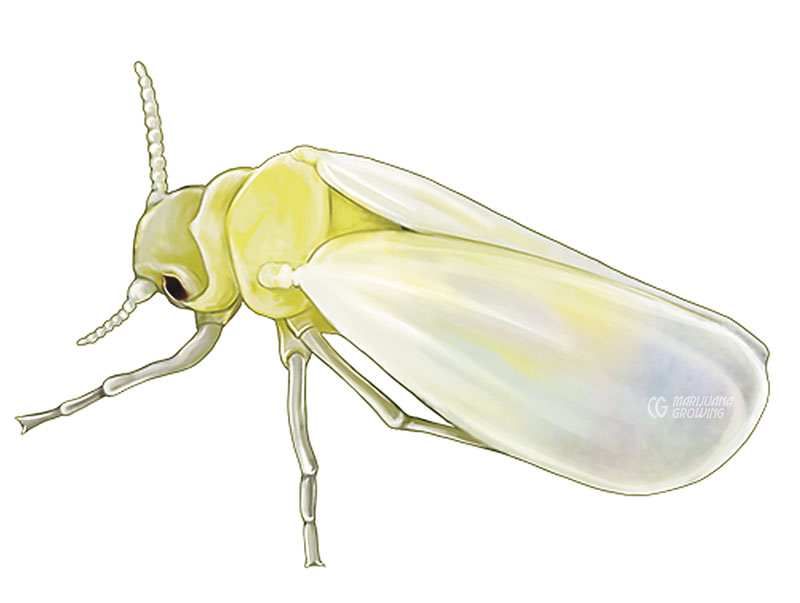
Whitefly
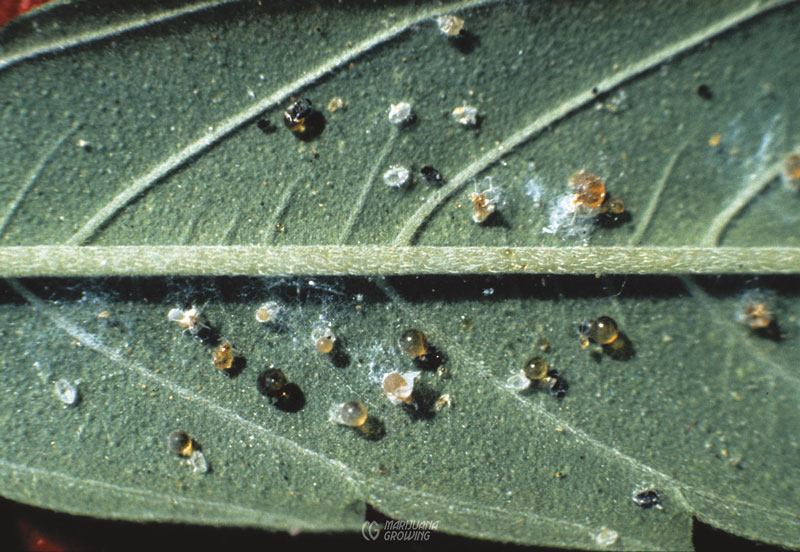
Whiteflies in all stages of growth can be seen on this leaf. (MF)
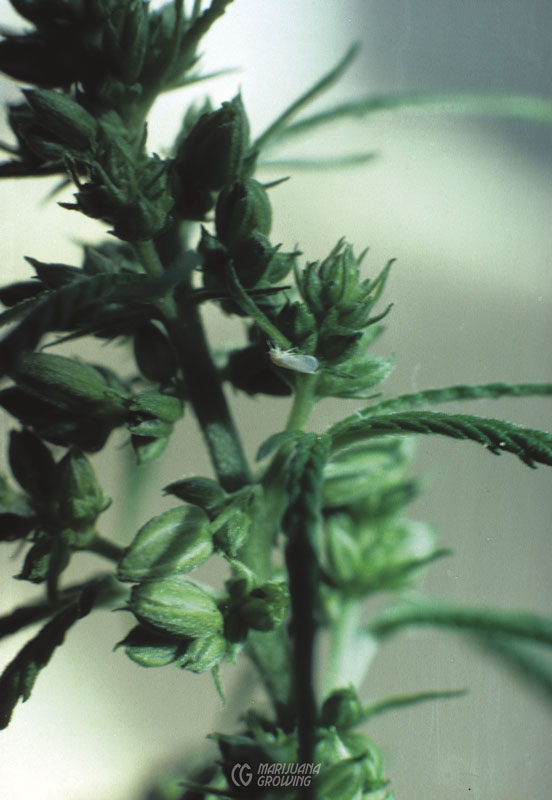
You can see the winged whitefly trying to hide under the male flower cluster! (MF)
Pest Mammals
Once your plants are in the ground, well fed and watered, check them weekly (if possible) for pest and fungal damage. Inspect the top and bottom of leaves for stippling (small spots) from mites or damage from chewing insects and slugs and snails. First identify the pest, and then determine a course of action. Properly grown outdoor cannabis has few problems with pests.
Low-tech, natural approaches to pest control work well. A few large pests like caterpillars and snails can be handpicked from the foliage. Caterpillar populations can be reduced at the source by installing bat houses. Resident bats will eat moths and decrease the number of chewing caterpillars. Birds will eat caterpillars too, as well as aphids and other insects. Attract birds with suet, birdhouses, birdbaths, and feeders, but cover tender seedlings and clones with wire or nylon mesh to protect from birds, too! Ladybugs and praying mantis are good options for insect control and can be purchased from nursery supply stores.
Barn owls eat mice, gophers, and voles but are hard to come by in the city. If you are lucky enough to have barn owls nearby, take advantage of their ability to eat plant pests. On the other hand, rodents such as moles and shrews help your garden by dining on slugs, insects, and larvae.
Marigold cultivars of the Tagetes erecta and T. patula species will repel nematodes (aka eelworms) from the soil for two to three years if planted in an infested area and then tilled under. Just planting these marigolds in an area doesn’t accomplish anything. Numerous tests indicate that they do not have an effect on insects above the ground.
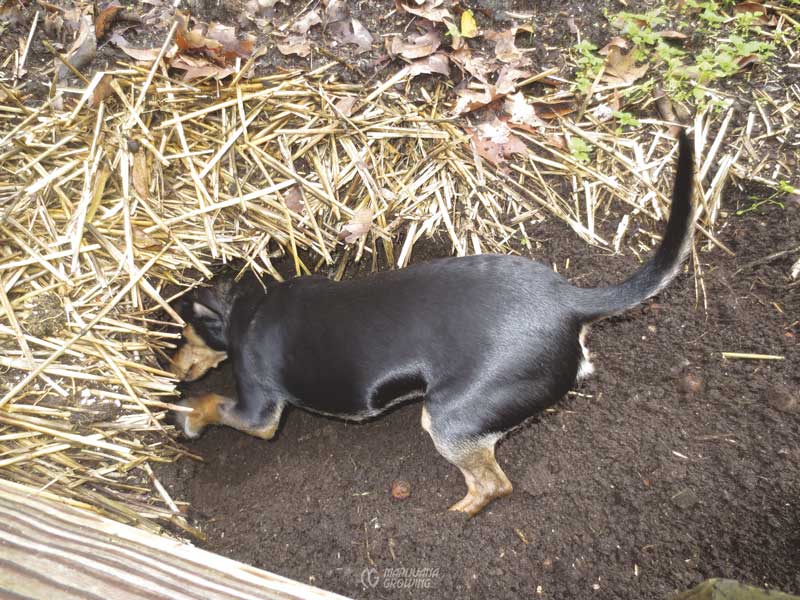
I love dogs—especially cute, little ones. But my little dog loves to dig and chase moles! The moles do enough damage. So far moles one, little dog zero.
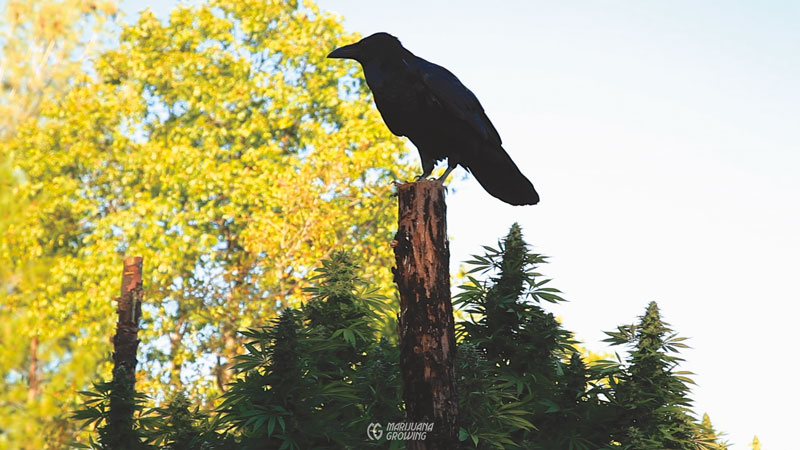
Edgar, a raven friend from Northern California, provided endless amusement as he bullied the dogs, cats, and other animals around the cannabis farm.
Bears
Bears present the biggest problems in gardens where there is a food source. If bears are common in your area, do not plant other garden fruits and vegetables nearby. Remove or secure all containerized garden fertilizers, especially ones containing molasses or sugars. Bears may appear out of nowhere if they are in the area, but normally they avoid contact with humans.
Birds
Insect- and pest-eating birds are welcome guests in most gardens, but the bad birds eat cannabis seeds and young tender plants.
Common names: birds, flying pigs, doves, hemp linnet, magpies, nuthatch, pheasants, pigeons, quail, sparrows, starling, crows, blue jays, cardinals
Garden threat: Low to medium. Seeds, tender seedlings, and clones are most vulnerable.
Damage: Birds eat seeds and young plants.
Cause: Birds are in the area and hungry, with little else to eat.
Prevention: Cover young plants with plastic or wire netting. Make sure the netting is securely attached around the perimeter of the garden to keep birds from sneaking underneath. Remove netting when plants are one to two feet (30.5–61 cm) tall. Inflatable plastic snakes and owls often scare birds, but not for long!
Control: scarecrow, sonic boom machine, shotgun or rifle (only in hunting season).
Boar (Wild Pigs)
Common names: wild pigs, wild boar, javali (Spain)
Garden threat: medium, but could be devastating
Identify: wild pigs, mostly nocturnal and travel in packs
Damage: uproot plants and eat lower foliage and roots
Cause: Wild pigs run loose in many rural areas and along the perimeters of urban areas.
Prevention: Install a battery-operated electric fence around outdoor plants. Keep a big, protective dog near the plants to scare off pigs. Do not leave out anything that will attract them; securely stow fertilizer and safely dispose of garbage.
Control: Shoot pigs with a gun (only in hunting season), and keep a big dog to protect garden from pigs. Big box traps are also available for pigs.
Sprays: none

Wild pigs from Northwest Spain have uprooted many gardens.
Deer
Common names: deer (buck, doe, fawn), elk (cow, bull, calf)
Garden threat: low to medium
Damage: Deer are browsers and eat the tender new growth first, but they can devour buds too! They take a bite (or maybe several bites) of a plant and move to another plant. Damage ranges from sporadic bites to large parts of plants being eaten.
Cause: Deer are in the area and have few food sources, of which cannabis is one. Prevention: A proper fence or a cage around plants will help keep deer away from plants. Deer are afraid to jump into a small, enclosed area. Set up the fence a few feet around plants so they cannot reach over or through it to get to foliage. The ideal deer fence for large rural gardens is eight feet (2.4 m) tall with the top foot (30.5 cm) sloping outward, away from the garden at a 45-degree angle. Electric fences and large dogs are also good deterrents.
If a fence is too conspicuous or difficult to construct, use repellents. Place handfuls of dried blood in cloth sacks and dip in water to activate the smell. Hang sacks from a tree to discourage dogs and other predators from eating them. Scented soaps have repelled deer from some gardens, but soap has also been known to attract rodents.
Predator urine, most often coyote urine, keeps deer away well when applied regularly. It is available at garden centers and many hunting stores. Some guerilla growers say that to deter deer damage, they urinate in several locations around the perimeter of the garden so animals take their human presence seriously. Some growers save urine all week and disperse it during regular visits to their patch.
Control: It is best to prevent damage. Shooting deer out of season or in populated areas is illegal and dangerous. Elk are somewhat of a problem, and deer are a problem!

Deer stop by and munch a few tender buds every night.
Gophers
Common names: pocket gopher
Identify: herbivorous rodents
Garden threat: low to medium Damage: Gophers eat roots and foliage and disrupt soil with tunnels. Annually, females bear four to five litters of up to eight offspring. That’s a lot of hungry mouths to feed!
Cause: Gophers may just stop by for a meal and like the way the plants taste.
Prevention: Line planting holes with hardware cloth or fine chicken wire 12 to 18 inches (30.5–45.7 cm) deep and 3 feet (91.4 cm) aboveground to exclude gophers. The gopher plant (Euphorbia lathyris) and castor beans/plants are said to repel gophers when stuffed in holes, but they have not worked for me.
Control: Traps are difficult to use and require experience and skill to actually catch gophers. Avoid getting any human scent on the trap. If human scent is apparent, gophers simply push dirt onto the trap, making it harmless.
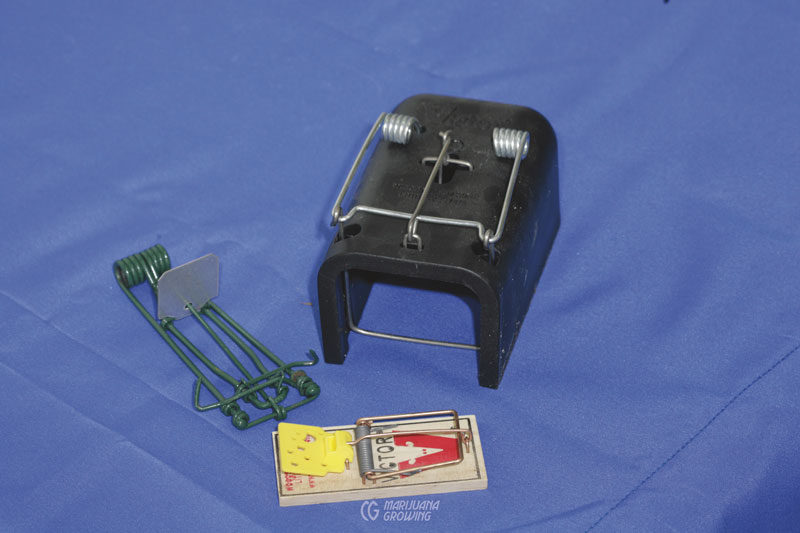
Gopher traps (pictured at top of image) and a mouse trap (pictured at bottom of image) are very important means of rodent control in outdoor medical cannabis gardens.
Mice, Rats, and Voles
Gopher Granola is available for areas such as the Northern California mountains, where wood rats and gophers will eat your crop if given any opportunity to do so. The best fence in the world will not keep rats away from your plants! (If rats are a problem in your area, do not use soap to keep deer away; the fat in soap is edible for rats.) Put the poison grain in a feeder only small rodents can enter, so that birds and deer can’t eat it. Set out poison early, before actual planting begins. Rats must eat the grain for several days before it will have any effect on them. Ultimately, you may find it’s easier to grow in a greenhouse shed in your own backyard rather than try to keep the rats from eating your outdoor plot.
Common names: mice, voles, rats, kangaroo rats, vermin
Garden threat: low indoors; medium to high outdoors and in greenhouses
Damage: Mice and voles can chew bark from around the base of cannabis plants (girdling).
Cause: Rodents have a nearby food source and are expanding their territory.
Prevention: Keep mulch a foot away from plants, and install wire mesh around the trunks. Mice and voles make nests in large piles of mulch, and they are attracted to stored water. Cover all water sources to exclude them, but keep in mind that they might chew through the container if water is super scarce. The best mouse deterrent is a cat that is serious about hunting.
Control Physical: Mousetraps work well on small populations. Removing a large number of mice with traps can be tedious and unpleasant.
Caution! DO NOT USE POISON! Scavenger animals will eat the dead rodents and may become poisoned themselves.
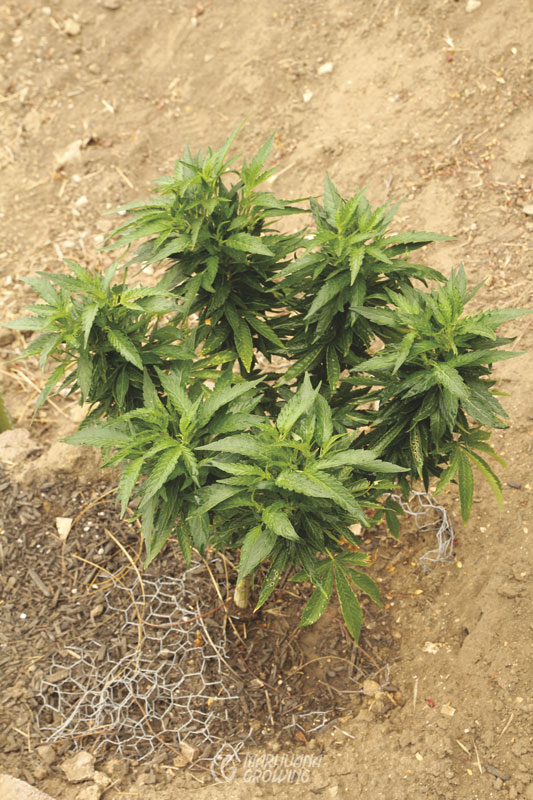
The root system of this ‘Jack Herer’ female is protected with chicken wire. (MF)
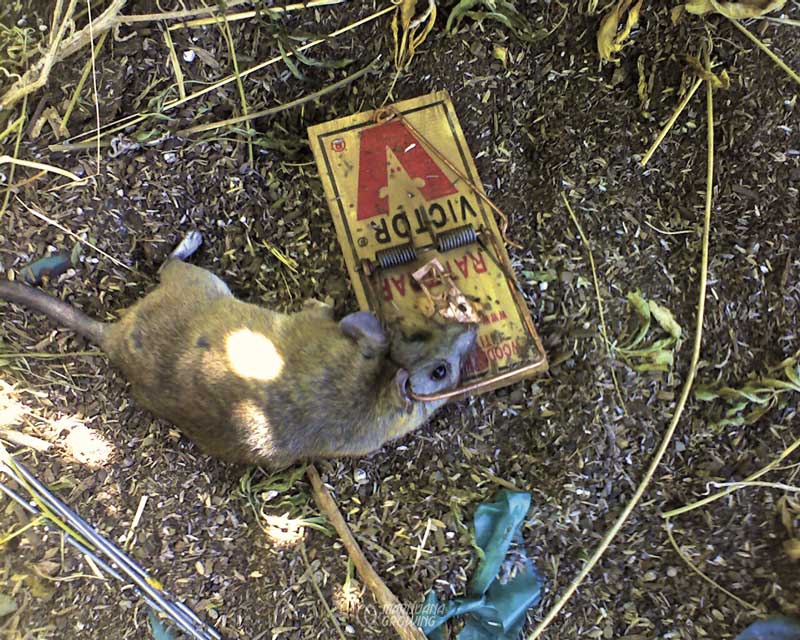
Mice populations can skyrocket outdoors in the late summer. Setting traps around plants helps monitor rodent populations and keep them in check.
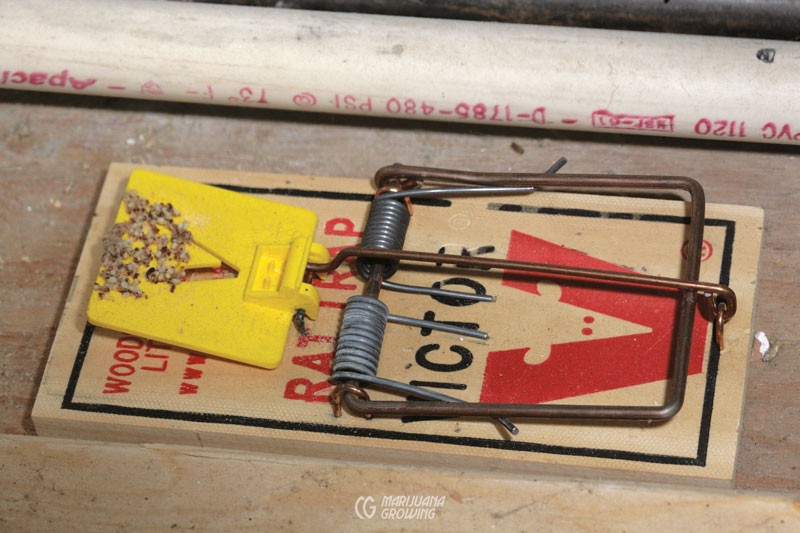
A mousetrap properly set and baited is one of the most effective means of mouse control.
Moles
Common names: mole
Garden threat: low
Damage: Moles are minor pests. They are primarily insectivores that eat cutworms and other soil grubs, but their tunnels may dislodge cannabis roots. Moles dig tunnels a few inches below the soil surface, creating a maze of tunnel mounds in the garden.
Cause: Moles are living nearby and looking for a new food source.
Prevention: Repel moles with castor plants or gopher (mole) plants (Euphorbia lathyris). Castor bean leaves and castor oil, as well as applications of tobacco and red pepper, will repel moles if put into their main runs.
Mixing: Blend two tablespoons (30 ml) of castor oil with three tablespoons of dish soap concentrate and ten tablespoons (148 ml) of water. Mix in a blender. Use this as a concentrate at the rate of two tablespoons per gallon (4 ml/L) of water.
Application: Apply as a soil drench directly over mole holes.
Control Physical: Barrel traps, scissor traps, and guillotine traps are effective and kill moles instantly.
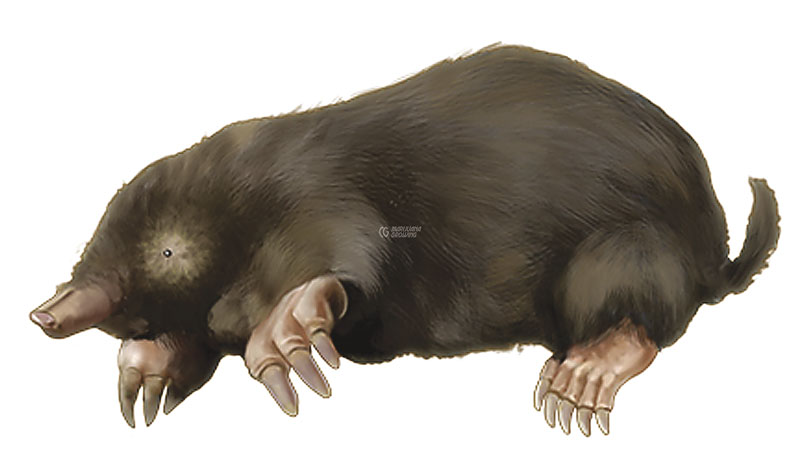
Moles are generally not a problem unless the soil is chock-full of worms and insects.
Rabbits
Common names: Cottontail, bunny rabbit, rabbit, hare
Garden threat: very low Rabbits are burrowing, plant-eating mammals of the Leporidae family. They can be recognized by their long ears and short, fluffy tails. Rabbits are voracious eaters and can reduce a crop to nothing in a couple of days. They will continue to feed from the same patch until they are done or the patch is destroyed. The best way to keep rabbits from your garden is to use predator urine. Rabbits also shy away from cats and dogs.
Identify: Long-eared rabbits (Bugs Bunny!) are plant-eating mammals. Most often cottontails, little “bunny rabbits” inhabit outdoor gardens. They multiply quickly and often eat from the same patch until it is destroyed.
Damage: Rabbits eat cannabis plants.
Cause: Rabbits have the opportunity to enter the cannabis garden and eat cannabis plants.
Prevention: Repel rabbits with a light dusting of rock phosphate on young leaves or dried blood sprinkled around the base of plants. Manure tea sprayed on leaves and soil may keep rabbits from dining on your plants. They also find plants dusted with hot pepper or a spray of dilute fish emulsion and bone meal repulsive. A dog will help keep rabbits in check, but the only surefire way to keep rabbits out of the garden is to fence them out with one-inch (2.5 cm) poultry wire. The poultry wire should be buried at least six inches (15.2 cm) in the ground to prevent burrowing and should rise two or three feet (61–91.4 cm) aboveground. Wrap trunks with wire mesh or aluminum foil to keep rabbits from chewing bark in winter or early spring.
Control: Rabbit baits and traps are difficult to use. Pull out the shotgun or rifle as a last resort. Observe local gun laws and hunting regulations.
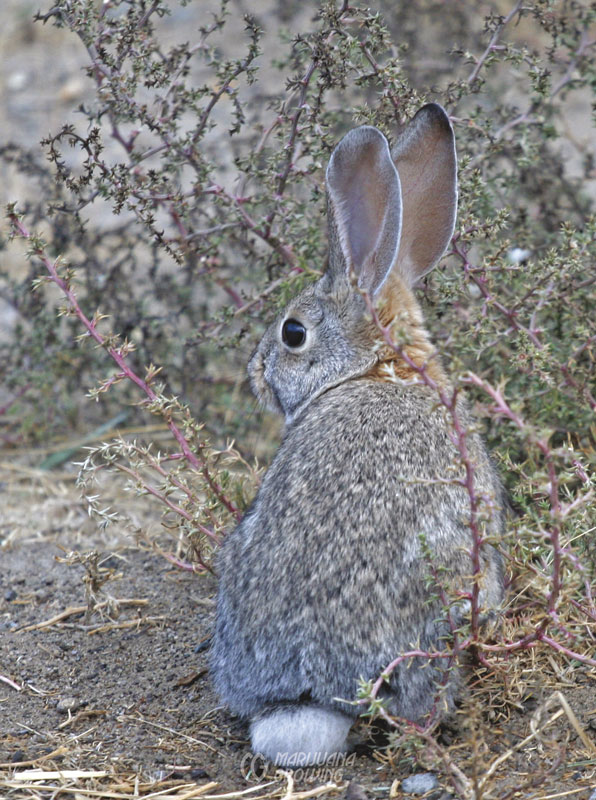
Rabbits may be cute in the country, but they can be extremely destructive in a garden.
Other Large Pests
Domestic and wild animals that can be a problem in cannabis gardens include: cats, cows, chipmunks, dogs, groundhogs (“woodchucks”), hamsters, horses, monkeys, raccoons, rats, squirrels, and voles.
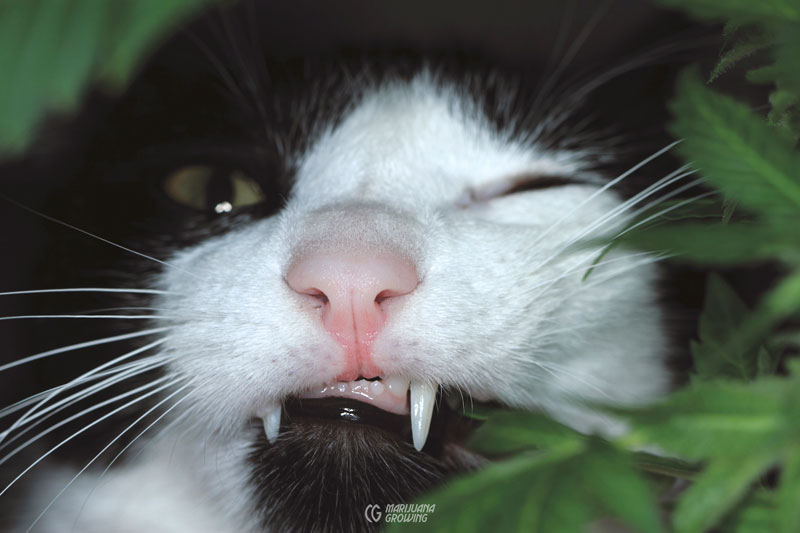
Cats are particularly fond of cannabis.
Rogue Pollen
Common names: rogue pollen, pollen from the neighbor
Garden threat: low to medium
Identify: Female plants develop seeds, yet there are no male flowers in the garden.
Damage: Once pollinated, female plants spend all their energy developing seeds and bud growth stops. Such plants produce less consumable harvest.
Cause: Male plants are within a few inches to several hundred miles, depending on wind patterns, from receptive female plants.
Prevention: Indoors, if neighbors are growing cannabis from seed and do not cull out male plants, or if your garden is near an industrial hemp farm, you will have to cover intake air ducts with fine mesh screen and wet it occasionally to keep rogue pollen outside. Outdoors, inspect plants continually and pick off all developing seeds. Once plants are seeded, they stop putting on flower weight.
Control: Keep female plants out of the path of male pollen. Remove all male plants from the garden.
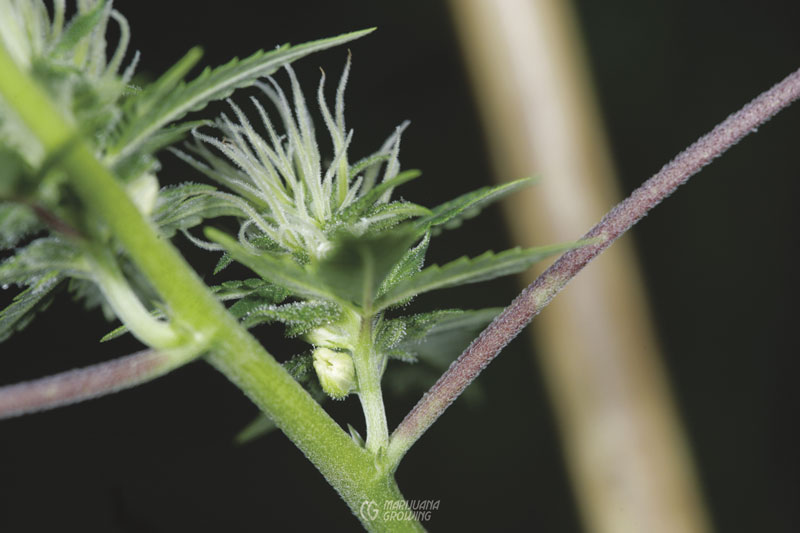
Rogue pollen is a big problem in some parts of the world when growing outdoors. Indoors, an occasional male flower can pollinate an entire roomful of plants. Always be on the lookout for spontaneous male flowers on female plants.
Disease and Pest Controls
Prevention and cleanliness are at the top of the control list. Problems first establish on weak plants, but even when all prevention measures are taken, disease and pest problems can arise. The first measures of control include identifying the problem. The next step is to use the least-toxic means of solving the problem. Remove pests manually, if possible, or spray them off with water. Next use organic sprays. Fungus can be stopped with many surface sprays that are not harmful to plants or the environment.
I do not recommend using chemical fungicides, fungistats, insecticides, or miticides on plants that are destined for human consumption. Most contact sprays that do not enter the plant system are approved for edible fruits and vegetables.
Read all labels thoroughly before using control measures. Use only contact sprays that are approved for edible plants. Avoid spraying seedlings and tender unrooted cuttings. Wait until cuttings are rooted and seedlings are at least a month old before spraying.
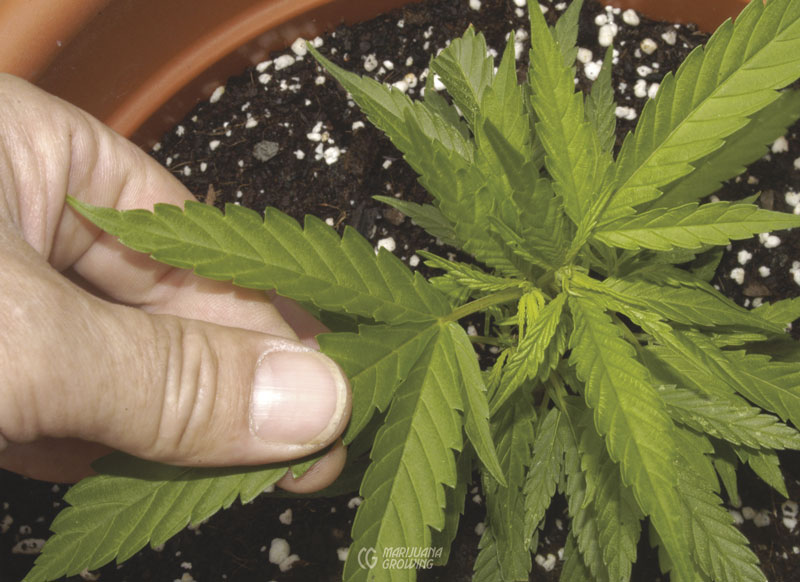
Manually remove small populations of insects and pests by smashing them between your thumb and index finger or between two sponges. Smash all pests (and their eggs).

Minute grains of pollen can escape from male flowers and pollinate females. Be careful when working with male plants!
| GENERIC NAME | PURPOSE | ENTER SYSTEM | DO NOT USE |
| griseofulvin | fungicide | systemic | Do NOT Use |
| streptomycin | bactericide | systemic—registered for various food crops | Do NOT Use |
| carbaryl | fungicide | systemic | Do NOT Use |
| tetracycline | bactericide | semisynthetic | Do NOT Use |
| nitrates | foliar fertilizers | systemic | Do NOT Use |
| abamectin | insecticide not a true insecticide | translaminar | Do NOT Use |
| dienchlor | miticide | systemic | Do NOT Use |
| aldicarb | insecticide | systemic | Do NOT Use |
| neem | insecticide | systemic | Do NOT Use |
| triforine | fungicide | systemic | Do NOT Use |
| carboxin | fungicide | systemic | Do NOT Use |
| acephate | insecticide | systemic | Do NOT Use |
Caution! We do not recommend using any products in any form in a manner inconsistent with their label. Note that no pesticide, fungicide, or any other product is approved by any government for use on cannabis.
If you should decide to use any of the products mentioned in this book, please FOLLOW THE LABEL DIRECTIONS!
Medicinal cannabis is to be consumed by sick patients, and a pesticide-and- fungicide-free crop must be ensured.
Many fungicides and pesticides are SYSTEMIC and FOR USE ON ORNAMENTAL PLANTS ONLY! Do not use such dangerous products on consumable cannabis. PLANT GROWTH REGULATORS, SYSTEMIC PESTICIDES, AND FUNGICIDES CAN BE FATAL TO HUMANS!
| NATURAL REMEDY TABLE | |
| Active Ingredient | EPA Class |
| Bacillus species | G, D, WP Bt, DiPel, M-Trak, IV Match, Javelin, etc. |
| copper sulfate | D, WP, Brscop III |
| copper sulfate/lime | D, WP, Bordeaux mixture III |
| diatomaceous earth | D, Celite IV |
| neem | O, EL Neem, BioNEEM IV |
| nicotine sulfate | L, D, Black Leaf 40 II |
| oil, dormant horticultural | O, Sunspray IV |
| pyrethrin | A, L, WP Many trade names III, IV |
| quassia | WP, bitterwood IV |
| rotenone | D, WP, EC Derris, Cubé II, III |
| ryania | D, WP Dyna 50 IV |
| sabadilla | D, Red Devil IV |
| soap, insecticidal | L, M-Pede, Safer’s IV |
| sodium bicarbonate | P, baking soda IV |
| sodium hypochlorite | L, bleach II, III |
| sulfur | D, WP, Cosan V |
*Legend
L liquid
A aerosol
WP wettable powder
D dust
O oil
EL emulsifiable liquid
G glandular
Common chemicals with their trade names and the insects they control: Note: Do not apply these substances to edible plants.
Note: This list is not all-inclusive. The basic rule is to not use systemic products. Organic contact pesticide, miticide
Controls: russet and spider mites, fire ants, leaf miners, and nematodes.
Brand names: Abba, Affirm, Agri-Mek, Avid, Dynamec, Epi-Mek, Genesis Horse Wormer, Reaper, Vertimec, Zephyr, and Cure 1.8 EC.
About: Abamectin derivatives include emamectin and milbemectin. It does not bioaccumulate. Not truly systemic, abamectin is absorbed from the exterior of foliage to other leaf parts, especially young leaves, in the process of translaminar activity.
Forms: liquid
Mixing: DO NOT USE!
Application: DO NOT USE! DO NOT APPLY!
Persistence: DO NOT USE!
Safety: DO NOT USE! Toxic to mammals, fish, and honeybees in high concentrations. Sucking insects are subject to control, while beneficials are not hurt. Wear gloves, mask, and safety glasses.
In one example from Hayward, California, a well-known cannabis patient with an unusual immune disease died from repeated exposure to the miticide Avid. Avid is now illegal to sell in the US, though it remains available from Canadian sources. Directed for used on ornamentals only.

DO NOT USE Avid on cannabis!
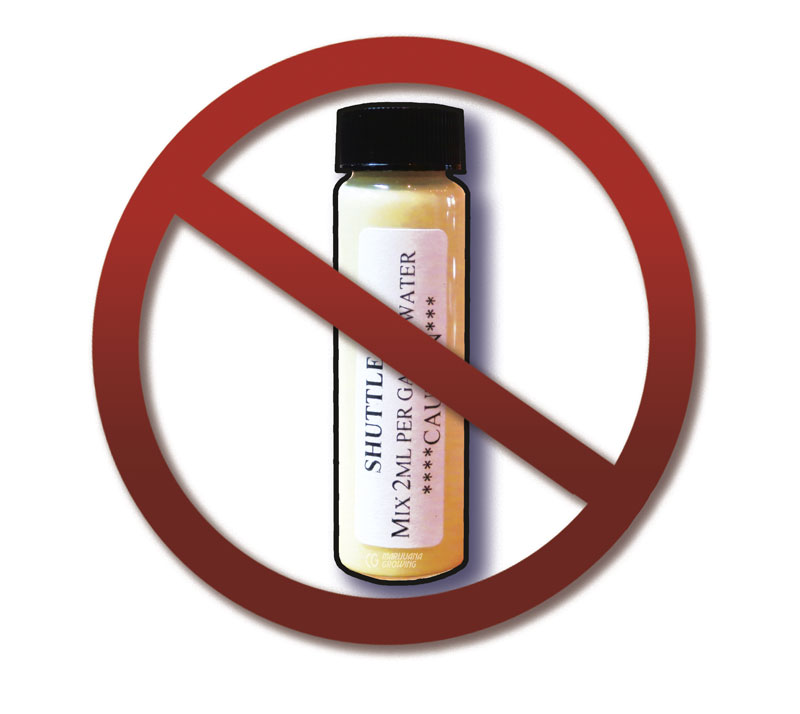
DO NOT USE Shuttle on cannabis!
SHUTTLE 15 SC: Do Not Use! Systemic pesticide, miticide
Controls: Two-spotted spider mite (Tetranychus urticae) and spruce spider mite (Oligonychus ununguis). SHUTTLE destroys damaging mites at every life stage, from eggs to adults. Brand names: SHUTTLE (For ornamentals only)
About: SHUTTLE Miticide developed by Arvesta Corporation is for use on ornamentals only. SHUTTLE provides excellent control of two-spotted mite, red mite, and related species. It does not demonstrate cross-resistance to miticide resistant mite species. A reduced risk compound, it has no impact on most predacious species. Some growers use this chemical on mother plants and wait one month before taking clones.
Safety: Do Not Use! Kills fish and water life, although it is not carcinogenic. Wear protective clothing, goggles, and gloves. Read label carefully. Do not use on cannabis that will be consumed!
Ampelomyces quisqualis
Fungicide
Controls: powdery mildew
Trade name: AQ-10
Caution! This product registration that was started in 1994 was canceled in 2004. This product is no longer available in the USA.
Ant Baits
Organic contact pesticide
Controls: ants
Brand names: Terro, Pic, Drax Ant Kill Gel (sugar-feeding ants) Drax-FP (grease and sugar-feeding ants) MAXFORCE, (cockroach and Pharaoh ant killer—hydramethylnon)
About: Sweet-loving ants are easy to attract and control with sweet baits mixed with ant-specific poison. They return to the nest and distribute the poison, killing the nest in a matter of days. Ants start feeding on bait within two hours.
Forms: store-bought containers or homemade
Mixing: homemade
Application: Set out or lay a barrier where ants are prevalent.
Persistence: Poison stays in container and is good for several months. We recom-mend baits with boric acid or hydramethyl-non as their active ingredient. Big-headed ants, little black ants, and pavement ants are attracted to animal grease, protein, and fruits. A plastic squeeze bottle with a pointed tip is a great applicator. Make a protein/grease bait with:
• 4 tablespoons peanut butter
• 6 tablespoons honey
• 3/4 teaspoon boric acid
Sweet Baits
• Argentine ants
• carpenter Ants
• odorous house ants
• small honey ants
Grease and Sweet Baits
• big-headed ants
• little black ants
• pavement ants
Safety: Read label carefully and follow directions.

Ant baits work great. The ants enter the container and do not leave.
Bacillus thuringiensis (Bt) and Bacillus Species
Bacillus pumilus: QST 2808
Organic beneficial fungus Controls: Fusarium
Name: Bacillus pumilus strain QST 2808
About: Bacillus pumilus strain QST 2808, commonly found in soil, is sprayed on crops to control many fungal, mildews, blights and rusts pests. It forms a barrier between leaves and bad fungal spores, and B. pumilus strain QST 2808 actually colonizes the spores. Like several other varieties of B. pumilus, this strain may also stimulate the plant’s own resistance system by inducing systemic acquired resistance (SAR).
Forms: Wettable powder
Mixing: Follow instructions on label for tomatoes and vegetables.
Application: Ground, aerial, or chemical spray; follow instructions on label for tomatoes and vegetables.
Persistence: Stays around until weathered or washed away.
Safety: No adverse environmental effects and Bacillus pumilus strain QST 2808 is NOT harmful to insects, birds, mammals, plants, or marine species when used as directed.
Bacillus thuringiensis (Bt) Species
Organic contact pesticide, miticide
Controls: caterpillars, larvae, and maggots
Pesticide: insecticide
About: Bacillus thuringiensis (Bt) is a well-known bacterium. There are several varieties, each with special qualities that are listed below. Bt kills pests a few days after it is eaten by pests. But they stop eating soon after ingesting Bt. Commercial Bt products do not reproduce within insect bodies, so several applications may be necessary to control an infestation. Commercial Bt products do not contain living Bt bacteria, but the Bt toxin is extremely perishable. Bt is most effective on young caterpillars, larvae, and maggots, so apply as soon as they are spotted.
Forms: powder, granules
Mixing: as per instructions on label
Application: Spray, dust, or granules. Inject liquid Bt into stalks to kill borers. Keep within prescribed temperature range, and apply according to the directions. Get the most out of Bt applications by adding a UV inhibitor, spreader-sticker, and a feeding stimulant such as Entice, Konsume or Pheast. Bt is completely broken down by UV light in one to three days.
Controls: fatal to caterpillars’ larvae and maggots, cabbage loopers, cabbageworms, corn earworms, cutworms, gypsy moth larvae, and hornworms
Safety: Microbial Bt bacteria are nontoxic to animals, humans, beneficial insects, and plants; however, some people do develop an allergic reaction to it.
Bacillus thuringiensis var. kurstaki (Btk) is the most popular Bt. Bacillus thuring-iensis var. aizawai (Bta) is effective against hard-to-kill budworms, borers, armyworms, and pests that have built up a resistance to Btk.
Controls: moth and caterpillar larvae, including most of the species that feed on cannabis
Brand names: DiPel, BioBit, Javelin, etc., Btk is also available in a microencapsulated form, M-Trak, Mattch, etc. The encapsulation extends the effective life on foliage to more than a week. B. thuringiensis var. israelensis (Bt-i) kills mosquito and fungus gnat larvae. Use Bt-i to get rid of them as soon as they are identified. B. thuringiensis var. morrisoni is a new strain of Bt under development for insect larvae with a high pH in their guts.
Controls: larvae of mosquitoes, blackflies, and fungus gnats
Brand names: Gnatrol, Vectobac, and Bactimos. All are lethal to larvae. Adults do not feed on plants and are not affected.
B. thuringiensis var. san diego (Btsd)
Controls: larvae of Colorado potato beetles, elm beetle adults, and other leaf beetles
Bacillus thuringiensis var. tenebrionis (Btt) is lethal to the Colorado potato beetle
Bacillus cereus helps control damping-off and root-knot fungus. It flourishes in water-saturated mediums and promotes beneficial fungus that attacks the diseases.
Controls: Colorado potato beetle larvae
Bacillus subtilis is a soil-dwelling bacterium that curbs damping-off. Soak seeds and apply as a soil drench.
Controls: Fusarium, Pythium, and Rhizoctonia that cause damping-off
Brand names: Epic, Kodiac, Rhizo-Plus, Serenade, etc.
Bacillus popilliae colonize larvae and grub bodies that consume it, causing them to turn milky-white before dying. It is often called milky spore disease.
Controls: It is most effective against Japanese beetle grubs.
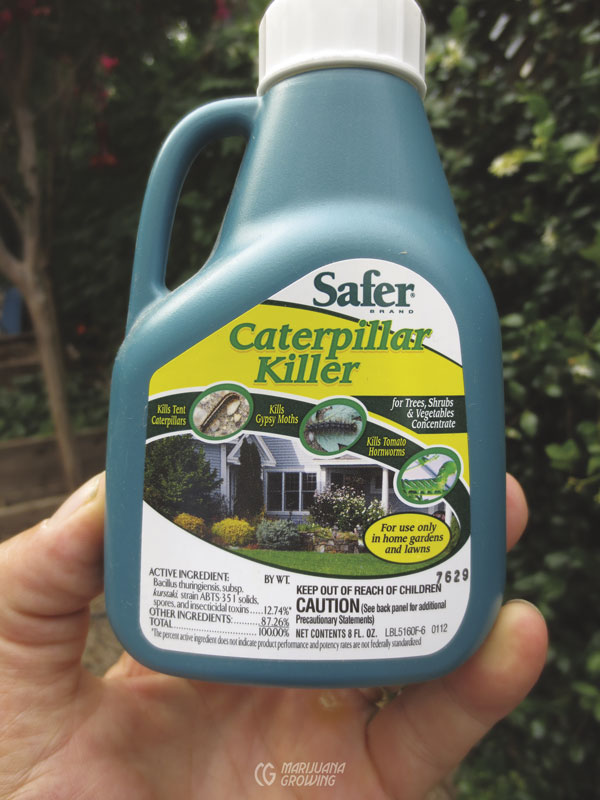
Bacillus thuringiensis is one of the most versatile and safe pesticides in the garden.
Beauveria bassiana (Beneficial Fungi)
Pesticide: pesticide/miticide
Controls: mites and insects— broad-spectrum kills ALL
Controls: whiteflies, thrips, aphids, and other soft-bodied sucking insects
Brand names: Naturalis H&G, BotaniGard, Mycotrol
About: Spores of Beauveria bassiana germinate upon contact with insects. The fungus grows directly into the pest/ host. The fungus kills the insect in a week or two, and in doing so multiplies to infest new pest/host insects!
Forms: beneficial fungi wettable powder, liquid
Mixing: Follow instructions on label.
Application: Follow instructions on label.
Safety: kills beneficial insects
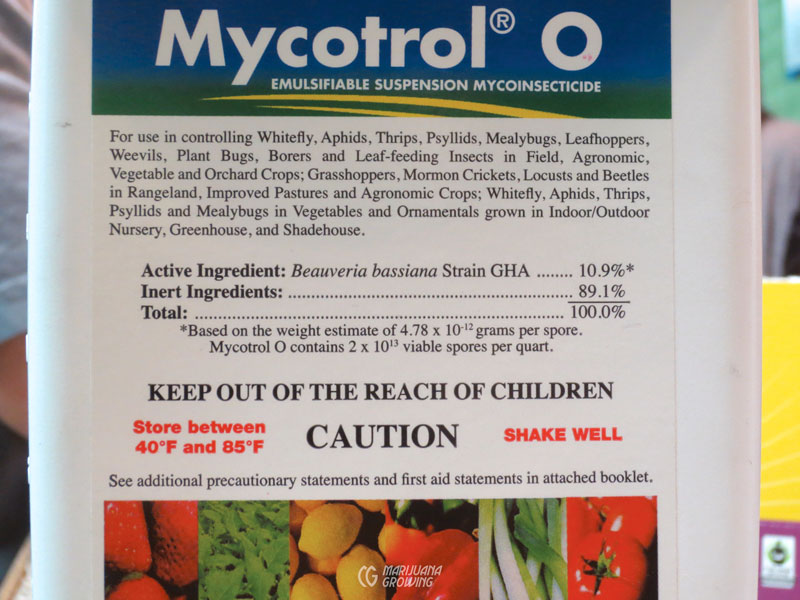
Beauveria bassiana is a broad-spectrum pesticide/miticide. It kills all insects and mites, good and bad!
Baking Soda
Fungistat controls: powdery mildew and other surface fungus
Brand names: Arm & Hammer
About: Baking soda (sodium bicarbonate, NaHCO3) acts as a fungistat to change the pH of foliage surface so that fungal diseases cannot grow there.
Forms: powder, wettable powder
Mixing: dilute 2 tablespoons (30 ml) per quart (liter)
Application: Use as a duster or spray. Baking soda will persist on foliage one to three days and is easily washed off. Wash off with plain water after three days.
Safety: Baking soda is not toxic to mammals, fish, or beneficial insects. Wear a mask to avoid inhaling dust.

Baking soda
Bleach, Laundry
Germicide and disinfectant
Controls: numerous bacteria, fungi, and pests
Brand names: Clorox and many generic brands
About: Liquid bleach (sodium hypochlorite, NaClO) is a strong disinfectant for pots, walls, tools, and more when mixed in 10 percent solution with water. Apply with a brush, mop, or rag, or use as a dip.
Forms: liquid
Mixing: dilute in water at rate of 1 part bleach to 10 parts water.
Application: Spray, wipe on with rag or mop, or submerge seeds. To control stripping (seed virus), dilute a 25 percent solution of bleach and water, adjust to 9.0 pH. Soak seeds for ten minutes, and then rinse with fresh water. Residues linger a day or two.
Safety: Diluted bleach solution evaporates, leaving a slight residual in a couple of days. It is toxic to fish, beneficials, animals, and humans if swallowed or comes in contact with the eyes. Wear a mask and gloves when handling concen-trate. Avoid respiration and skin contact. The concentrate burns skin and stains clothes. The Bordeaux and Burgundy mixtures are too strong for indoor and outdoor cannabis plants in most conditions. You can find many recipes for them on the Internet. I have decided not to include them in this book.
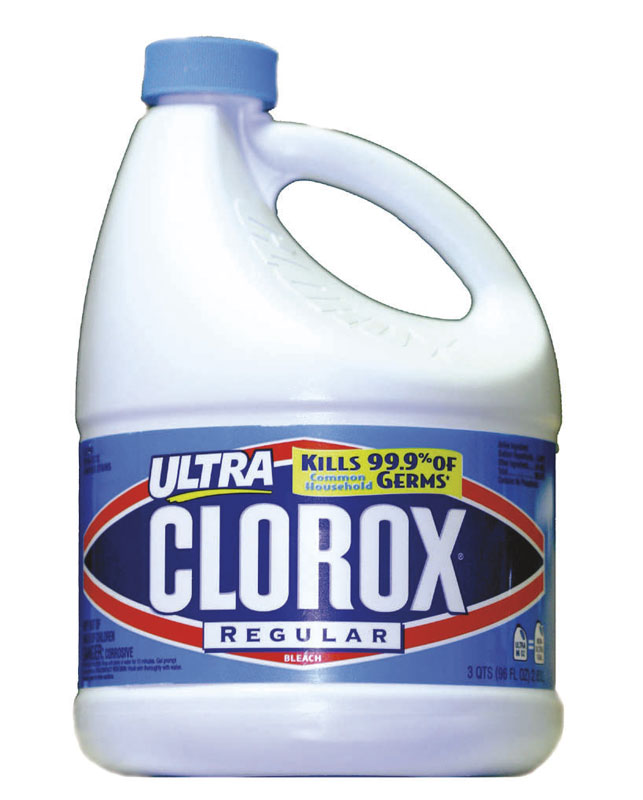
Laundry bleach
Boric Acid
Pesticide: insecticide
Controls: earwigs, cockroaches, crickets, termites, fleas, silverfish, and ants.
About: Boric acid (also called boracic acid, orthoboric acid, or Acidum boricum (H3BO3)) is a lethal stomach poison for earwigs, cockroaches, crickets, termites, fleas, silverfish, and ants. Purchase ready-to-use products or mix borax soap powder or crystals in equal parts with powdered sugar to make toxic bait. Do not wet the bait or it will disperse quick-ly. Set bait on soil near plant base.
Forms: liquid, powder, crystals
Mixing: Follow instructions on label. Boric acid dissolves in water.
Application: Follow instructions on label.
Safety: Phytotoxic when applied to foliage. Not toxic to honeybees and birds. Avoid breathing boric acid dust.

Boric acid
Bug Bombs
Pesticide controls: everything in the room
Brand names: Look for brands with the highest concentration of pyrethrins—0.5 percent.
About: Single-application aerosol bombs are usually packed with strong insecticides and miticides, including synthetic pyrethrins that exterminate every pest in the room. Piperonyl butoxide and N-Octyl bicycloheptene dicarboximide are often added to pyrethrums to inhibit pest life processes. Propellants are also added to distribute the insecticide/miticide. Bug bombs were developed to kill fleas, roaches, and their eggs that hide in furniture and in carpets. Place the bug bomb in the empty garden room, turn it on, and leave the room.
Forms: single-use aerosol can
Mixing: none required
Application: Set the bug bomb in the middle of the clean garden room with all equipment removed, turn it on, and leave the room.
Safety: Be careful; read the entire label before using a bug bomb. Even though they have a low residual and persist for only a day or two, use these products as a last resort. Wear a mask and gloves, and cover exposed skin and hair.
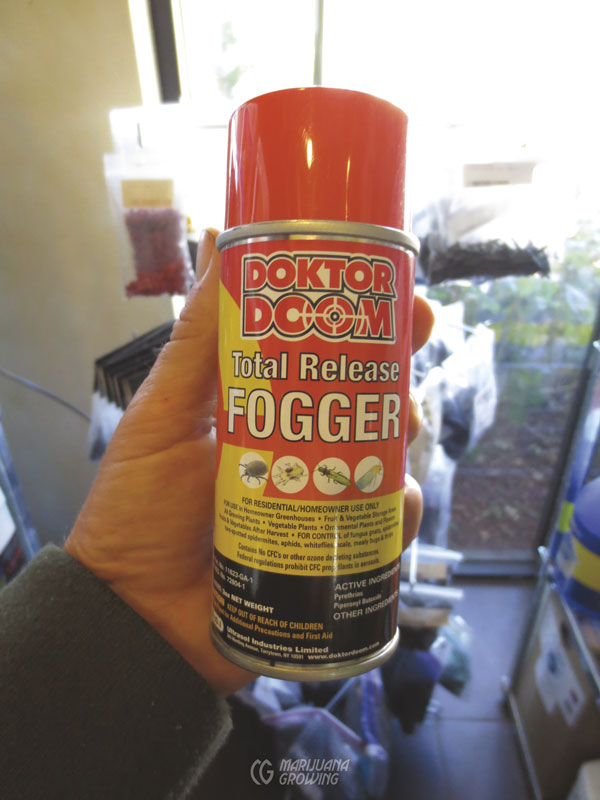
A bug bomb is designed to be set in the middle of the room and disperse the entire contents of the can at one time.
Castor Oil
Pesticide: said to control moles
Brand names: Mole-Med, Mole-Go, Mole Repel
About: Castor oil plant or castor bean plant, Ricinus communis, is the same one that yields castor oil. We used to stuff bean pods and leaves down gopher holes, but I have never seen it work.
Forms: oil
Mixing: Follow instructions on label.
Application: Follow instructions on label.
Safety: Raw castor beans are toxic to humans if ingested Avoid contact with skin. A lethal dose in adults is four to eight seeds, although reports of poisonings are unusual.
Compost Tea
Compost teas, especially the “fast teas,” are teaming with beneficial microbes that protect roots and foliage from disease and pest attacks.
See chapter 18, Soil, for more information.
Copper
Fungistat
Fungicide controls: gray mold, foliar fungus, anthracnose, blights, mildews, and a number of bacterial diseases.
Brand names: There are many manufacturers of copper fungicide.
About: Common ingredients—copper sulfate, copper oxychloride, cupric hydroxide, and cuprous oxide—are forms of fixed copper and are less phytotoxic than unfixed (pure) copper. Mix powder or liquid as per instructions and apply immediately after preparing. Agitate the mixture often while spraying, so ingredients do not settle out. Be careful when applying, and make sure the temperature is not too hot. The temperature range for application is 65ºF to 85ºF (18.3ºC– 29.4ºC). It is best to stay nearer the bottom end of the temperature range.
Forms: liquid, powder
Mixing: Follow instructions on label for tomatoes and vegetables.
Application: Follow instructions on label for tomatoes and vegetables.
Safety: Easy to overapply and burn foliage or create a copper excess in plants. Copper fungicide lasts two weeks or longer indoors if not washed off. It is toxic to fish. Not toxic to birds, bees, or mammals. Wear a mask and gloves, and cover exposed skin and hair.
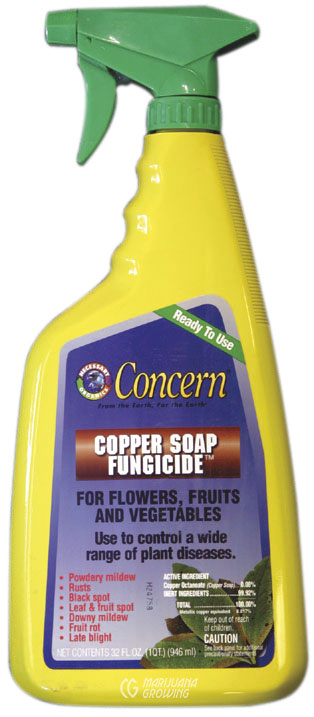
Copper fungicide
Coriander Oil
Pesticide: insecticide, miticide
Controls: spider mites and soft-bodied insects
Brand names: SM-90, Brigade 2EC About: Plant coriander seed and harvest cilantro plants. Although not a mainstream miticide and insecticide, coriander oil is at the base of a few popular products. This contact poison kills by drying out pest insects. SM-90 is made from coriander oil, sulfonated canola oil, and an acidic emulsifier.
Forms: emulsifiable liquid, liquid
Mixing: Follow instructions on label.
Application: Follow instructions on label.
Safety: Use protective clothing when handling and spraying.
Diatomaceous Earth (DE)
Pesticide: insecticide, miticide
Controls: Diatomaceous earth (DE) abrades the waxy coating on the shells and skin of pests, including aphids and slugs, causing body fluids to leak out.
Once ingested, the razor-sharp particles in DE rip tiny holes in the pest’s guts, causing death.
Brand names: There are many.
About: Naturally occurring DE includes fossilized silica-shell—remains of the tiny one-celled or colonial creatures called diatoms. It also contains 14 trace minerals in a chelated (available) form. Apply powder on soil, dust it onto foliage, or create a barrier around plants. Dilute DE in water as per instructions for spray. Apply weekly as soon as pests are apparent.
Forms: powder, wettable powder, liquid
Mixing: Follow instructions on label.
Application: Follow instructions on label. DE is swept away by wind and rain.
Safety: Use only horticultural-grade DE. Do not use chemically treated DE meant for swimming pools. DE stays on foliage for a few days or until washed off. Earthworms, animals, birds, and humans can digest diatomaceous earth with no ill effects. Avoid contact with skin and eyes. To guard against respiratory and eye irritations, wear a protective mask and goggles when handling this fine powder.
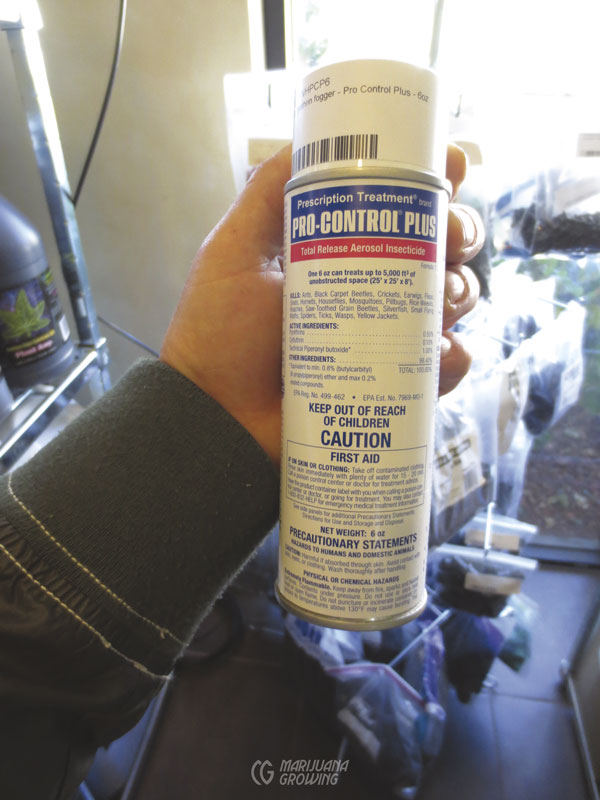
This aerosol pyrethrum (0.5 percent) is one of the best sprays for spider mites and insects.
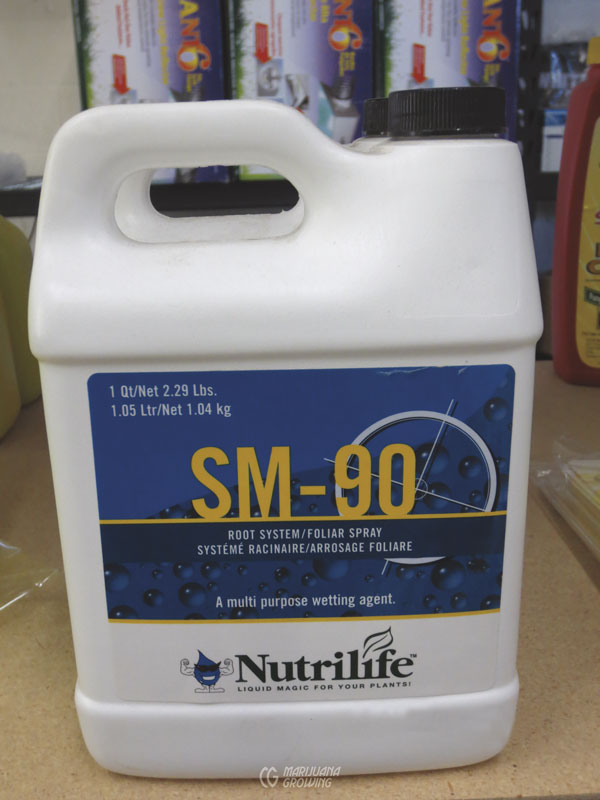
SM-90 was developed in Canada more than 20 years ago as a natural miticide.
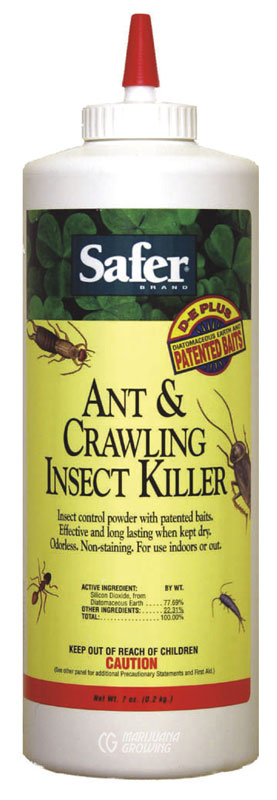
Diatomaceous earth is safe and works very well as a pesticide in many cases.
Homemade Sprays for Diseases and Pests
Organic pesticide/miticide controls: diseases and pests
Brand names: Homemade, however, many store-bought controls include the same elements as active ingredients, most often in a concentrated form.
About: A strong hot taste, smelly odor, and a desiccating powder or liquid are the main components in home-brewed pesticide and fungicide potions. Homemade sprays discourage and control pests such as aphids, thrips, spider mites, scale, and many others. Be careful when testing a new spray; apply it to a single plant and wait for a few days to learn the outcome before applying it to all plants.
Forms: liquid, powder, emulsifiable liquid, plant matter
Mixing: To make organic pesticide/ miticide spray concentrates, mix repellent substances with a little water in a blender. Strain the resulting slurry concentrate through a nylon stocking or fi ne cheesecloth before diluting it with water for application.
Application: Spray foliage until it drips from both sides of leaves.
Safety: Safe. In fact, ingredients can be found in most kitchens.
Toxicity: Homemade organic pesticide/ miticide usually is not toxic to humans in dosages lethal to pests.
Safety: Wear a mask and gloves, and cover skin and hair. Avoid contact with eyes, nose, lips, and ears.
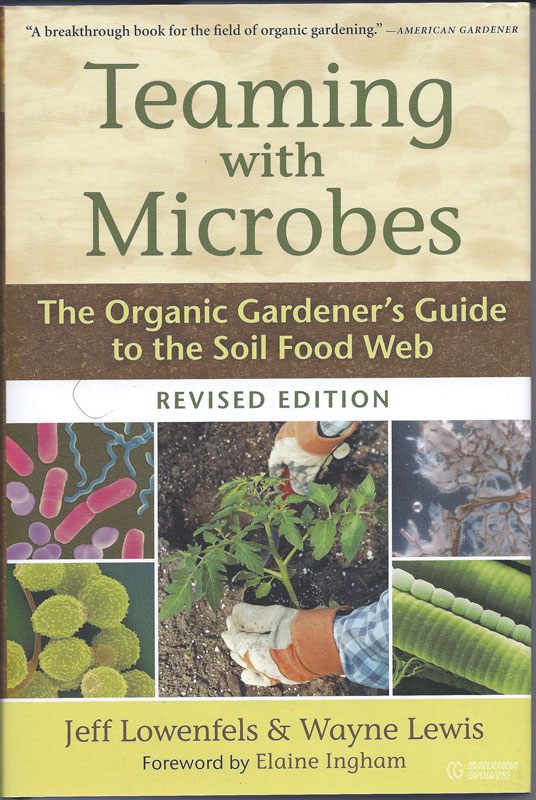
Teaming with Microbes is an excellent book to learn about life in soil, compost, and compost teas.
Homemade Recipes and Controls
Alcohol: Add isopropyl (rubbing) alcohol to sprays to dry out pests.
Bleach: Use a 5 percent solution as a general disinfectant. Use 10 percent for a sure kill. Use a 25 percent solution when treating seeds. Wash off residual bleach with plenty of fresh water.
Cinnamon: Dilute cinnamon oil with water. Use two teaspoons per quart of water, or a few drops per pint as a fungicide or pesticide. It is relatively effective to slow powdery mildew and control a host of insects.
Citrus: Citrus oils are great ingredients that kill insects.
Clove: Clove oil is aromatic and repels pests.
Garlic: Use a garlic press to squeeze garlic juice into a homemade mix. Use liberal amounts.
Horseradish: Add as you would garlic. Best to use fresh root.
Hot pepper: Dilute Tabasco or any store-bought hot pepper concentrate in water.
Capsaicin: hot pepper spray; Bonide Hot Pepper Wax; Repellex mole, vole and gopher repellent; BrowseBan, and Liquid Fence for deer
Hydrated lime: Saturate in water to form a fungicide.
Mint: Mint oil drives insects away. Dilute in water; measure several drops per pint.
Oregano: Grind up fresh herb and use as a repellent. Mix with water.
Rosemary: The predatory mite Phytoseiulus persimilis is less susceptible to rosemary oil and ECOTROL than spider mites, both in the laboratory and in the greenhouse. The parasitic wasp Encarsia formosa is more susceptible to rosemary oil than whiteflies.
Sesame: Use sesame oil or any other light oil sparingly to kill pests.
Soap: I like Ivory or Dr. Bronner’s Pure-Castile soap. Use as an insecticide and wetting agent. Mix a few drops with water.
Tobacco: Mix tobacco with hot water to extract the poisonous alkaloid. Do not boil. Dilute concentrate with water.
Vegetable oil: Mix vegetable oil (comprised mainly of fatty acids and glycerides) with rubbing alcohol to emulsify in water. See “Oils” in this chapter.
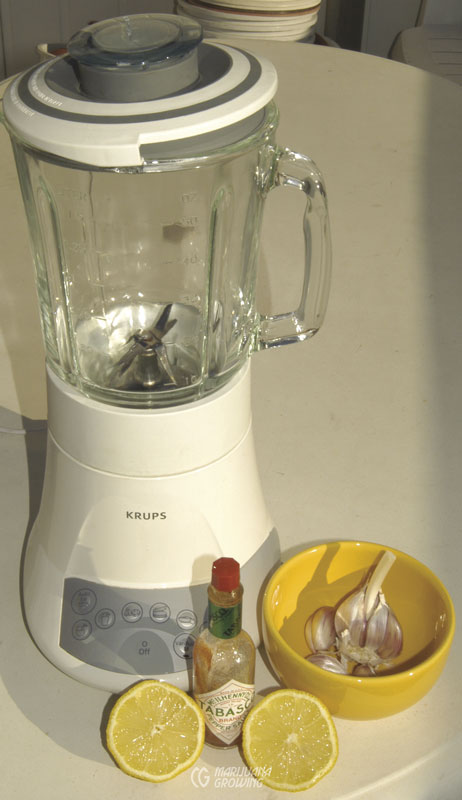
Making your own organic insecticide, miticide, or fungicide is as easy as blending the ingredients together with water.
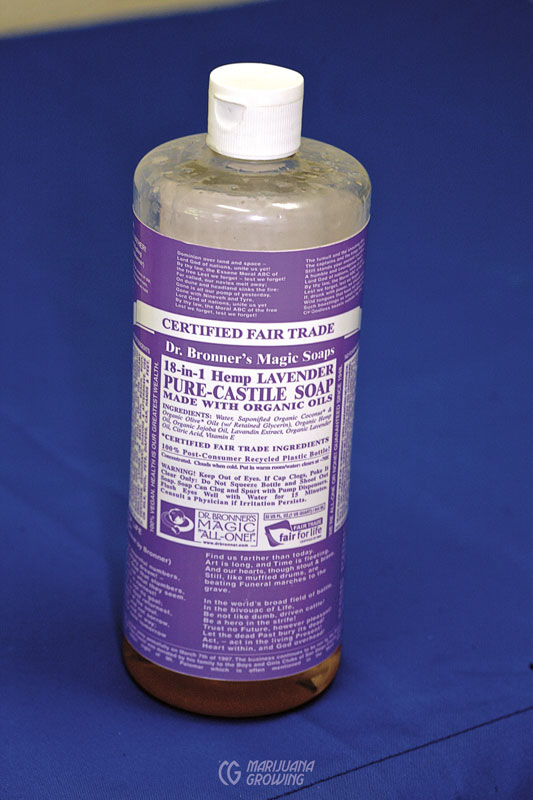
Dr. Bronner’s Pure-Castile Soap is natural soap that is a great insecticide, miticide, fungicide, and cleaning agent. Also, mix Dr. Bronner’s soap with garlic, hot pepper, citrus oil, and liquid seaweed combinations.
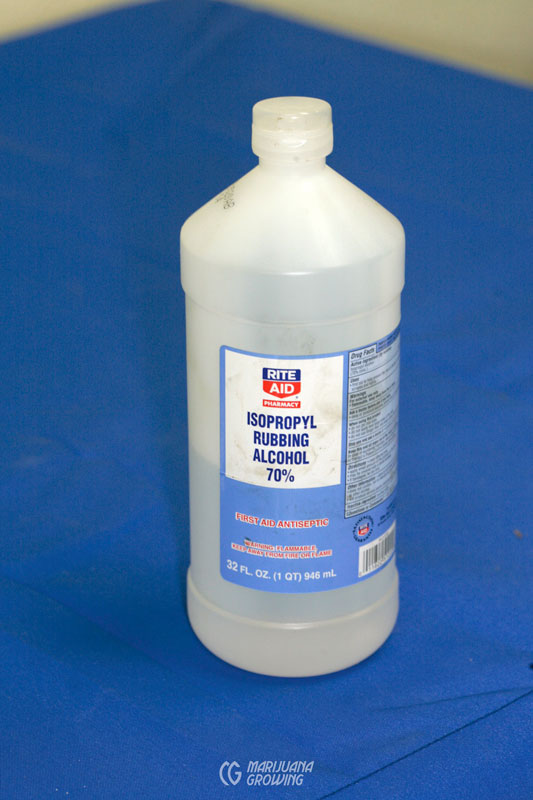
Isopropyl alcohol is widely available.
Recipes for Homemade Mixes to Control Diseases and Pests
Cooking or heating preparations can destroy active ingredients. To draw out (extract) ingredients, mince plant material and soak in mineral oil for a couple of days. Add this oil to the water, including a little detergent or soap to emulsify the oil droplets in water. Biodegradable detergents and soaps are good wetting-sticking agents for these preparations. Soap dissolves best if a teaspoon (5 ml) of alcohol is also added to each quart (0.9 L) of mix.
Chrysanthemum, marigold, and nasturtium blossoms; pennyroyal; garlic; chive; onion; hot pepper; insect juice (target insects mixed in a blender); horseradish; mint; oregano; tomato; and tobacco residues will all repel insects such as aphids, caterpillars, mites, and whiteflies. Spray made from pests ground up in a blender and emulsified in water will reputedly repel related pests. Best used on large pests! The insecticidal qualities in the dead bug parts will degrade quickly if combined with other things; do not include insects mixed in a blender with other ingredients besides water. Mixes that include tobacco may kill these pests if the mix is strong enough. These mixes can vary in proportions, but always filter the blended slurry before combining with water for the final spray. Straining avoids clogging spray nozzles and plumbing.
Recipe One: Mix three tablespoons (44 ml) each of isopropyl alcohol, lemon juice, garlic juice, horseradish juice, Ivory liquid soap, and a few drops each of Tabasco, mint oil, and cinnamon oil. Mix all the ingredients in a small bowl to form a slurry. Dilute the slurry at the rate of one teaspoon per pint (5 ml per 470 ml) of water and mix in a blender. Potent mix!
Recipe Two: Place one teaspoon (5 ml) of hot pepper or Tabasco sauce and four cloves of garlic in a blender with one pint of water. Liquefy, then strain the mix through a nylon stocking or cheesecloth before using it in a sprayer.
Recipe Three: A mix of one-eighth to one-quarter cup (30–60 ml) of hydrated lime combined with a quart (0.9 L) of water makes an effective insect and mite spray. Mix a non-detergent soap with lime. The soap acts as both a sticking agent and an insecticide. Lime can be phytotoxic to plants in large doses. Always try the spray on a test plant and wait a few days to check for adverse effects to the plant before applying to similar plants.
Recipe Four: Liquid laundry bleach (sodium hypochlorite) is a good fungicide for non-plant surfaces. Mix as a 5 or 10 percent solution. It is an eye and skin irritant, so wear goggles and gloves when using it. Mix 1 part bleach to 9 parts water for a 5 percent solution. Mix 1 part bleach to 4 parts water for a 10 percent solution. Use this solution as a general disinfectant for garden room equipment, tools, and plant wounds. The bleach solution breaks down rapidly and has little, if any, residual effect. This mix is an antifeedant when eaten by pests. It performs best in rooms with 60+ percent humidity.
Hydrogen Peroxide (H2O2)
Germicide: disinfectant
Controls: algae and slime
Fungistat: It is said to be helpful in controlling bacterial wilt, Pythium and Fusarium wilts.
Brand names: generic product
About: Hydrogen peroxide acts as an algaecide and disinfectant in water. Although effects are short-lived, they can be devastating to small feeder roots. Do not use H2O2 in hydroponic systems or as a soil drench. Use only to sterilize and clean. It will kill diseases, but not after they have entered the plant’s system. All municipal water systems and old plumbing pipes contain slime mold. H2O2 kills slime mold and lots of other stuff, including algae.
Forms: liquid
Application: Use to kill diseases and pests on harvested cannabis and to clean garden containers, tool, and so forth. H2O2 dissipates quickly when not kept in an airtight container. H2O2 controls diseases on surface for three to five days but can destroy tender feeder roots.
Safety: H2O2 is safe for humans. On contact, it kills pathogens that cause infections. It kills tiny feeder roots on plants.
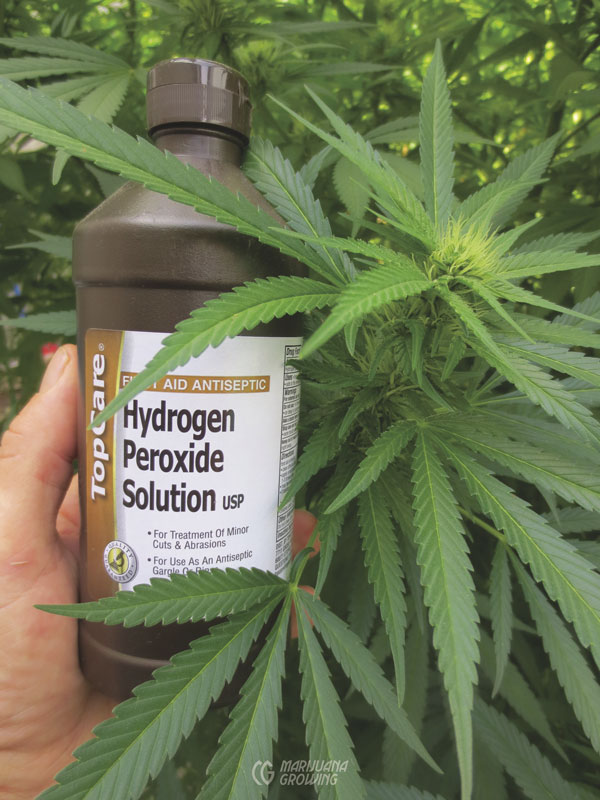
Hydrogen peroxide (H2O2) is readily available and best used to disinfect branches of flower buds after harvest. H2O2 can be destructive if used on live roots, even if diluted in solution.
| CONCENTRATIONS | |
| 0.5–1 cup (118–237 ml) | 6 gallons (22.7 L) water |
| 8 tablespoons (11 ml) | 2 gallons (7.6 L) water |
| 4 tablespoons (59 ml) | 1 gallon (3.8 L) water |
500 to 1,000 ppm is the recommended concentration of 3 percent H2O2 solution. MAKE SURE you are using 3 percent H2O2, NOT a higher concentration. Higher concentrations burn plants and skin.
Limonene
Pesticide: insecticide, miticide
Fungistat: Limonene controls some fungus on the surface of foliage.
Brand names: Concern Citrus Home Pest Control, Clean Green
About: Limonene occurs naturally in citrus fruits, a few vegetables, meats, and spices. It is normally an extract from orange peels (D-limonene). Limonene has insecticidal, miticidal, and fungicidal properties. It is antimicrobial and also a dog and cat repellent. Limonene can be used as a wetting and dispersing agent. It is often used as a solvent in household and industrial cleaners and degreasers. It is very flammable and can be used as a fire starter. It destroys an insect’s system. Effective contact spray.
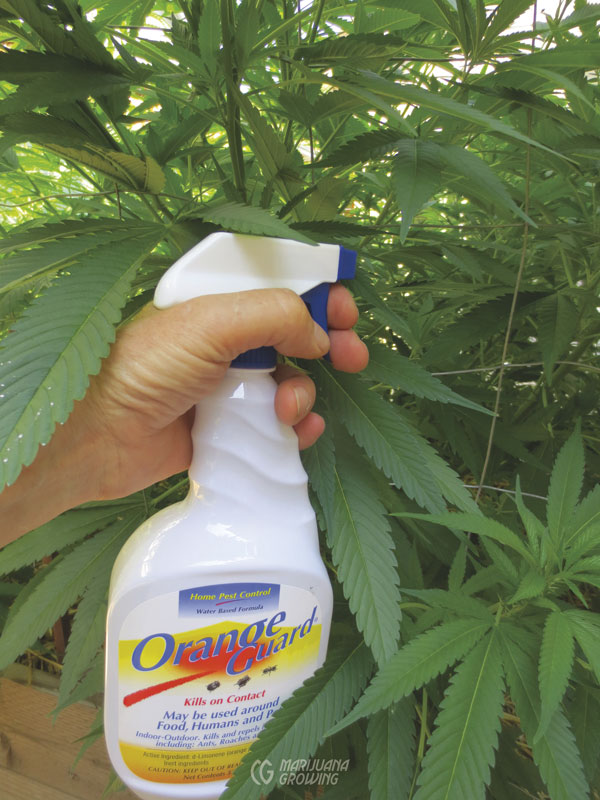
Limonene is found as the base of many natural insecticides.
Mealybug and scale control
Forms: liquid
Mixing: Insoluble in water, must emulify in water. Read instructions on label for tomatoes and vegetables. Corrosive— clean equipment after use.
Application: Follow instructions on label for tomatoes and vegetables.
Safety: can produce localized skin, mucus membrane, and lung irritation on contact. It has a very low toxicity in humans. Keep away from kittens and puppies. Leaves an oily film on water and can be toxic to aquatic life. Corrosive.
Neem and Neem Oil
Pesticide: insecticide, miticide
Germicide: sterilant, disinfectant
Fungistat: controls some fungi on the surface of foliage
Pesticide/miticide controls: many diseases and pests
Brand names: There are many.
About: The Indian neem tree, Azadirachta indica, and the chinaberry tree, Melia azedarach, have spawned a host of insecticides and miticides. The active ingredient, azadirachtin, is most effective against young insects and is available in various concentrations. It is an antifeedant and disrupts insect life cycles. Neem is available in powders, liquids, oils (always use cold pressed oil), and cakes. Different parts of the tree and fruit, including the seeds, are used to make pesticides. Neem also contains nitrogen, phosphorus, potassium, and trace elements. Neem is used for a host of other things too.
Neem’s traditional use is based on its detoxifying benefits that help maintain healthy circulatory, digestive, respiratory, and urinary systems. It is used for external applications in skin diseases. Neem extracts possess antibacterial and antiviral properties. Its principle constituents are nimbin, nimbinin, and nimbidin. All parts of the plant yield B-sitosterol.
Forms: oil, concentrate, liquid
Different products control different insects
Neem controls: Neem is most effective against caterpillars and other immatureinsects, including larvae of whiteflies, fungus gnats, mealybugs, and leaf miners.
Mixing: Neem is often mixed with vegetable (canola) oil. Just before using, add neem to water with a pH below 7.0, and use a spreader-sticker. Agitate constantly while using to keep the mix emulsified. Throw out excess.
Application: Use as a soil drench or add neem to the nutrient solution. This allows neem to enter the plant’s tissue and become systemic. Used in a sprayer, neem becomes a contact spray.
Toxicity: Toxicity to beneficial insects has been reported, but neem is not toxic to humans.
Safety: Neem irritates eyes and skin; wear a mask and gloves. Neem products have numerous other applications. For additional product and safety information, check out the Neem Foundation.
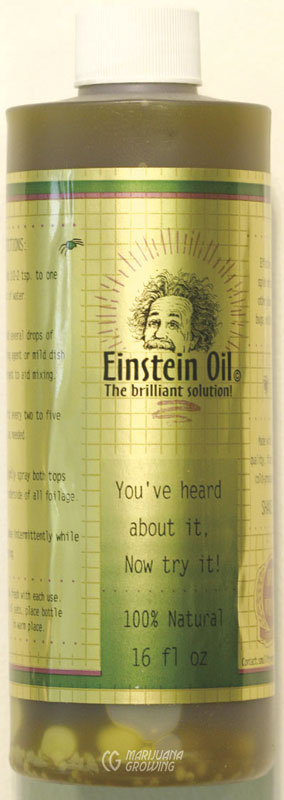
Einstein Oil is a popular brands of neem oil.
Pesticide organic
Neem oil controls: Neem oil is effective against spider mites, fungus gnats, and aphids. It is also a fungistat against powdery mildew and rust.
Brand names: NeemGuard, Triact, Einstein Oil
Mixing: Just before using, mix emulsifiable concentrate in water with a pH below 7.0, and use a spreader-sticker. Agitate constantly while using to keep the mix emulsified. Throw out excess.
Application: Spray on foliage, especially under leaves, where mites live. Apply every few days so hatching larvae will eat it immediately. Spray heavily so mites have little choice but to eat it. Avoid spraying the last few days before harvest. Some growers report a foul taste when applied just before harvest.
Persistence: Contact neem stays on foliage for up to a month or until it is washed off. Stays in plant system up to a month when absorbed via roots.
Toxicity: Toxicity to beneficial insects has been reported, but neem is not toxic to humans.
Safety: Neem irritates eyes and skin; wear a mask and gloves. Neem products have numerous other applications. For additional product and safety information, check out the Neem Foundation.
Botanical insecticide, miticide, and nematicide
AzaMax controls: spider mites, thrips, fungus gnats, aphids, whiteflies, leaf miners, worms, beetles, leafhoppers, scales, mealybugs, nematodes, and other soilborne pests. AzaMax is a natural (neem tree) product with a broad spectrum of pest control and broad plant applications. Contains azadirachtin A and B as active ingredients and more than 100 food-grade limonoids.
Application: AzaMax can be applied up to the time or day of harvest. It leaves no harmful residue on foliage and buds.
Nicotine and Tobacco Sprays
Pesticide: insecticide, miticide
Pesticide organic: sucking and chewing insects
Brand names: There are many brands available.
About: This nonpersistent pesticide is derived from tobacco, Nicotiana tabacum. It is a stomach poison, contact poison, and respiratory poison. This very poisonous compound affects the neuromuscular system, causing pests to go into convulsions and die. Nicotine sulfate is the most common form. Use a spreader-sticker when mixing this liquid. Seldom phytotoxic when used as directed. Combine with insecticidal soap to increase killing ability.
The nicotinoids are new (nicotine-based) systemic insecticides. The active ingredient, imidacloprid, could sell more than all pesticides, but it has no effect on mites or nematodes.
Forms: liquid Mixing: Follow instructions on label for tomatoes and vegetables.
Application: Follow instructions on label for tomatoes and vegetables.
Safety: Nicotine and tobacco sprays are very toxic to most insects (including beneficials), honeybees, fish, and humans for a week to ten days after application. If concentrate is ingested or built up over years, humans may develop lung cancer and other cancers. Wear a mask and gloves; avoid skin and eye contact. Do not swallow any of this vile poison. Do not use around nightshade family—eggplants, tomatoes, peppers, and potatoes—because they may contract tobacco mosaic virus (TMV) from exposure to tobacco-based substances.
Oil, Horticultural
Organic contact pesticide insecticide, miticide
Controls: Virtually invisible, horticultural oil kills slow-moving and immobile sucking insects, spider mites, and their eggs by smothering them.
Brand names: There are many brands available.
About: Similar to medicinal mineral oil, horticultural oils are made from animal (fish) oils, plant seed oils, and petroleum oils re-fined by removing most of the portion that is toxic to plants. Lighter-weight oil (viscosity 60–70) is less phytotoxic. Vegetable oil is also horticultural oil. Mix ¾ teaspoon (75 ml) of oil liquid spray—no more than a 1 percent solution—per quart (0.9 L) of water. More than a few drops could burn tender growing shoots. Spray foliage thoroughly, including the undersides of leaves. Apply oil sprays up until two weeks before harvest. Repeat appli-cations as needed. Usually three applications, one every five to ten days, will put insects and mites in check. Lightweight-oil residue evaporates into the air in a short time.
Forms: oil
Mixing: Follow instructions on label for tomatoes and vegetables.
Application: Follow instructions on label for tomatoes and vegetables.
Safety: Residuals disappear in one to three days under normal growing conditions. Horticultural oil is a safe, nonpoi-sonous, and nonpolluting insecticide. It can become phytotoxic if too heavy (viscosity), if applied too heavily, or when temperatures are below 70ºF (21.1ºC), or when very humid; this slows evaporation, increasing phytotoxicity. Wear a mask and gloves. Do not use lubricating oils such as 3-in-1 or motor oil!
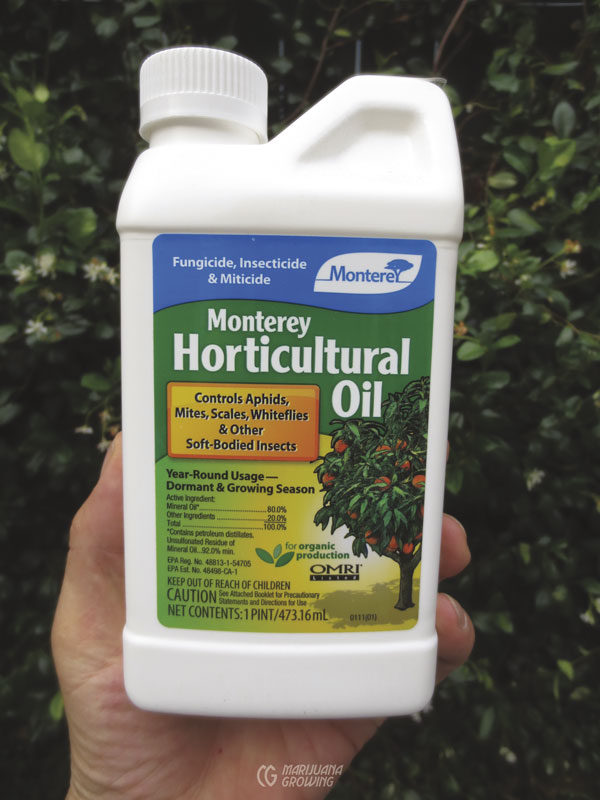
Horticultural oil should be lightweight and organic.
Vegetable Oil
Pesticide: insecticide, miticide
Pesticide organic controls: Vegetable oil is virtually invisible. Like horticultural oil, it kills slow-moving and immobile sucking insects, spider mites, and their eggs by smothering them.
Brand names: There are many brands available at the grocery store.
About: Comprised of fatty acids and glycerides, lightweight vegetable oil smothers slow-moving and immobile sucking insects, spider mites, and their eggs. Mix two drops of oil—no more than a 1 percent solution—per quart of water. Spray foliage thoroughly, including the undersides of leaves. Stop spraying two weeks before harvest.
Forms: oil
Mixing: 1 tablespoon per gallon (15 ml /L)
Application: Mix sparingly in sprays because it tends to decompose and leave a residual that lasts several days.
Safety: Not toxic to mammals or fish. Wear a mask and gloves.
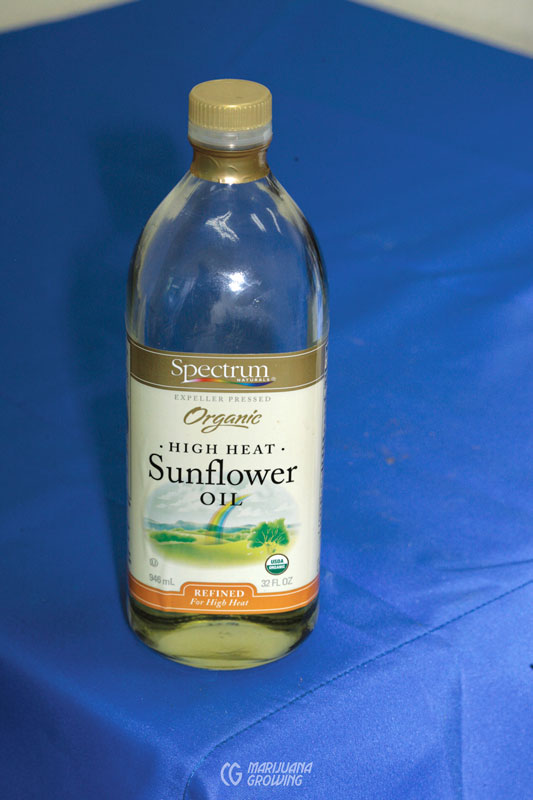
Vegetable oil can be used in the garden, but its use should be limited. Do not add too much vegetable oil in sprays, or the spray will disperse unevenly across leaves.
Predator Urine
Discourages: rabbits, mice, voles, deer, and other animals
Brand names: Piss Off!
About: Predators eat herbivores (plant-eating animals), and predators’ urine scares away cannabis-munching varmints. Create a predator (coyote) urine barrier to frighten off rabbits, mice, voles, deer, and more by applying predator urine around problematic gardens. Note that the urine washes off in a few days. This is why coyotes continually pass by to mark their territory. There are also numerous products containing hot peppers, citrus, eggs, salts, soaps, garlic, and so on that work in varying degrees as repellents. They must be applied properly to be effective.
Use also: fine plastic netting, wire fence
Forms: liquid
Mixing: Follow instructions on label.
Application: Products are often applied via weatherproof applicators or “scent rags” hanging around the garden. Follow instructions on label for tomatoes and vegetables.
Safety: Do not let any spill on you!
Pyrethrum
Pesticide: insecticide, miticide (broad spectrum)
Controls: Pyrethrum kills aphids, whiteflies, spider mites, and insects— including beneficials. It is very effective to control flying insects, but they must receive a killing knockdown dose.
Brand names: Whitmire’s X-clude is encapsulated and lasts longer
About: Natural pyrethrum is extracted from the flowers of the pyrethrum chrysanthemum, Chrysanthemum coccineum and C. cinerariifolium. Pyrethrins—pyrethrins, cinerins, and jasmolins—are the active ingredients in natural pyrethrum and kill insects and mites on contact. Pyrethroids are axonic poisons that affect nervous system of insects and mites, eventually causing paralysis.
Synthetic pyrethroids act as broad-spectrum, nonselective contact insecticides and miticides. There are more than 30 synthetic pyrethroids available in different formulations. Deltamethrin is available as a sticky paint that is used as a trap when applied to stems and colored objects. Many insects and mites are resistant to pyrethroids.
Natural pyrethrum is expensive and decomposes rapidly in sunlight, with a short effective life. Synthetic pyre-thrin-like materials, pyrethroids are stable in sunlight and are effective against insect and mites.
Pyrethrums have gone through four evolving generations:
1. Pyrethrum, naturally occurring
2. Tetramethrin, resmethrin (Synthrin, 20 times as effective as pyrethrum), bioresmethrin (50 times as effective as pyrethrum)
3. Permethrin is virtually unaffected by ultraviolet light in sunlight, lasting four to seven days on crops.
4. Current generation, bifenthrin, cypermethrin, cyfluthrin, deltamethrin, esfenvalerate, fenpropathrin, flucythrinate, prallethrin, tau-fluvali-nate, tefluthrin, tralomethrin, zeta-cy-permethrin. All are photostable. They do not degrade in sunlight, and the residual effectiveness is up to ten days.
Pyrethrum is often combined with other botanical pesticides—rotenone, ryania, etc.—to ensure effectiveness. Aerosol forms contain synergists. (See “Application” below.) Pest insects and mites become immune to pyrethrins; alternating with other sprays works best.
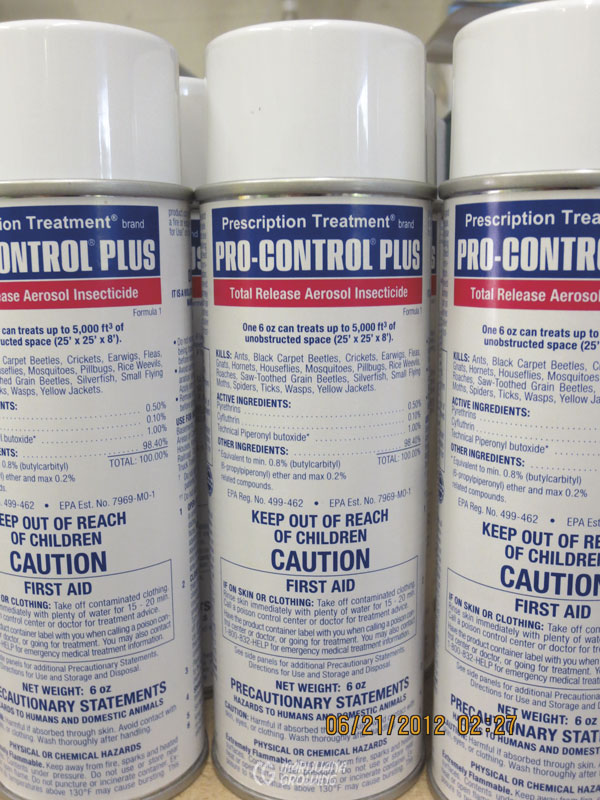
Pro-Control Plus is one of many brands of encapsulated pyrethrum available. Whitmire’s X-clude is another brand-name product with encapsulated pyrethrum that lasts several hours after application.
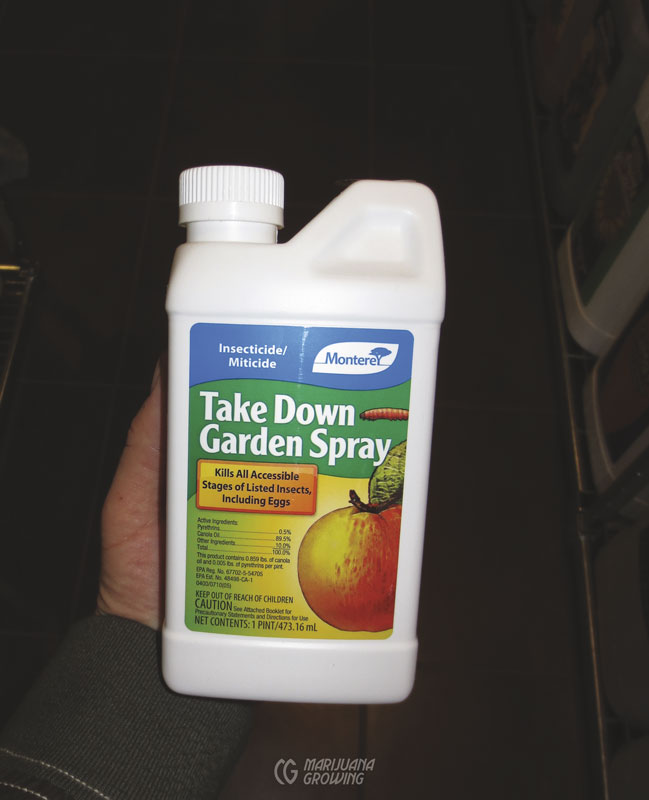
Liquid pyrethrum can be as effective as aerosol brands if it covers foliage completely.
Synthetic Pyrethroids
Nonselective pyrethroids: kill all insects and mites, including beneficials and bees
Forms: powder, liquid, aerosol Mixing: Follow instructions on label.
Application: Follow instructions on label. Make sure to spray undersides of leaves so spray contacts pest insects and mites.
Persistence: 30 minutes to several hours
Toxicity: Toxic to all insects. Synthetic pyrethroids are somewhat toxic to mammals.
Safety: Wear a mask and protective clothing when applying sprays or breathing in any form of pyrethrum, especially aerosols. Aerosols contain toxic piperonyl butoxide (PBO) and MGK 464—possible carcinogens that are easily inhaled.
Caution: Do not mix with sulfur, lime, copper, or soaps. The high pH of these substances render the mix ineffective. Wash these substances off foliage with plain water (pH below 7.0) before applying pyrethrum.
Application: Spot spray infested plants. Aerosol sprays are most effective on spider mites. This can burn foliage—spray is ice-cold when it exits the nozzle—if applied closer than one foot. Aerosol spray contains a synergist, PBO or MGK 264. Both are toxic to people. Pyrethrum dissipates within a few hours in the presence of air, HID light, and sunlight. Overcome this limitation by applying just before turning off the lights, the circulation, and vent fans for the night. Use encapsulated aerosol pyrethrum.
Persistence: Effective several hours after application when the lights are on, longer when applied after lights-out and the fan is turned off.
Forms: wettable powder, dust, liquid, granular bait, and aerosol
Toxicity: Synthetic pyrethroids are not toxic to animals and humans when eaten but become toxic to people when inhaled. Toxic to fish and beneficials.
Safety: Wear a mask and protective clothing when applying sprays or breathing in any form of pyrethrum, especially aerosols. Aerosols contain toxic PBO and MGK 464 (possible carcinogens), which are easily inhaled. The pyrethroids have a low-to-moderate acute toxicity to mammals and may be irritating to the skin.
Quassia, Rotenone, Ryania, and Sabadilla
This “group” of pesticides—quassia, rotenone, ryania, and sabadilla—is often combined to improve pest kill rate.
Quassia
Pesticide: insecticide, miticide
Controls: Soft-bodied insects including aphids, leaf miners, and some caterpillars.
About: Quassia is made from a subtropical South American tree, Quassia amara, and the tree-of-heaven, Ailanthus altissima. It is most often combined with rotenone, ryania, and sabadilla because it is difficult to extract.
Mixing: Follow instructions on label for tomatoes and vegetables.
Application: Follow instructions on label for tomatoes and vegetables. Quassia stays active for two to five days on the surface of plants. Safety: Wear a mask and gloves; cover exposed skin and hair. Avoid skin contact.
Toxicity: Quassia is safe for mammals and (possibly) beneficials.
Rotenone
Pesticide: insecticide
About: Rotenone is an extract from roots of several plants, including Derris species, Lonchocarpus species, and Tephrosia species. Rotenone is a nonselective contact insecticide, stomach poison, and slow-acting nerve poison.
Controls: Nonselective control of beetles, caterpillars, flies, mosquitos, thrips, weevils, and beneficial insects, but death is slow. According to Hemp Diseases and Pests, target insects can consume up to 30 times their lethal dose before dying!
Forms: powder, wettable powder, liquid
Mixing: Follow the manufacturer’s instructions.
Application: Rotenone breaks down in three to ten days.
Toxicity: This insecticide kills beneficials, birds, and fish; the effect on mammals is undetermined. Chronic exposure may cause Parkinson’s disease.
Safety: Wear a mask and gloves; cover exposed skin and hair. Avoid skin contact.
Ryania
Pesticide: insecticide
Controls: Ryania is toxic to aphids, thrips, European corn borers, hemp borers, flea beetles, leaf rollers, and many caterpillars. Once pests consume ryania, they stop feeding immediately and die within 24 hours.
Forms: powder, wettable powder
Mixing: Follow instructions on label for tomatoes and vegetables.
Application: Follow instructions on label for tomatoes and vegetables. Stays for active two weeks or longer.
Safety: Wear a mask and gloves; cover exposed skin and hair. Avoid skin contact.
Toxicity: somewhat toxic to mammals, birds, fish, and beneficials.
Sabadilla
Pesticide: insecticide, miticide
About: This alkaloid pesticide is made from the seeds of a tropical lily, Schoenocaulon officinale, native to Central and South America, and a European hellebore, Veratrum album.
Controls: A contact and stomach poison, this centuries-old poison controls aphids, beetles, cabbage loopers, chinch bugs, grasshoppers, and squash bugs.
Forms: powder, liquid
Mixing: Follow instructions on label for tomatoes and vegetables.
Application: Sabadilla is most potent when applied at 75ºF to 80ºF (23.9ºC–26.7ºC). Follow directions on package.
Persistence: two or three days
Toxicity: Sabadilla is somewhat toxic to mammals, toxic to honeybees.
Safety: Wear a mask and gloves; cover exposed skin and hair. Avoid skin contact.
Seaweed
Pesticide: insecticide, miticide organic
Brand names: There are many brands; check with your local hydroponic store or retail nursery for a recommendation.
About: Seaweed contains numerous elements, including nutrients, bacteria, and hormones.
Controls: Suspended particles in seaweed impair and even kill insects and spider mites by causing lesions. The particles cut and penetrate soft-bodied pest insects and mites, causing their body fluids to leak out.
Forms: powder and liquid
Mixing: Dilute as per instructions for soil application.
Application: Spray on foliage, especially under leaves where mites live. Stays active up to two weeks when a spreader-sticker is used.
Toxicity: Seaweed is not toxic to mammals, birds, or fish, but it is nonselective and kills beneficials.
Safety: Wear a mask and gloves.
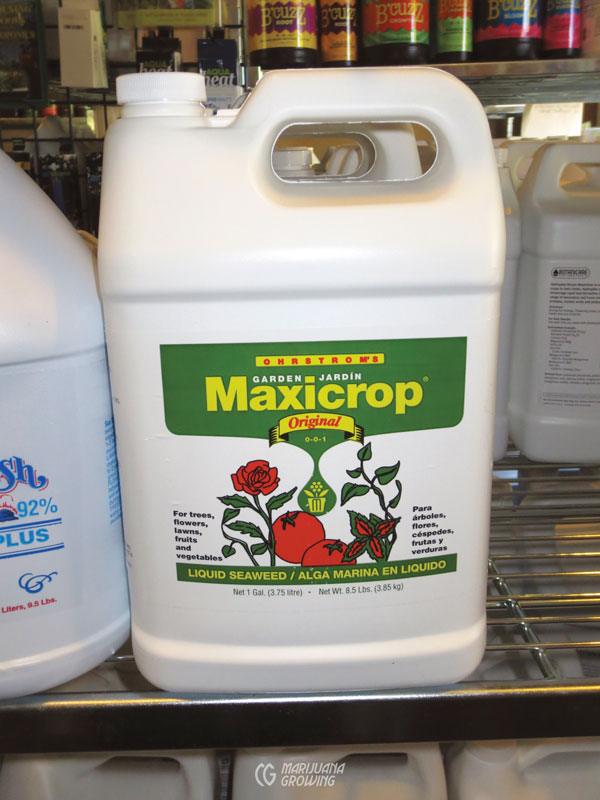
Seaweed can be applied to foliage in a dilute spray to kill insects and mites.
Sevin, carbaryl
Pesticide: insecticide, miticide Controls: Sevin is often used to kill bees and wasps; it kills all insects, good and bad!
Brand names: Sevin
About: The development of carbamate insecticides in the 1950s was a major breakthrough because they do not persist as long as chlorinated pesticides. Carbaryl is broad spectrum, killing both targeted and beneficial insects and crustaceans. Carbaryl is detoxified and eliminated rapidly in vertebrates. It does not concentrate in fat and milk.
Forms: liquid, powder
Mixing: Follow instructions on label for tomatoes and vegetables. Application: Follow instructions on label for tomatoes and vegetables.
Safety: Carbaryl is toxic to humans and is considered a likely human carcinogen by the EPA. Carbaryl is illegal in several countries, including the United Kingdom, Austria, Denmark, Sweden, Iran, Germany, and Angola.
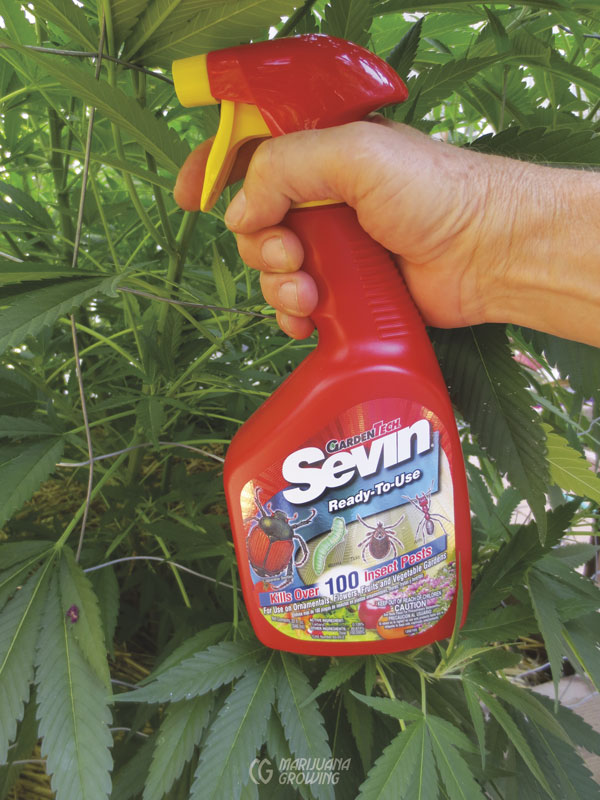
Sevin is a very strong insecticide often used to kill wasps.
Soap, Insecticidal
Pesticide: insecticide, miticide
Brand names: There are many brands available
About: Insecticidal soaps are contact insecticides made from fatty acids of animals and plants and are considered organic. A variety of soaps are available in potassium-salt-based liquid concentrates. Soft soaps such as Ivory liquid dish soap, Castile soap, and Murphy’s Oil soap are biodegradable and kill insects in a similar manner to commercial insecticidal soaps, but they are not as potent or effective.
Controls: Insecticidal soaps control soft-bodied insects such as aphids and mealybugs, spider mites, thrips, and whiteflies by penetrating and clogging body membranes.
Caution: Do not use detergent soaps, because they may be caustic.
Forms: liquid
Mixing: Add a few capfuls of soap to a quart of water to make a spray. Ivory or Castile soap can also be used as a spreader-sticker to mix with other sprays. The soap helps the spray stick to the foliage better.
Application: Spray at the first appearance of insect pests. Follow directions on commercial preparations. Spray homemade mixes every four to five days. Soft soaps will last only for about a day before dissipating.
Toxicity: These soaps are safe for bees, animals, and humans.
Safety: Wear a mask and gloves.
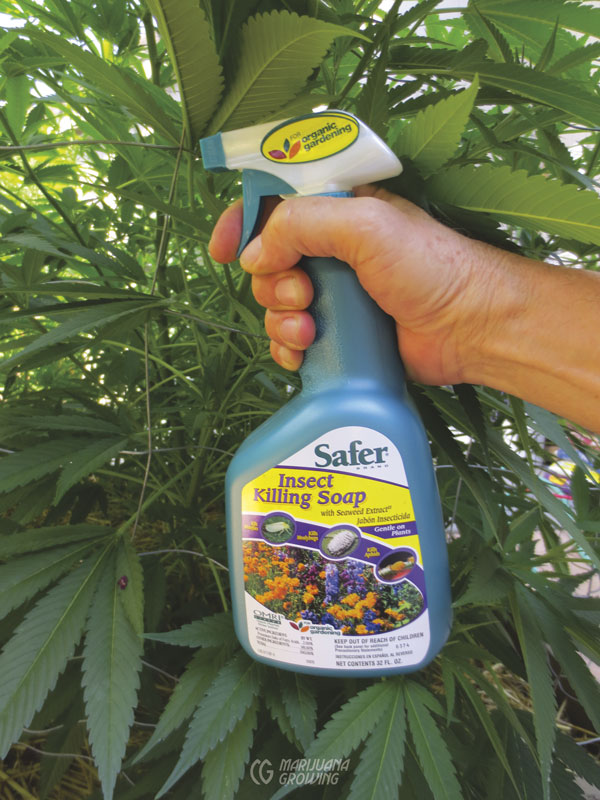
Applying insecticidal soap is one of the first control measures in the garden.
Spinosad
Pesticide: insecticide, miticide organic
Brand names: Spinosad
About: Spinosad (spinosyn A and spinosyn D) is a new chemical class of insecticides. The active ingredient is derived from the rare species bacterium Saccharopolyspora spinosa actinomycete. Spinosad kills susceptible species by exciting the nervous system after being ingested by the insect. Spinosad must be ingested by the insect, therefore it has little effect on sucking insects and nontarget predatory insects. Spinosad is relatively fast-acting. The pest insect dies within one to two days after ingesting the active ingredient. It is classified as an organic substance by the USDA National Organic Standards Board. The Organic Materials Review Institute (OMRI) listed Spinosad for use in organic production.
Controls: Fruit flies, caterpillars, leaf miners, thrips, sawflies, spider mites, fire ants, and leaf beetle larvae. It kills caterpillars, fire ants, fruit flies, leaf beetle larvae, leaf miners, sawflies, spider mites, and thrips.
Forms: liquid
Mixing: Mix 4 tablespoons per gallon of water.
Application: Follow instructions on label.
Toxicity: Spinosad has low mammal toxicity when ingested and no adverse effects from chronic exposure. There is a slight toxicity to birds, moderate toxicity to fish, and moderate toxicity to aquatic invertebrates. It is highly toxic to bees and to oysters and other marine mollusks. Avoid application where it is toxic.
There is little or no phytotoxicity for cannabis. To prevent insect pesticide resistance, do not spray Spinosad more than 10 times in 12 months in a garden room or greenhouse.
Safety: Always wear protective clothing when spraying Spinosad.
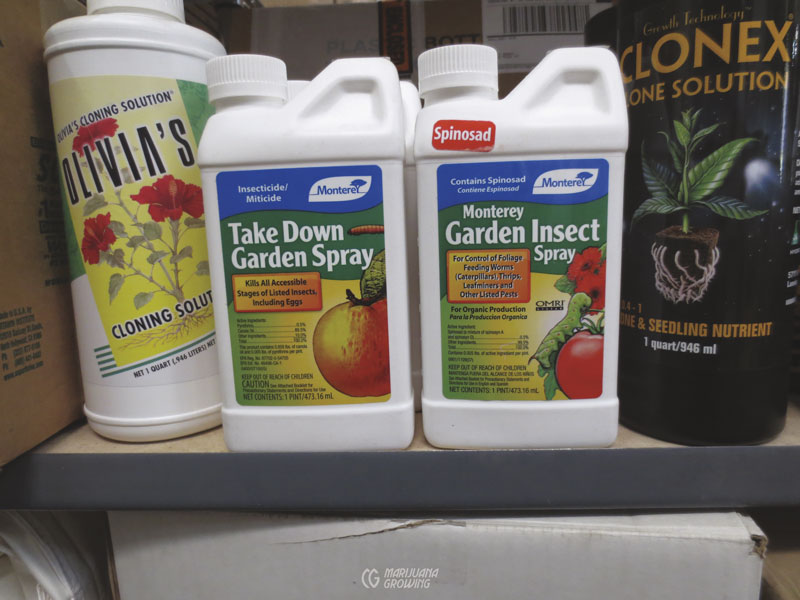
Spinosad is a great natural pesticide against caterpillars, thrips, and leaf miners.
Streptomyces griseoviridis
Fungicide Beneficial bacteria organic controls: fungi that cause seed rot, root and stem rot, wilt, and damping-off diseases
Brand names: MycoStop, RootShield, Microgrow
About: More than 500 species of Strep-tomyces bacteria are known. Streptomy-ces griseoviridis strain K61 is a naturally occurring soil bacterium that was isolated from decaying peat in Finland. It produces spores that cause it to have an earthy odor. It works to prevent fungal attacks and must be applied before fungi invade. Streptomyces griseoviridis colonizes plant roots before the disease organisms arrive, displacing the bad guys taking their food. It also makes other chemicals that attack harmful fungi. This fungicide is effective against Al-ternaria, Botrytis, Fusarium, Phomopsis, and Pythium. Streptomyces bacteria also produce secondary chemicals, root-stim-ulating hormones that increase germination, as well as root growth and overall plant vigor. Applying S. griseoviridis is an excellent prevention measure to use in Integrated Pest Management (IPM) programs.
Apply fungicide as a preventative measure before any sign of harmful fungus so S. griseoviridis has a chance to colonize and get established to prevent harmful fungal attacks. Apply to seeds, soil, or roots, and to transplants as a dip or spray.
Forms: wettable powder (dried spores and mycelium)
Mixing: Follow instructions on label for tomatoes and vegetables.
Application: Follow instructions on label for warm weather crops—tomatoes, peppers, etc.
Safety: OMRI Listed for use in organic production. Wear protective gear including a respirator that filters dust and mist when handling. Mild skin, eye and lung irritation is possible. Watch for possible side effects on pH and EC.
Sulfur
Sulfur Burners and Pests Fungicide
Beneficial bacteria organic controls: Sulfur protects against fungi that cause seed rot, root and stem rot, wilt, and damping-off diseases.
Brand names: MycoStop, RootShield, Microgrow
About: Streptomyces griseoviridis strain K61, a naturally occurring soil bacterium, colonizes plant roots before the disease organisms arrive, displacing the bad guys taking their food. It also makes other chemicals that attack harmful fungi. This fungicide is effective against Alternaria, Botrytis, Fusarium,Phomopsis, and Pythium. Streptomyces bacteria also produce root-stimulating hormones that increase germination, as well as root and plant vigor. Apply before any sign of harmful fungus. Apply to seeds, to the soil, to roots, to transplants as a dip or spray. Apply before diseases start so the Streptomyces griseoviridis has a chance to get established and can prevent harmful fungal attacks.
Forms: powder
Mixing: Follow instructions on label for tomatoes and vegetables.
Application: Follow instructions on label for warm weather crops—tomatoes, peppers, etc..
Safety: OMRI Listed for use in organic production. Watch for possible side effects on pH and EC.
Pesticide: insecticide Pesticide/miticide/fungicide
Brand names: many
About: Sulfur is a centuries-old fungicide that is toxic to insects and controls fungus but is also quite phytotoxic to plants if overdone. Application temperatures should be about 60ºF (about 15ºC). Sulfur can be applied directly to foliage or evaporated into the air in an enclosed area when using a sulfur burner.
Sulfur is easiest and most economical to apply in a liquid spray. Sulfur mixed with liquid must not stay on foliage or it will burn and damage it. Follow instructions on the product label. Sulfur evaporated in a garden room stops Botrytis cinerea and powdery mildew from growing on surfaces and plants, but it does not enter the system of the plant. Use only high-grade refined sulfur. Sulfur burners heat sulfur to evaporate it into the atmosphere of garden rooms and greenhouses. Evaporated or volatized sulfur hangs in the air and coats surfaces when it falls.
Controls: Sulfur can kill mildews, Botrytis, and more diseases and pests such as spider mites.
Caution: Do not apply in temperatures above 90ºF (32ºC) and less than 50 percent humidity. It will burn foliage.
Forms: powder
Mixing: Follow directions on package.
Application: Apply in light concentration. It is phytotoxic during hot, arid weather. Follow instructions on label for tomatoes and vegetables.
Evaporated sulfur: Turn off the vent fans and lights when using evaporated sulfur. Apply one hour after lights go off. Apply for at least two hours to be effective. Exhaust for three hours before lights come back on. Apply weekly, biweekly, or more often. Do not apply two weeks before harvest.
Sulfur dusted on the floor of garden rooms volatilizes in arid climates to pro-vide long-term protection from infection. Phytotoxicity can be a problem during high temperatures. Sulfur stays on foliage several days or until washed off.
Toxicity: Too much sulfur results in burned pistils in the buds closest to the evaporator. Way too much sulfur turns the leaves yellow in the margins between the veins. Sulfur is toxic to insects but phytotoxic to plants. It is not toxic to honeybees, birds, and fish.
Safety: Wear a mask, gloves, and safety goggles; cover exposed skin and hair. Avoid skin, eye, ear, and nose contact. Sulfur irritates eyes, lungs, and skin.
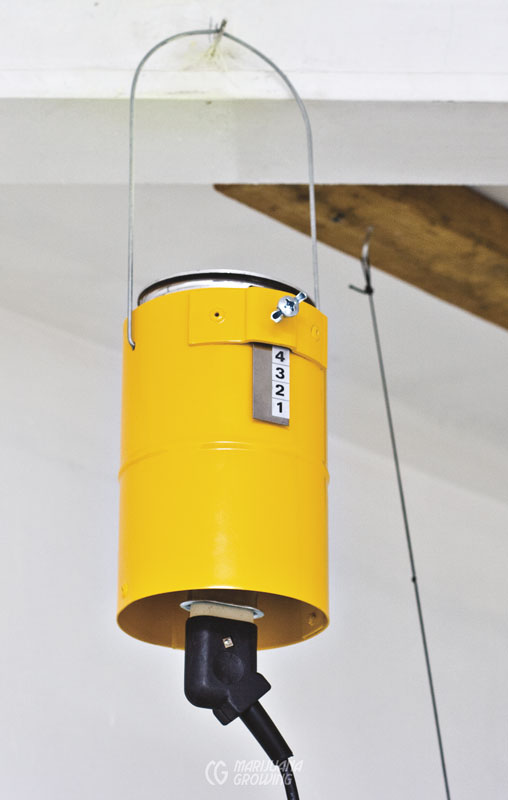
A thin coat of sulfur on foliage will kill many insects, mites, and eggs. It also makes an inhospitable environment for newly germinating fungal spores. Vaporized sulfur is not labeled for insect control even though it is toxic to insects, as well as desiccating.

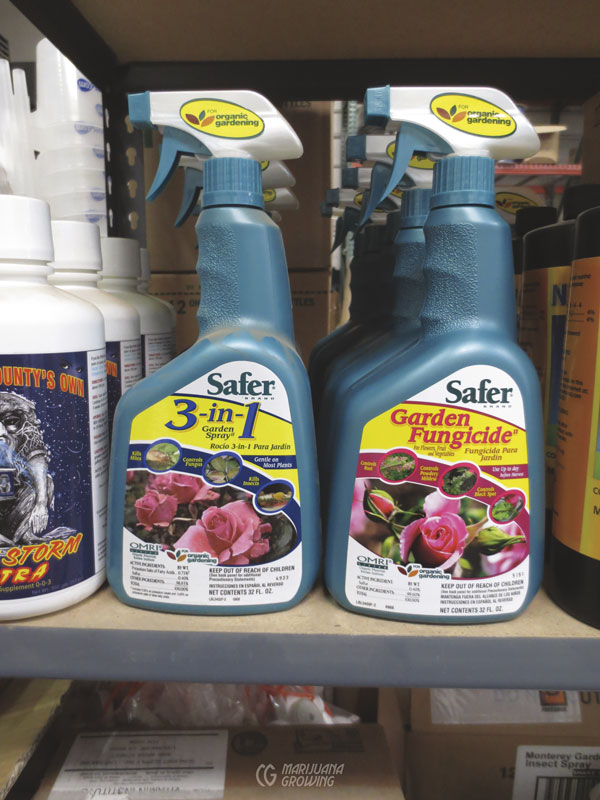
Sulfur fungicides are very strong and can burn foliage if applied when temperatures are too hot.
Sulfur is a common ingredient in many fungicides.
Trichoderma
Beneficial fungi organic controls
Brand names: Trichoderma is sold under many brand names; look for the word trichoderma on the label or ingredients list.
About: Trichoderma is added to many soil mixes and hydroponic growing mediums to protect plants from diseases and pests and increase plant vigor. Trichoderma spp. are common free-living fungi found in soil and root ecosystems. Some varieties colonize roots and release antifungal antibiotic compounds that induce resistance to diseases and pests. Trichoderma enhances root growth and development, crop productivity, resistance to abiotic stresses, and the uptake and use of nutrients.
Forms: Trichoderma is mixed in various products.
Mixing: Follow instructions on label for tomatoes and vegetables.
Application: Follow instructions on label for tomatoes and vegetables.
Safety: safe
UVC Light
Disinfectant, germicide, miticide, insecticide
Brand names: Big Blue, Turbo Twist, Air Probe Sanitizer
About: Germicidal UVC light deactivates the DNA of mites, bacteria, viruses, and other diseases in air, liquids, on surfaces, and on plants. The diseases die or try to reproduce and then die. This natural purifier also kills allergy- and disease-causing microbes. Special UVC lamps are available and produce no residual contamination. Low-level mercury lamps made from special glass emanate 253.7 nanometers, precisely the bandwidth to kill diseases. UVC light is a sterilant and germicide. It destroys any microorganisms that may be directly exposed to it. UV light has little penetrating ability and is unable to pass through opaque material, glass, or water. Quartz is transparent to UV light. UV rays from sunlight are filtered off by the time the sun’s light reaches earth’s surface.
Application: UVC light is used to sterilize medical cannabis in The Netherlands. Run buds under UVC light for a few seconds to kill bad stuff such as mold, mold spores, and Botrytis.
Forms: artificial light
Safety: UV light is damaging to the skin and eyes. Avoid all contact!

Regular applications of UVC light with a small handheld lamp will help keep pathogens and pests out of your garden.
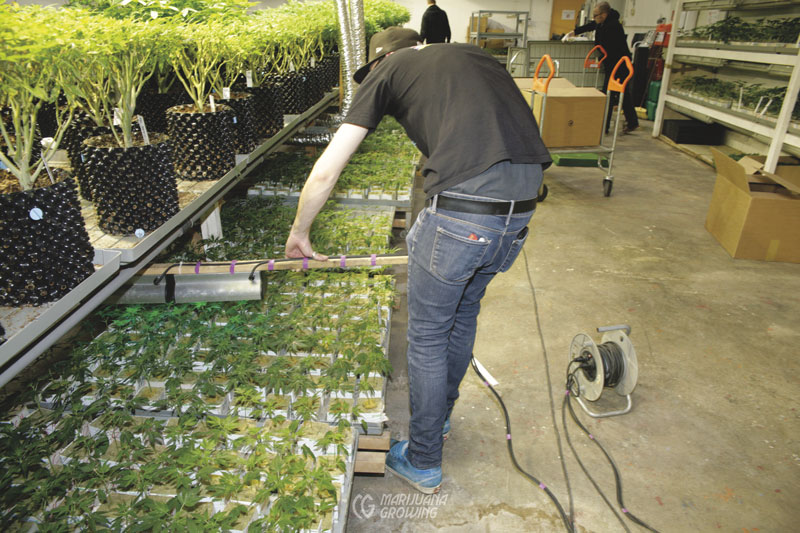
Ultraviolet light works incredibly well to kill molds and mildews. The gardener passes the UVC lamp briefly over the tender little clones every day to kill any new mold spores. You can also spot mold in the garden with a UVB or green light. I put my headlamp on and walk around the garden at night looking for signs of iridescent mold on foliage.
Vinegar
Pesticide: insecticide
Germicide: disinfectant
Fungistat: kills many fungi on contact
Pesticide/miticide Controls: Vinegar helps with many garden problems. See “Application” below.
Brand names: generic
About: Table vinegar ranges in concentration from 4 percent to 8 percent by volume. Pickling vinegar can be up to 18 percent. Any type of vinegar can be dis-tilled into a white (colorless) solution of about 4 percent to 8 percent acetic acid in water. White vinegar is used for cleaning and sterilizing. Find white distilled vinegar at your local grocery store.
Forms: liquid
Mixing: Dilute in water.
Application: To preserve cut flower buds, add 2 tablespoons (30 ml) white distilled vinegar and 1 teaspoon sugar (5 ml) to a quart of water in a glass. Clean pots with a 50 percent solution of white distilled vinegar. Remove rust on spigots and tools by soaking overnight in undiluted white distilled vinegar. Neutralize garden lime by adding white distilled vinegar to the area. Increase the acidity of soil by adding white distilled vinegar to your watering can. Eliminate anthills by pouring white distilled vinegar into them. Kill slugs by spraying them with a 1:1 vinegar:water mix using white distilled vinegar. Catch moths with a mixture composed of 2 parts white distilled vinegar and 1 part molasses. Dangle the mix in a tree. Cats, dogs, and rabbits are repelled by vinegar-soaked cotton balls. Put them in a small container with a few holes in it to let the smell out. Remove mold from terra cotta pots by soaking in a solution of 1 cup white distilled vinegar, 1 cup chlorine bleach, and 1 gallon of warm water before scrubbing with a steel wool pad.
Safety: Vinegar has a low pH and is corrosive. It also smells bad!
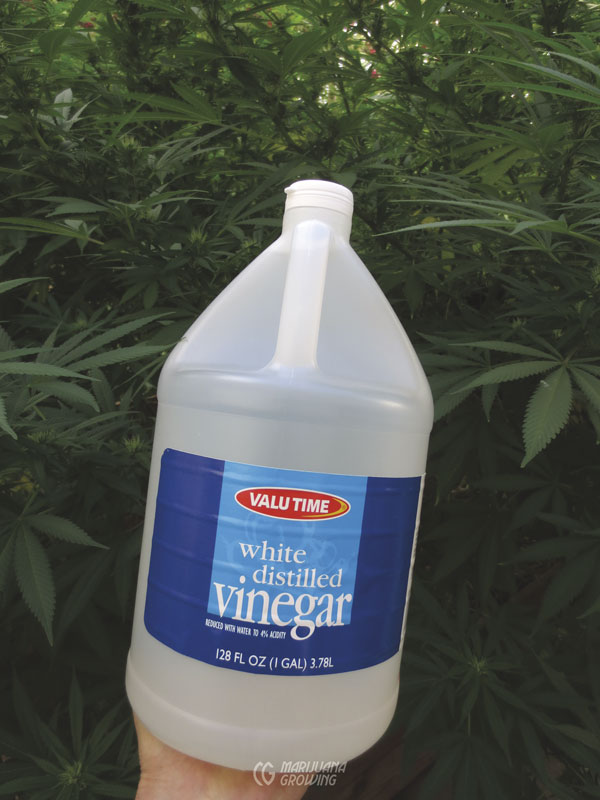
Vinegar has a low pH and can be used as a disinfectant and to decalcify plumbing and reservoirs. It is inexpensive and smells bad.
Traps
Pesticide: insecticide, miticide
Brand names: Tanglefoot
About: Sticky traps, such as Tanglefoot resins, can be smeared on attractive yellow or red cards to simulate ripe fruit. When pests land on the “fruit,” they are stuck forever!
Controls: Traps help contain spider mites and nonflying insects within the bounds of the barriers. Traps monitor fungus gnat populations and help control thrips. Other insects get stuck haphazardly to the sticky stuff. Black-light traps catch egg-laying moths and other flying insects, most of which are not plant pests. Light and fan traps attract many insects including beneficials, and their use may do more harm than good. Sex-lure traps exude specific insect pheromones, sexual scents, of females that are ready to mate. These traps are most effective to monitor insect populations for large farms.
Caution: Do not touch sticky substance. It is difficult to remove!
Forms: sticky, thick paint
Mixing: Follow directions on container. Smear on desired objects.
Application: Smear Tanglefoot around the edges of pots, base of stems, and at the end of drying lines to form an impenetrable barrier-trap against mites and insects. This simple precaution helps keep mites isolated. However, resourceful spider mites can spin a web above the barrier. The marauding mites also ride from plant to plant on the air currents created by fans! Tanglefoot is persistent until it is wiped off or completely fouled with insect bodies.
Toxicity: Traps are not toxic to mammals or insects. Trapped insects and mites starve to death.
Safety: Wear gloves, and do not breathe fumes. Read and follow directions.
Sticky Yellow Traps
Hang sticky yellow traps around your growing area to catch whiteflies, adult fungus gnats, winged aphids, and many other garden pests. They’re not only effective pest control, they’re also a great early warning system. Pests are much easier to spot against the yellow than on your plants. Place the traps about three feet (about 90 cm) apart within or just above plant foliage.
Sticky blue traps: Similar to the original sticky yellow traps, sticky blue traps attract pests to the blue portion of the color spectrum. Customers report success using Sticky Blue Traps against thrips and leaf miners.
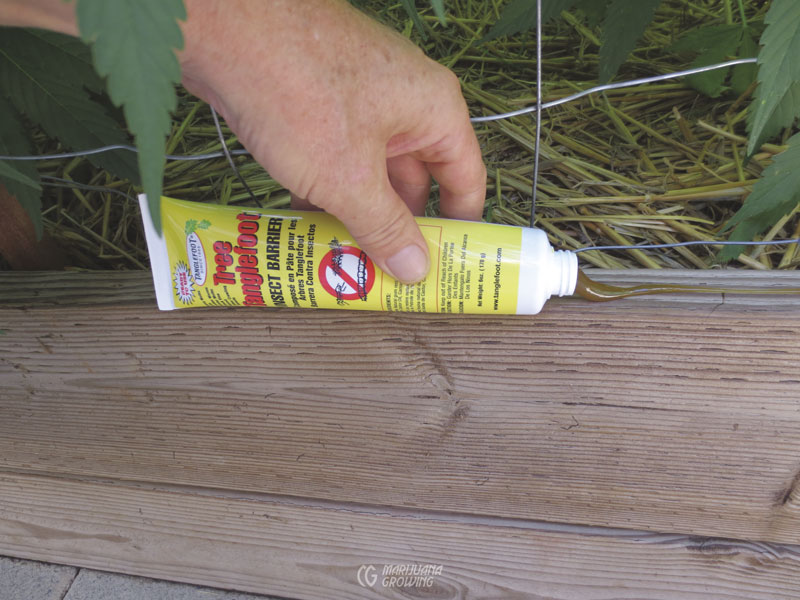
Tanglefoot is an excellent product that keeps pests from crossing a given boundary. Wipe on stems, container lips, drying lines, and more to contain pests.
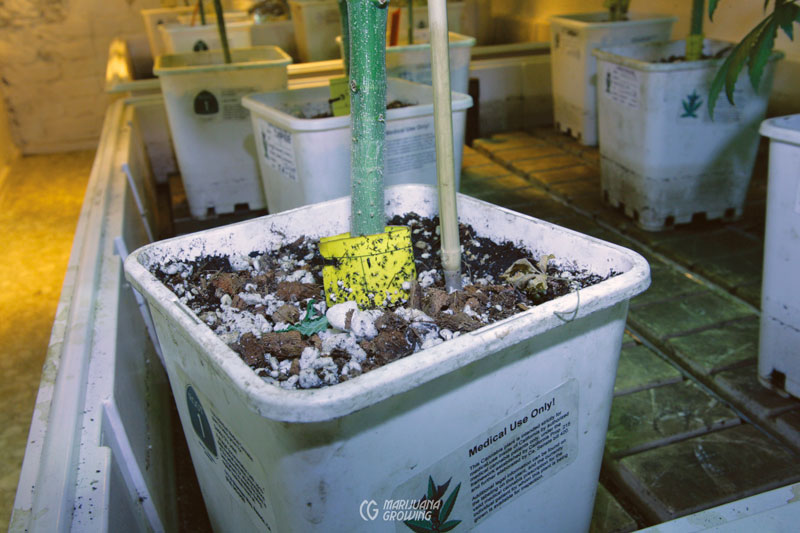
Sticky yellow traps can be used to monitor insect activity and to trap pest insects over time.
Water
Pesticide: insecticide, miticide organic
Brand names: Use tap water or reverse osmosis (RO) water. Bottled water is too expensive.
About: A cold jet of water—preferably with a pH between 6.0 and 7.0—blasts insects, spider mites, and their eggs off leaves, often killing them. Hot water vapor and steam also work as a sterilant.
Controls: A cold jet of water is an excellent first wave of attack against spider mites, aphids, and other sucking insects. Steam controls spider mites, insects, and diseases on pots, growing mediums, and other grow-room surfaces.
Caution: Avoid spraying fully formed buds with water. Standing water in or on buds promotes gray mold. Do not apply hot steam to foliage.
Forms: liquid
Mixing: Use RO or low-EC water when possible.
Application: Spray leaf undersides with a jet of cold water to knock off sucking spider mites and aphids. Apply water as a mist or spray when predatory mites are present. The extra humid conditions impair the pest mite lifecycles and promote predatory mite health. Rent a wallpaper steamer. Get it cooking, and direct a jet of steam at all grow-room cracks and surfaces.
Toxicity: Water is not toxic to mammals, fish, or beneficials.
Safety: Do not spray strong jet of water in eyes, up nose, or into other body orifices.
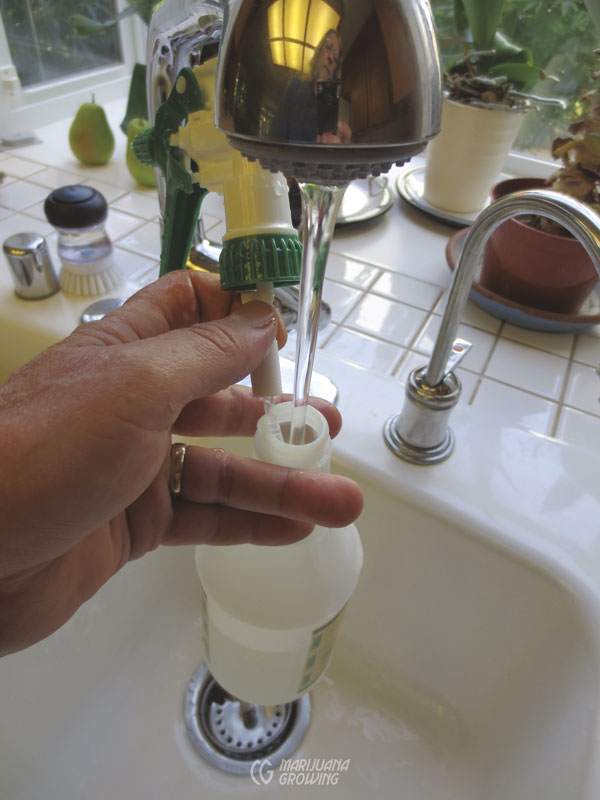
Water is a great pesticide. Spray foliage vigorously with water to dislodge and mutilate insects and their eggs. Often a brisk water spray will be all the insect control necessary on outdoor plants.
Beneficial Insects
The predators for specific insects and mites are listed in the entry after each pest under “Beneficial Insects.” This section is about predators, how to identify them, and how to receive, introduce, and apply their help in medical cannabis gardens. Predators and parasitoids are the two types of predators. Most predators are larger than their prey. Parasitoids are typically smaller than hosts. Parasites lay eggs on or inside the host. The eggs hatch into larvae and eat the host from the inside out. Parasites kill one to several hosts.
Predators kill many pest prey. Predator and parasite availability and supply have changed substantially over the last few years. Today many more beneficial insects are available to medical cannabis gardeners than ever before. Shipping, care, cost, and application of each predator or parasite is very specific and detailed instructions should be provided by the supplier.
Make sure the supplier answers the following:
1. Latin name of the predator, so there is no confusion as to identity
2. Specific pests attacked by the predator
3. Life cycle information
4. Preferred climate, including temperature Application rate and mode of application
For more information about predators, check out the following web pages: Nature’s Control, Koppert Biological Systems, University of Wisconsin-Madison, Department of Entomology
By definition, a predator must eat more than one victim before adulthood. Some predators such as ladybugs (ladybird beetles) and praying mantises have chewing mouthparts to eat their prey whole. But lacewing larvae have piercing-sucking mouthparts to suck the life from victims. Typically adult parasitoids insert a single egg into many hosts. The egg hatches for the larva to eat the host from the inside out, often emerging as adults.
Predators like to be surrounded by prey. When the prey population diminishes, predators look for infestations where food is easy to find. They never completely eradicate the pest insects. Predators are best used for preventive control.
Of all insect species, more than 97 percent of those usually found around the home landscape are beneficial or are not interested in cannabis.
To get the most from predators, get used to a little pest damage on plants. Cannabis is tough and can deal with the damage. Beneficials also need shelter in the form of leaf litter and debris (mulch) to hide and cool down on hot days. Growing other non-cannabis plants helps provide a diverse environment to accommodate other natural enemies of pests.
Most beneficials stay in the garden when there is a constant source of pollen and nectar (available commercially) substitutes available when prey is scarce. Flowers and plants that attract and maintain beneficials include: aster species, sweet alyssum, pansies, dill, Queen Anne’s lace, angelica, fennel, yarrow, sunflowers, coneflowers, daisies, cosmos, lavender, goldenrod, hyssop, evening primrose, and buttercups.
Release as many predators and parasites as possible if you have an infestation. This will get the problem under control quickly. Remember, the good bugs need to outnumber the bad bugs. Predators and parasites outbreed their victims, reproducing faster than pests are able to keep up with. Stop using all-toxic chemicals at least two weeks before introducing predators to the garden. You can apply pyrethrum and insecticidal soaps up to four days before, but all residues must be washed off with water. No spraying whatsoever after predators and parasites are released.
Sterilize garden rooms and greenhouses between crops for best results. Perpetual crops are perfect for predators because they can live from one crop to the next. Nonflying predators fare best in garden rooms that have an HID; ladybird beetles fly into the lamp and die in a few days.
Do not use “zapper” lights to electrocute insects. Although perhaps amusing to watch, these death trap lamps kill more beneficial insects than pest insects!
It takes a bit of time and patience to introduce predators to the garden, and they need a consistent climate. Once established, predators and parasites will keep problem insects and mites under control.
There are some outstanding commercial sites that sell beneficial insects and controls. I debated whether or not to include a large descriptive section on beneficials and decided to make a quick overview of attracting beneficials and reference some selected commercial websites that specialize in beneficial controls for indoor and greenhouse growers.
Check these websites for more information on beneficial insects: Nature’s Control, Koppert Biological Systems, Arbico Organics.
Predators and parasites are shipped special delivery—usually next day air. Always open the package as soon as it arrives. Do not let predators sit in a sun- baked mailbox. High temperatures will kill the little predators and parasites.
Distribute eggs and insects and integrate them into the garden. Monitor their progress and keep them alive until they get ahead of pest insects and mites. The pests gradually disappear, and the beneficials take over. Overall, beneficials are more active in slightly humid environments.
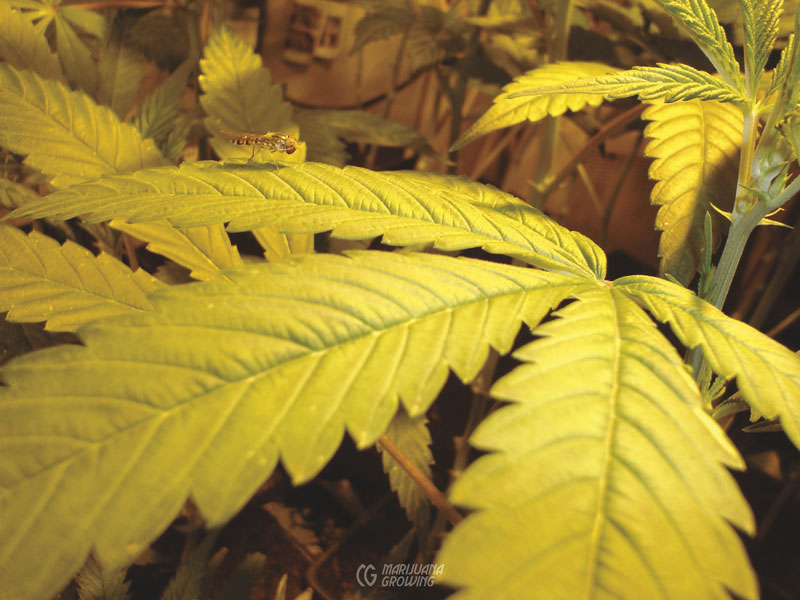
Beneficial wasp hunting for prey
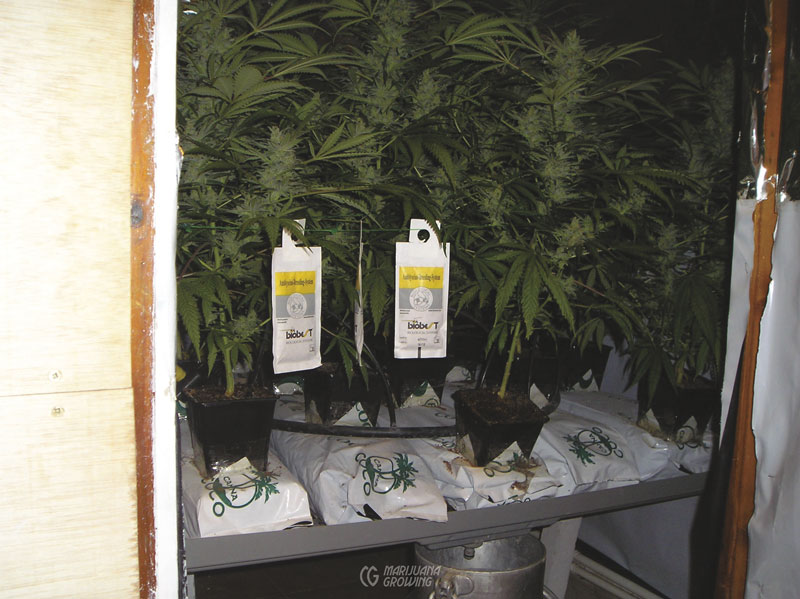
Beneficial insects being released
Green and Brown Lacewings
Lacewings lay their eggs at the end of long stalks, probably to protect them from ants and other lacewing larvae. The larvae of both green and brown lacewings are alligator-like with sickle-shaped mandibles. Adult green lacewings are approximately 0.75 inches (19 mm) long and pale green, with large copper-colored eyes. They are attracted to lights at night, and can produce a noxious odor when handled. Brown lacewing adults are tan or brown and about half the size of green lacewing adults.
Green lacewing larvae (aka aphid lions) attack and consume large numbers of aphids, mites, lace bugs, and other small insects. Pollen, nectar, and even honeydew sustain the generally more passive adults.
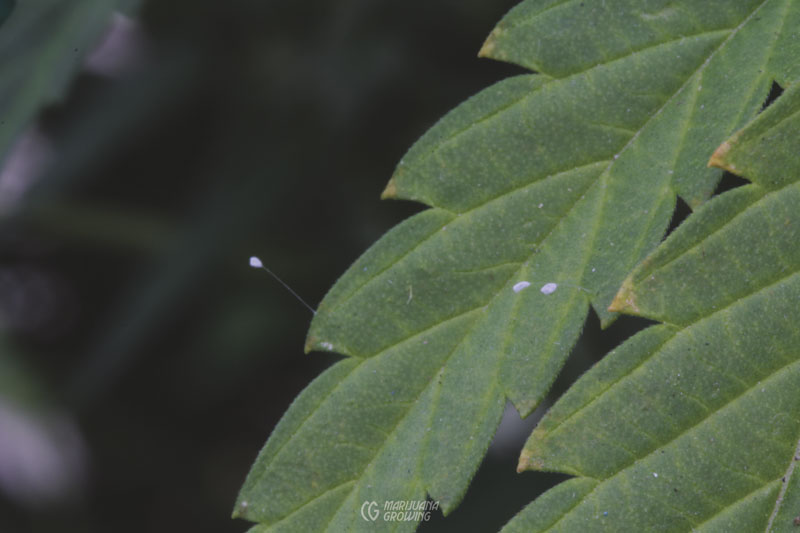
Lacewing eggs on a long stock (MF)
Spiders
Spiders, including the green lynx, have no antennae. They have two body parts, eight legs, eyes, mouth, and an abdomen, which contains the digestive organs, genitals, and spinnerets. More than 3,000 species reside in North America. Most spiders have venom glands but rarely bite people. Brown recluse and black widow spiders and a few others bites can be fatal to humans.
Spiders are the most abundant group of predators found in gardens. They feed on insects typically caught in a web. Jumping spiders and wolf spiders are active hunters. Crab spiders ambush their prey.
There is a long list of predators below that you may find in your outdoor garden. Attract predators by gardening organically. Avoid using pesticides or fungicides. Spot spray if necessary.
Praying mantis (Tenodera sinensis) big-eyed bugs dustwings fly parasites (mixed species) fungus gnat predators (Hypoaspis sp.) green and brown lacewings ground beetles hover flies (syrphid flies or flower flies) lady beetles, ladybird beetles (ladybugs) mealybug destroyers (Cryptolaemus montrouzieri) minute pirate bugs parasitic flies parasitic wasps (Trichogramma wasp) pirate bugs (Orius sp.) predaceous stink bugs predatory nematodes “Double-Death Mix” (Steinernema / Heterorhabditis mix) predatory spider mites, Neoseiulus (Amblyseius) californicus, Mesoseiulus (Phytoseiulus) longipes, Phytoseiulus persimilis, Neoseiulus (Amblyseius) fallacius, Galendromus (Metaseiulus) occidentalis, and Galendromus (Typhlodromus) pyri predatory wasps, Ichneumonoidea wasp soldier beetles spider mite destroyers (Stethorus punctillium) tachinid flies thrips predator mites (Amblyseius cucumeris) whitefly parasites (Encarsia formosa) whitefly predators (Delphastus pusillus).
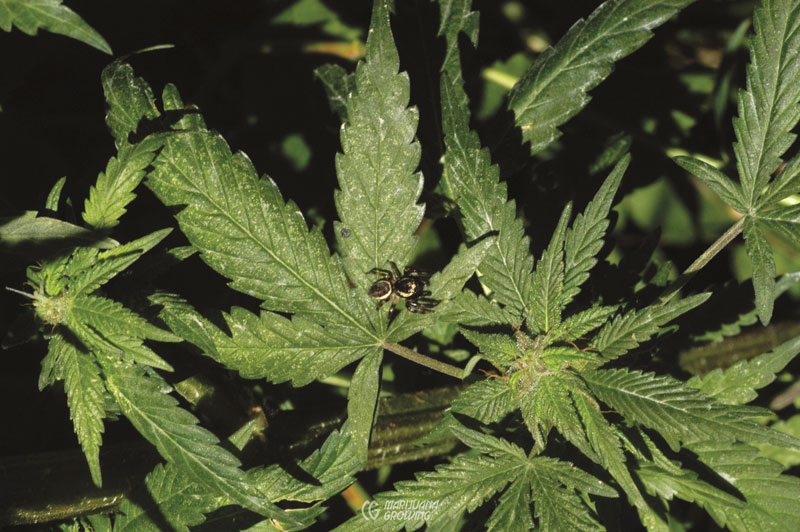
Spider on the prowl for prey
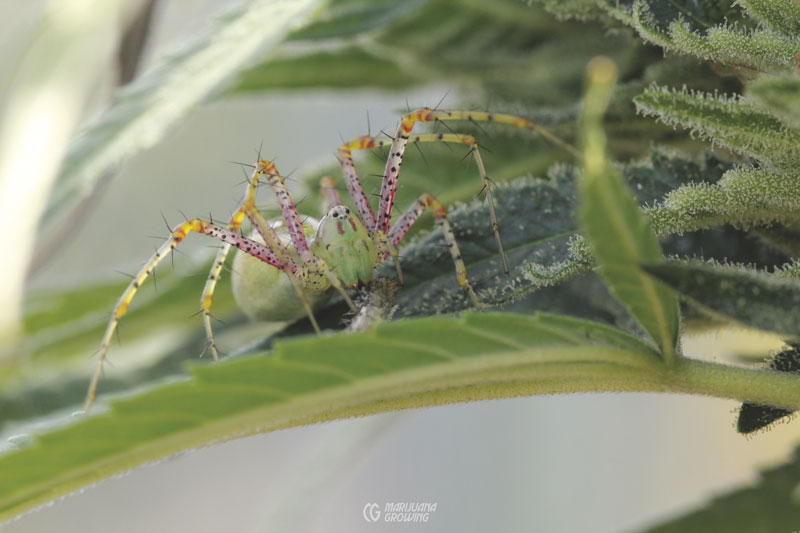
Green lynx spider (MF)
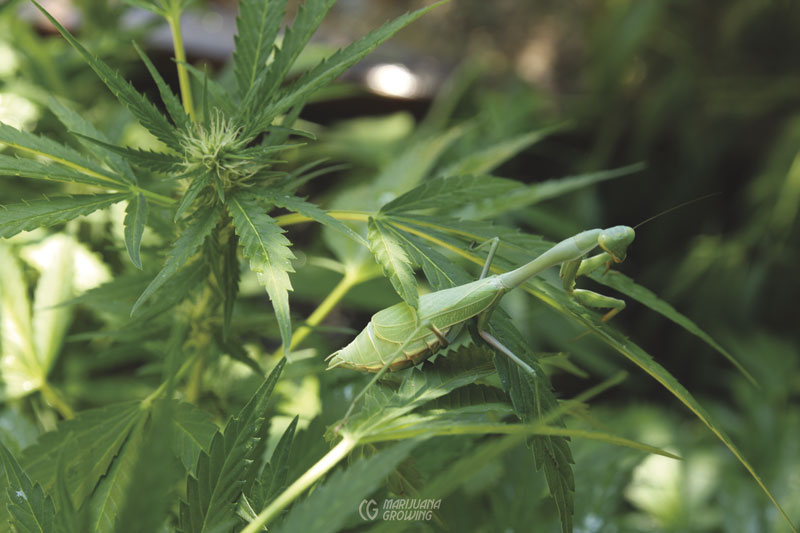
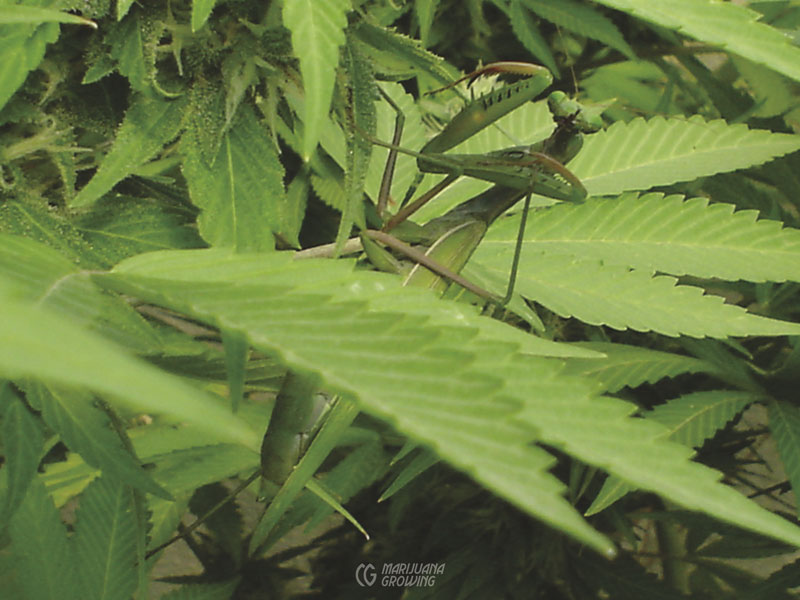
Praying mantis eats all insects and mites (MF)
Frogs and Toads
Frogs and toads eat insects and slugs. The frogs will need a water source, while toads are more terrestrial. Large snakesin the garden will eat gophers, squirrels, and mice as well as moles and shrews. Snakes can give you a good scare if you come across one unexpectedly! The snake will also want to eat your frogs. Plan carefully before committing to any mini predator to solve pest infestations.
Frogs, toads, snakes, and other reptiles are extremely sensitive to pesticides, fungicides, and other chemicals. To attract these beneficials, avoid using chemicals and minimize all control sprays the garden.
Troubleshooting
Simple troubleshooting will solve 90 percent of the problems encountered when growing cannabis. The first, keep the growing area clean all the time. Remove all trash and dead foliage on growing medium and in the garden. They are the source of contamination and provide habitat for interlopers.
Is the problem cultural or caused by diseases or pests. Normally cultural problems lead to disease and pest issues. If there is a cultural problem, you can check the symptoms and examples in chapter 21, Diseases & Pests, “Common ‘Nutrient’ Problems.”
The disease or pest should be identified. In many cases insects in the garden are beneficial. Once diseases start causing plant damage they become a problem. Look for plant damage carefully. Check foliage for damage, check stems and soil for damage and strange growth. Take a close up photo of the disease or pest and compare it to the images in this chapter for a match. Find the closest match and follow control measures outlined in this chapter.
Less disease and pest damaged is suffered when plants are healthy. Diseases and pests always attack weak plants. Check slow-growing plants extra for problems.
Set out yellow and blue sticky traps to monitor flying insect populations. Most problems occur after plants are two months old.
Always use the least toxic means of control first.
Unexplained Problems
Abiotic diseases
Diseases from abiotic (nonliving) causes often arise suddenly. They usually resemble diseases caused by living organisms. Plants that suffer stress are more susceptible to diseases and pests. Nutrient deficiencies are also a major problem.
Pollutants take their toll. Sulfur dioxide, for example, can cause interveinal leaf chlorosis. Hydrogen fluoride causes chlorosis. Ozone and other air pollutants, nitrous oxides, and so forth all do great damage.
Sprays and Spraying
Spreader-Stickers
Many products already contain a surfactant, surface-active substance (adjuvant), which enhances the effectiveness of foliar fertilization.
Spreaders (wetting agents) reduce the surface tension of sprays and keep them from beading up and rolling off the foli-age. Big, bulbous drops on leaves mean you need to use a spreader. Flat drops that slide off the foliage mean there is too much spreader. There are nonionic, anionic, and cationic spreaders. The nonionic spreaders that do not ionize in water are the most common, and they do not react with most pesticides. Anionic and cationic spreaders are not used often.
Stickers are designed to help spray adhere to the leaf, so it does not wash off when it rains or when dew forms. But research proves that direct laminal translocation (through the surface or cuticle of the leaf [lamina]) is the only option. Stickers also have the ability to seal off stomata—not a good idea. They also slow evaporation and impart a waterproof coating. Some stickers are spreaders, too. Organic stick-ers include yucca extract, fish oil, fatty acid soaps, and emulsified soybean oil.
Extenders (stabilizing agents) protect applied sprays against the UV radiation and heat that degrade sprays. But the nutrient will only move in as long as it is in solution. The amount of time under normal conditions would make the use of extenders pointless, as it will take longer to affect the nutrients by UV than the water will (or should) remain on the leaf.
Liquid soaps make an excellent spreader or water tension breaker (surfactant). I use Ivory or Castille liquid soap at the rate of 2 drops per gallon (3.8 L) and it works perfectly. No need to spend extra money on commercial products! Use only natural soaps with no weird additives. Professional greenhouse com-mercial growers use Tween 80 because it does not react with other elements in solution.
Application
1. Spray foliage with a fine mist, and do not create droplets on the leaves. Fine mist is electrically attracted by the foliage. Even young cannabis plants have waxy hairs that impair liquid penetration.
2. Do not spray plants that are hot or when the atmosphere is too dry. Spray in low light, either before the lights go off or just as they are com-ing on. If spraying in hot conditions first spray everything with plain water until the temperatures of the room and foliage drop, before applying the real spray. Spraying when the plant foliage is hot causes the spray to crystallize on the surface, which stops the penetration. Spraying with water ten minutes afterward often increases the penetration. Mobile nutrients move freely within a plant. Immobile nutrients move slowly, but once deposited, they stay.
3. Apply mobile nutrients sparingly. Immobile nutrients—sulfur, boron, copper, iron, manganese, molybdenum, sulfur, and zinc—often require two or three applications. Calcium and boron are poor candidates for foliar feeding because they translocate poorly. But urea nitrogen applied as a spray in high humidity penetrates almost instantly into leaves. Be careful when spraying urea-based fertilizers, and keep them diluted. Urea also carries other nutrients into the plant and works well for a base to the mix. Foliar feeding should turn the plant around in less than a week. A second spray could be necessary at week’s end to ensure that the cure sticks.
4. Boron, calcium, and iron move slowly during flowering. A supplemental foliar dose often speeds growth when it slows. A foliar spray of potassium can also help flowering, especially if the temperatures dip below 50ºF (10ºC) or above 80ºF (26.7ºC).
5. Always spray new growth. The thin, waxy layer and a few trichomes allow for good penetration.
6. Measure the pH of the spray, and keep it between 7.0 and 8.5. Potassium phosphate (K2HPO4) becomes phytotoxic below pH 4.0 and above 8.5. Stomata are signaled to close within these pH ranges.
7. Use a surfactant with all sprays, and apply these as per the instructions on the label. Add the proper amount of surfactant so droplets do not form on the leaves. Once formed, droplets roll off the foliage, rendering the spray ineffective.
8. Stop the application before droplets form on the leaves. Make a test spray on a mirror to ensure that the spray is even and does not form droplets that roll off the mirror.
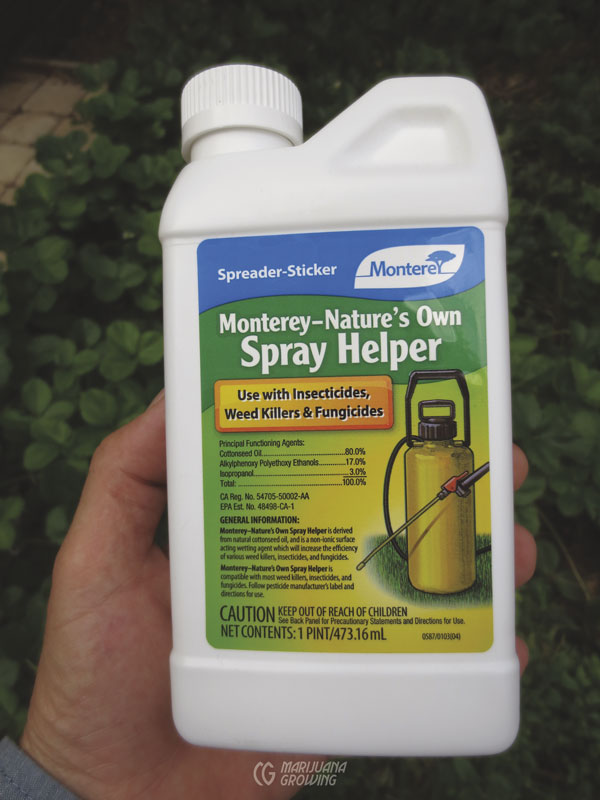
Spreader-stickers help keep sprays in place so they are effective.
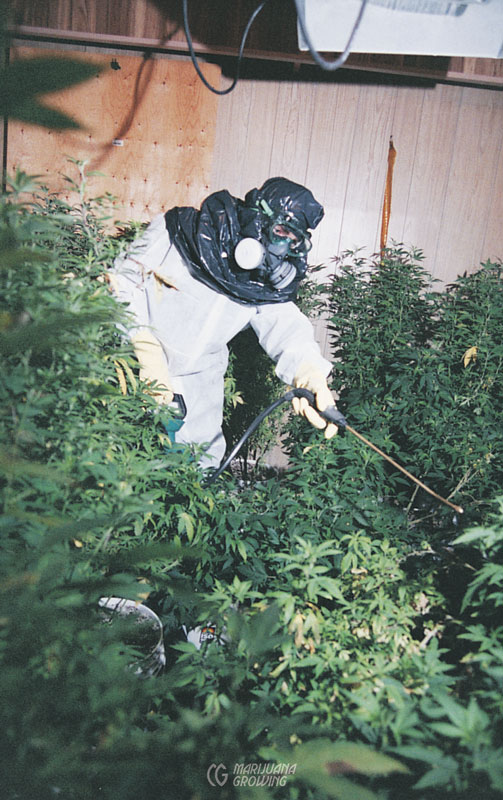
Protect yourself from all garden sprays indoors and outdoors
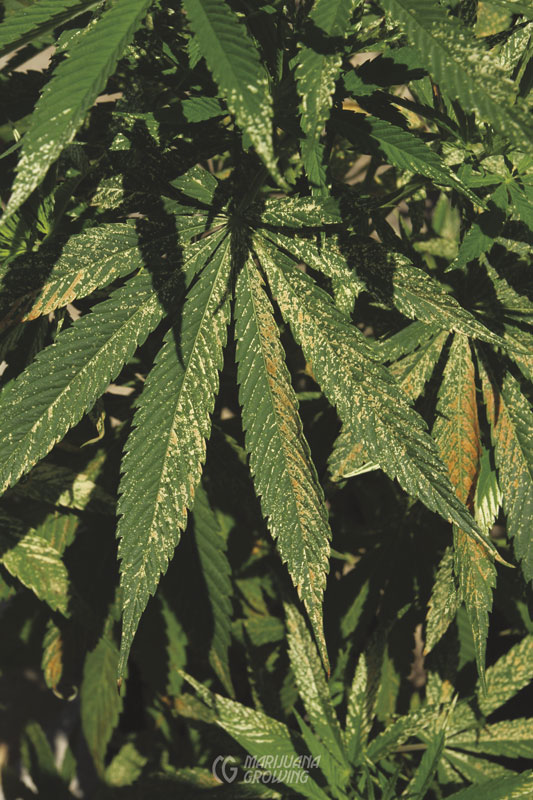
Phytotoxicity caused by spray on leaves (MF)
Fungicide and Pesticide
Application Basics
Use only contact sprays approved for edible fruits and vegetables.
Warning: DO NOT USE TOXIC SYSTEMIC CHEMICALS! Read the entire label on all sprays. The toxic or active life of the spray is listed on the label. Wait twice as long as the label recommends, and thoroughly wash any foliage before ingesting it. Toxic life is many times longer indoors, because sunlight and other natural forces are not able to break down chemicals.
Sprays are beneficial if not overdone. Every time a plant is sprayed, the stomata are clogged and growth slows. At 24 to 28 hours after spraying, rinse leaves on both sides with plain water until it drips from leaves. Avoid sprays that leave a residual during the weeks before harvest. Spraying increases chances of gray (bud) mold once dense buds form.
Phytotoxicity is the injury to plants caused by sprays. Symptoms include burned leaves, slow growth, or sudden wilt. Spray a test plant and wait a few days to see if spray is phytotoxic. Water plants before spraying. Phytotoxicity is diminished when more liquid is in foliage.
Temperatures above 68ºF (20ºC) make virtually all sprays, even organic ones, phytotoxic and damaging to foliage.
Intense light causes leaves to take in the chemicals too quickly and will often cause leaf damage.
Spray early in the day so ingredients are absorbed and foliage dries. Spraying two hours or less before lights-out can cause foliar fungus when water sits on leaves for too long.
Do not mix two products. It could change the characteristics of both.
Warm temperatures mean spraying twice as often, because bugs breed twice as fast.
Use a clean, accurate measuring cup or spoon. Measure quantities carefully!
Mix pesticides and fungicides just before using them, and safely dispose of leftovers. With soil active sprays (sprays that leave an active residue in soil), precautions should be taken to avoid overapplication. Spray applications require more attention to detail, because overspray material lands or drips onto the medium.
Remember that dosage equals concentration times volume (dose = concentration × volume).
Spray equipment: To assure proper spray volumes, your compressed air sprayer should be equipped with a pressure gauge and regulator. Your sprayer should be calibrated by determining the output of the chemical with the selected nozzle at the selected pressure within a specified time period. Using this information, you can apply a known amount of material to a known area. Spray droplet size also affects response, with smaller droplet sizes providing better coverage, but only up to a point. Many mist or fog type applicators do not provide adequate volume for coverage of plant stems and have not been effective when used with compounds like Bonzi*. Dramm makes one of the best application systems that is a cold fogger, but be advised that vapor applications such as thermal are also extremely effective and dangerous.
*Caution: DO NOT USE Bonzi on cannabis! Anyone doing so deserves to be arrested and jailed. And I mean any product (Dutch Master) that is sold to this industry is the same—deadly and persistent for years in the plant.
Sprenches are high volume foliar sprays that result in runoff into the media, providing a drench effect. Concentration levels are lower than those recommended for sprays.
Powder applicators require a little more skill to use. The powder is dispersed in a fog around plants so that it adheres to foliage. Powder applicators work best when there is no wind and there is plenty of room around plants to use the device. Always wear a protective mask, goggles, and gloves because the powder tends to go everywhere.
Soil drenches are easier to apply uniformly than sprays because the drench volume is easily measured, and when applied to moist media, it is easy to obtain good distribution in the media. In general, apply four ounces of drench solution to a six-inch “azalea” pot, and that volume is adjusted up or down with pot size to obtain a volume where about 10 percent of the solution runs out the bottom of the pot when the media is moist.
Chemigation or application through the irrigation system: In flood (subirrigation) or drip irrigation, the nutrient, additive, or organic agent can be added to the nutrient tank like a water-soluble fertilizer. This process is also called “watering in.” Many products are recommended to be injected into the irrigation water and can often be applied at very low rates of active ingredient when irrigating.

Hand-pump sprayer for small jobs
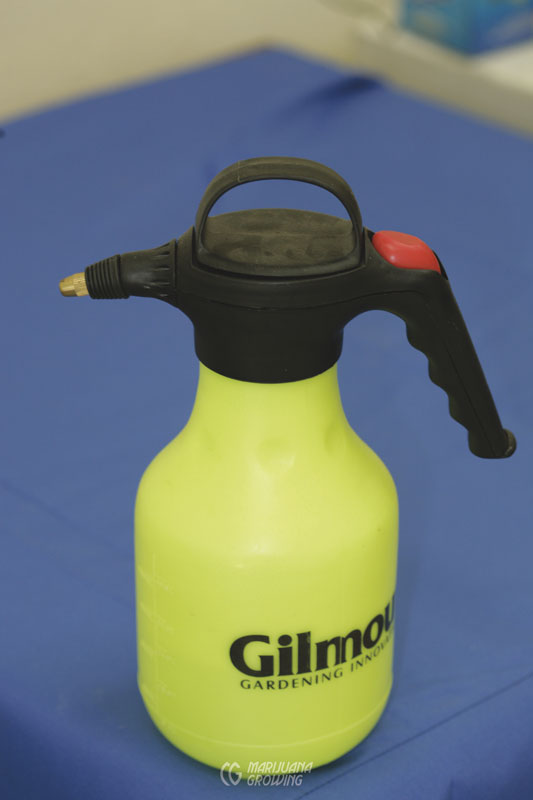
Pump-up hand sprayer for small gardens
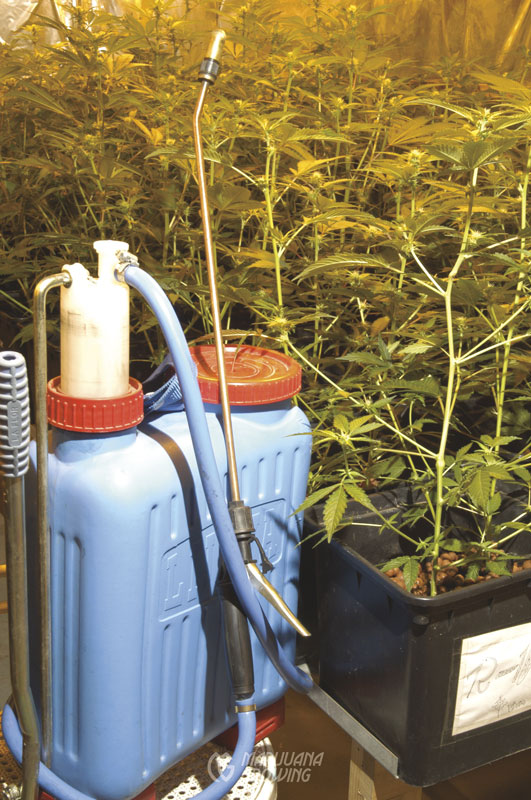
Pump-up sprayer for large gardens
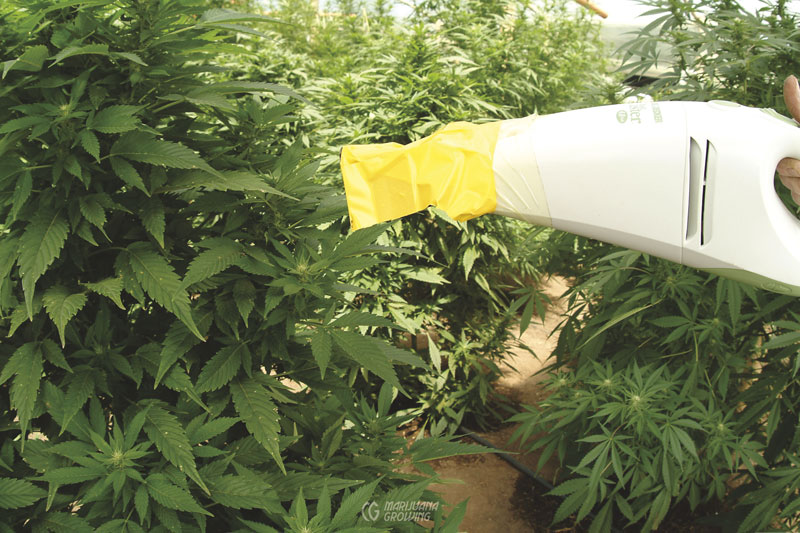
Hand fogger for powders
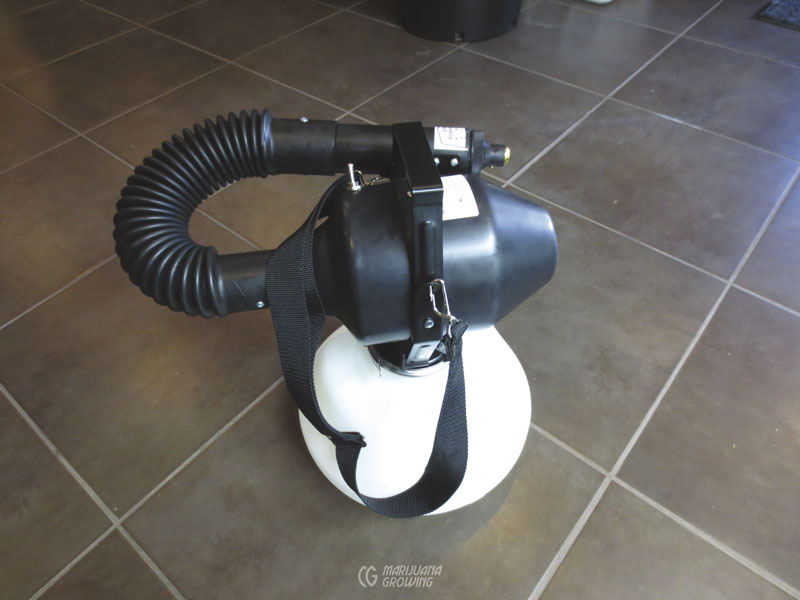
Electric fogger for larger gardens

